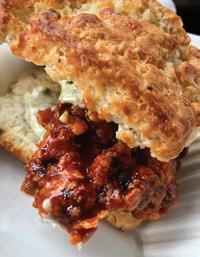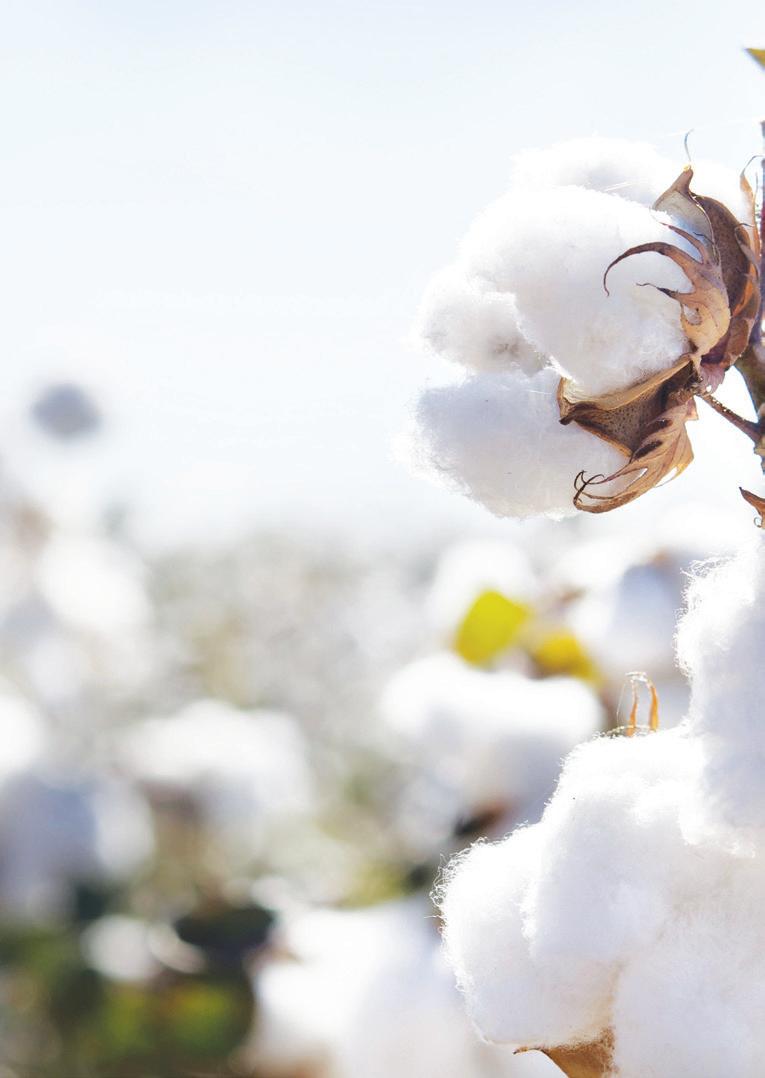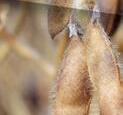










FEBRUARY 28 & MARCH 1























































































































FEBRUARY 28 & MARCH 1











































































































1:30 p.m.
Southern Cotton Ginners Association and Foundation Annual Meetings, Venetian Room.
Presiding: Jeff Lindsey, Southern Cotton Ginners Association President Welcome and National Update: Larry Black, National Cotton Ginners Association President Trade Impacts on US Commodities: BRICS, Outlook and Marketing Management, Ryan Loy, PhD, University of Arkansas
Weather Prediction Technology for Agriculture and Weather Outlook for 2025. John Baranick, Ag Meteorologist, DTN Integrating Gin Technology for the Farmer and Ginner. Jonathan McBride, Bogue Chitto Gin, Macon, Miss., and Rich Lindsey, Jr., Cherokee Gin and Cotton Company, Centre, Ala.
Ag Achievement Award
Lewis Rone, Rone Farms, Portageville, Mo.
Christopher Daubert, Vice-Chancellor & Dean of the College of Agriculture, Food & Natural Resources, University of Missouri
Cotton Gin Service Award
Mitch Billigsly, B & B Lint Cleaners Service - In memorium and Henry Giompoletti, Giompoletti Gin Repair
6:30 p.m. Honors Reception, Peabody Forest Ballroom, — Sponsored by Memphis Tourism. All Association members welcome (Tickets for reception and banquet must be purchased in advance.)
7:15 p.m.
7:30 a.m.
Honors Banquet, Peabody Continental Ballroom. Sponsored by Bayer, Martin Specialty Products and Signode. All Association members welcome. (Tickets are required.)
I Honoring Ginner of the Year, Allen Espey, Epsey Gin Co., McLemoresville, Tenn.
I SCGA Memorial Scholarship Honoree, John Edmonston, Edmonston Gin Co., Hornersville, Mo.
I The A.L. Vandergriff Cotton Pioneer Award: U.S. Senator John Boozman, (Arkansas)
Shuttle bus service from Peabody, to the Renasant Convention Center begins.
255 North Main Street
8:30 a.m. AG Outlook Meeting, Cannon Center Stage
lPresiding: Jeff Lindsey, Southern Cotton Ginners Association President lCotton Issues: Patrick Johnson, Jr., Chairman National Cotton Council
lOutlook for U.S. and World Cotton; Joe Nicosia, Trading Operations Officer, and head of the Cotton Platform for Louis Dreyfus Company, Executive Vice President of Louis Dreyfus Company LLC., Cordova, Tenn.
9:00 a.m.
11:00 a.m.
MID-SOUTH FARM & GIN SHOW OPENS
Mid-South Agricultural Trade Conference, Room 115 Level 1 Lobby
The 2025 Mid-South Agricultural Trade Conference seeks to inform farmers, agribusinesses, and agricultural leaders in Tennessee and the Midsouth about the role and significance of international trade on local agricultural production, global markets and economies, as well as increased awareness of agricultural exporting tools and resources. Experts on trade as well as State and National commodity leaders will provide context on today’s changing trade landscape.
2:00 p.m. Mid-South NAMA Student Competition, Room 102A Level 1 Lobby
2:30 p.m.
Integrating Gin Technology for the Farmer & Ginner, Room 109 Level 1
Hear discussions, challenges and success stories for ginners, farmers, ag equipment dealers and others
3:00 p.m. MSU Alumni Reception, Room 103 Level 1
5:00 p.m. MID-SOUTH FARM & GIN SHOW CLOSES
7:30 a.m. Shuttle bus service from Peabody to the Renasant Convention Center begins.
255 North Main Street
8:30 a.m. AG Outlook Meeting, Cannon Center Stage, Sponsored by Bayer
lPresiding: Jeff Lindsey, Southern Cotton Ginners Association President lGrain Market Outlook/Marketing Strategies/Projections for 2025: Richard Brock, Richard Brock Associates, Milwaukee, Wis., will provide a grain market outlook and his unique insight into grain marketing and the challenges farmers will face in the year ahead.
Special $500 Cash Attendance Prize. The prize will be awarded at the end of the seminar. Must be present to win.
11:00 a.m. SCGA Safety Award Luncheon, Room 114 Level 1
9:00 a.m. MID-SOUTH FARM & GIN SHOW IS OPEN
12:30 p.m. Rice Marketing Educational Seminar, Room 101 Level 1 Featuring Milo Hamilton, Firstgrain, Inc., and John Anderson, Rice consultant for Firstgrain, Inc. Rice rules of thumb may not work so well in 2025. Is the price of rice shaking your world? Is the cost of growing it shaking your world? This workshop looks at the rice price as trapped between uncertain input costs and other factors you may never have thought about before. Milo and John are here to help you sort through your new crop rice price outlook.
1:00 p.m. 4-H Mid-South Food Pantry Competition, Room 105-108 Level 1 4-H members will compete in a food challenge at the Mid-South Farm and Gin Show to demonstrate their knowledge and skills as it relates to preparing a healthy meal with items commonly found in a local food pantry. The contest will emphasize limiting food waste, food efficiency, and healthiness of a meal. Attend the award ceremony to see the winning recipes and the top three 4-H Chopped teams!
4:30 p.m. MID-SOUTH FARM & GIN SHOW CLOSES
9:00 p.m. The Jamboree (Adults only, please) Everyone Welcome! Cash Bar. Brought to you by Jamboree Sponsors: Agriculture Guaranty, AZA Import & Export Co., Bank First, Barnhardt Natural Fibers Group, Chem-Cotton, Egon Keller, Inc., Indianola Electric Co, Langston Companies, Inc, Lubbock Electric Co., LLC, Lummus Ag Solutions, McCleskey Saw & Machine, MTS Kimbell, Olam Agri, Planters Cotton Oil Mill, Samuel Packaging, Signode, Square Weber, LLC, Tannehill Industries, Vandergriff American
For more information: www.farmandginshow.com
Special Note: Exhibits, exhibitor information, and seminars from the 2025 Mid-South Farm & Gin Show will be available for registered attendees on-demand at the Mid-South Farm & Gin Show Virtual Show Site


LOWER LEVEL EXHIBITS - CONCESSIONS
LEVEL 1 EXHIBITS - MEETING ROOMS - CONCESSIONS
LEVEL 2 EXHIBITS - CONCESSIONS



Sponsored by Southern Cotton Ginners Association Southern Cotton Ginners Foundation and Delta Farm Press



Adams Welding & Millwright .....................1126
Ag Technology Solutions Group ..................1106
Arkansas Propane Education and Research Council .....................................1024
Cajun Kooling Outdoor Cooling Fans ..........1301
CC Diesel Performance & Tuning LLC ..........1226
Certi-PIK USA .............................................1012
Condor Metal, LLC ......................................1327
Cutco Business Gifts ...................................1309
DT550 FRICTION REDUCER ..........................1127
Duck Tote ...................................................1210
Ecodrum Composter ...................................1206
EzeWrap .....................................................1319
Farm Credit ................................................1203
Fortify Building Solutions ..........................1000
Get Wet Irrigation Engines, Inc. ..................1119
Ignited Digital Marketing ...........................1303
Kuchar Combine Performance, Inc. ............1018
Kwan Safaris ..............................................1322
Leaf Guard..................................................1307
Limb Beaver LLC .........................................1316
Luttrell Belting ...........................................1315
Martin Till ..................................................1107
MidSouth Plastics.......................................1224
NACHURS ...................................................1007
Parman Energy Group ................................1021
PERKINS SALES INC.....................................1308
Planter-Tech Solutions LLC .........................1113
ProGro Bio ..................................................1313
Propel Sliding Door Automation ................1027
Rovensa Next .............................................1003
S&K Packaging ...........................................1125
Schlagel Manufacturing .............................1009
Seametrics .................................................1325
Southern Chics ...........................................1209
STOR-LOC ...................................................1006
T&B Welding & Trailers, LLC ........................1215
TANNEHILL- Mi-T-M HOT WATER WASHERS - AIR COMPRESSORS / VAL 6 HEATERS.........................................1103
Thompson Machinery ................................1013
Ab Jewelry .................................................2112
Alabama Mountain Lakes Tourist Association ..............................................2207
Bruces leather belts ...................................2007
Buckup Drone Recovery/Aerial Edge..... .....2211
Continental-Pipe ........................................2201
Cotton Museum, Inc. ..................................2114
Directpivotparts.com .................................2210
Enforcer One, LLC. ......................................2002
Fairbanks Scales Inc. ..................................2107
Farmer’s Daughter ......................................2205
Hess Shoes .................................................2202
LeafFilter Gutter Protection ........................2014
Legacy Gin Saws ........................................2016
Legacy Steel Building (Quonset / Roundtop) ..............................................2015
Next Gen Tuning and Diagnostics ...............2208
Peco Foods .................................................2108
PICKSMART ................................................2100
Quality Craft Tools ......................................2104
Redfern Enterprises Inc. .............................2013
Rustic Tennessee Cowhide Boutique & Décor...................................................2212
Simply Steel Metal Designs ........................2110
The Cotton Store ........................................2200
Topline Enterprises .....................................2005
Truck Care Chemical & Supply, LLC. ............2009
Unique Art by Floyd ...................................2003
4S&J, INC....................................................3379
Abilene Machine LLC ..................................3684
ADM ...........................................................3310
Advanced Drainage Systems, Inc. ..............3465
Ag Express Electronics ................................3572
Ag Spray Equipment ..................................3202
Ag Spray Equipment ..................................3927
Agrijewelry.com .........................................3462
AgroEcoPower ............................................3513
Alliance Ag Equipment ...............................3602
AMADAS Industries, Inc. ............................3156
Arcot Industrial Manufacturing ..................3355
Ascenco Tires North America ......................3046
BAJAJ
Little Bales of Cotton ..................................3913
Lummus Ag Solutions ................................3550
Martin Specialty Products ..........................3677
McCleskey Saw & Machine .........................3565
Michelli Weighing and Measurement ........3436
Mid-South Ag Equipment, Inc. ...................3562
MirTech Harvest Center ..............................3642
Mississippi Agriculture & Forestry Museum ...................................3908A
Mississippi Department of Ag and Commerce/ Genuine MS ...................3908
Monosem ...................................................3402
Montana Post Driver ..................................3270
Monty’s Plant Food ....................................3585
MSP Diesel Solutions..................................3284
MSU/Ag. & Bio. Engineering ......................3383
MTS Kimbell ...............................................3334
My Yield Seed Treaters ...............................3762
Nammco ....................................................3424
Newton Crouch Co ......................................3162
Nutrien Ag Solutions ..................................3345
Owens Marketing LLC - APV .......................3324
Owens Marketing LLC - Indutar ..................3426
Owens Marketing LLC - Lemken .................3326
P & P Marketing / J & M Mfg / Southern Sales Group ..............................3375
parallelarmexchange.com ..........................3315
PipeBreakUSA ............................................3785
Powerlift Hydraulic Door of Tennessee .......3557
Quail Forever ..............................................3418
Rea Agri Service .........................................3583
Redball .......................................................3517
Riceland Foods, Inc.....................................3454
Rolling Thunder Game Calls .......................3050
S.I. Distributing ..........................................3464
Samuel Jackson, Inc. ..................................3662
Samuel Packaging Systems Group .............3502
SBCotton ....................................................3930
Schaeffer Oil / Melvin Morris ......................3329
Scoular .......................................................3578
Shivvers Mfg., Inc. ......................................3673
SHOUP MFG CO...........................................3218
Signode ......................................................3318
Simplot Grower Solutions ..........................3142
Sm Fab Inc..................................................3553
Southern Application Management ...........3528
Stover Equipment Co. .................................3042
System Scale ..............................................3371
tCotton by TSW Automation, Inc. ...............3302
The KBH Corporation ..................................3012
The Kelly Group ..........................................3234
The Reluctant Beekeeper ...........................3902
Timac Agro USA..........................................3256
T-L Irrigation ..............................................3461
Tripak Superlubricants Inc. .........................3576
Triple J of Mississippi Inc. ...........................3442
Tri-State Truck Center Inc. ...........................3542
Tru-Pick, LLC ...............................................3918
TTQ USA .....................................................3674
Turnrows Apparel .......................................3906
Tyson Foods Local Grain Services................3410
USDA, AMS Cotton & Tobacco Program ......3249
Valent BioSciences .....................................3366
Valley View Agri-Systems ...........................3378
Vandergriff American/Sowega MFG ...........3401
Vantage Mid South ....................................3884
Vantage South ...........................................3923
Vaughn Electric Company...........................3351
Vive Crop Protection ...................................3150
Whiting Systems, Inc..................................3456
Wildfong Enterprises LTD ...........................3327
Wildwood Cotton Technologies ..................3306
Wilger Inc. ..................................................3246
Wind Crafts - The Flag Shop .......................3911
XAG Drones Advance Agriculture
Vantage South .........................................3926
811 Call Before You Dig ..............................4029
ACSA International Cotton Institute ...........4112 AgAmerica .................................................4201
AgHeritage Farm Credit Services ................4138
Agri Drone Solutions ..................................4334
Agri Placements International ...................4100
Agricenter International .............................4239
AgroLiquid .................................................4011
American Legacy Land Co. .........................4316
American National Insurance Company .....4013
Aquarius Farm Controls - Applied Digital Inc. ..............................................4208
Arkansas Rice .............................................4141
Arkansas Soybean Promotion Board ..........4135
ARVA INTELLIGENCE ...................................4323
ATA .............................................................4117
AZA Import & Export Co., LLC. ...................4131
Baker Implement Company .......................4226
Banyon Game Calls ....................................4317
Beck’s .........................................................4229
Benchmark AG Partners .............................4219
BAG COMPANY
Goanna Ag .................................................4304
Hill Manufacturing Company, Inc. ..............4030 Holganix Midsouth.....................................4214

Honestly Beef .............................................4331
Indeco Products, Inc. ..................................4337
Koch Agronomic Services ...........................4218
LiQuiTube Total Tire Protection ...................4303
Louisiana Master Farmer Program .............4113
MetLife Investment Management / Agricultural Finance ................................4225
Metos by Pessl Instruments .......................4321
MidSouth Ag Source LLC ............................4211
Mississippi Land Bank ................................4341
MSU/Ag. & Bio. Engineering-Educational...4028
Mueller, Inc. ...............................................4244
National Cotton Council .............................4114
Nichino.......................................................4111
Nitrogen Sealing Systems ..........................4237
On Point Realty ..........................................4332
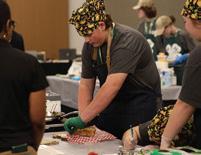
One Grower Publishing ..............................4035
Power Cleaning Equipment ........................4145
PPF Gin & Warehouse, LLC..........................4219
Primrose Oil Company, Inc. ........................4104
Prinsco .......................................................4318
ProAg .........................................................4300
Properly Marked.........................................4133
PSI Power, Inc.............................................4215
PumpTrakr ..................................................4325
Purple Wave Auction ..................................4109
QLF Agronomy ...........................................4328
Reeds Farm Drainage .................................4115
Root Cause Podcast and Financial Services 4212
SePRO Ag ...................................................4014
Simmons Bank ...........................................4039
Small Town Properties and Real Estate ......4130
Southern Drone OPS...................................4310
Spraytec Fertilizers .....................................4232
Stalk Knockers ............................................4005
Staplcotn....................................................4024
Stine Seed Company ..................................4124
Sure Crop....................................................4314

TeeJet Technologies ....................................4125
Tennessee Department of Agriculture ........4019
Tennessee Soybean Promotion Council ......4021
Tex-Trude ...................................................4336
Titan Ag .....................................................4205
Triangle Insurance Company ......................4025
Tri-States Grain Conditioning, Inc. ..............4308
UMB Bank ..................................................4106
University of Tennessee - Institute of Agriculture ..........................................4119
USA Rice .....................................................4139
USDA NRCS .................................................4301
USDA/Office of Hearings and Appeals/ National Appeals Division ........................4001
UT Martin Agriculture ................................4101
VISERION GRAIN LLC ...................................4015
Waterhole Apparel Co.................................4339
Waters Agricultural Laboratories, Inc. ........4108
Watkins & Sons Mfg., Inc............................4344
Zerk Zapper Tool .........................................4311
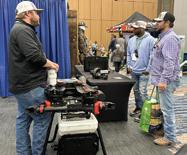


BY TIM PRICE
Mid-South Farm & Gin Show Manager
It seems like we’re in a never-ending cycle of uncertainty. Weather, government, exports, income, farm policy, are a few of the changes we’re facing. There is so much change coming at us – all the time – that we can become overwhelmed.
It seems like we can’t get away from it. We see it in our emails and texts, hear farm broadcasters talk about it, and we get updates from our membership organizations. We’re entering the fourth year of declining farm income. Input prices are still high, while commodity prices are often lower. We have heard that many lenders are concerned about repayments and a fair number of farmers are concerned they won’t be able to finance their operating needs.
Surveys show that despite the challenges, farmers want to continue to make the world a better place for our children and grandchildren. And we want a vibrant agriculture for those who choose to be a part of it.
So, what do we do? We plant another crop.
I often wish I had a crystal ball or some kind of superhero insight into what future agriculture looks like. Is social media your crystal ball? There is no shortage of revolutionary practices and products, the shiny new equipment, or a Nebraska farmer’s TikTok feed showing others how he does it. It’s all available right on the phone you carry in your pocket.
I remember hearing from my childhood “don’t believe everything you read” or “don’t believe everything you hear.” Abraham Lincoln is famous for saying “don’t believe everything
you read on the internet.” I’m pretty sure that’s a paraphrase of a line in one of Lincoln’s speeches that has just come to light.
But it makes a point. A lot of our mental strain comes from trying to figure out what’s “real” versus “fake news.” A recent article on information overload included this “an abundance of information becomes an abundance of misinformation.”
The original Gin Show launched in 1951, as an educational exhibit and marketplace for the ginning industry. It was a place where farmers and ginners could gather accurate, relevant information and talk with peers about the challenges of the day. While many of the challenges have changed, our commitment to providing valid and valuable information remains.
This year is the 73rd year, now called the Mid-South Farm & Gin Show, and we continue to create space for educating farmers on critical issues, providing information on new practices, showcasing new machinery, products and services that can keep farmers updated with cutting-edge ideas, while offering many opportunities for networking.
Ag Outlook seminars feature forecasts for cotton, grains, the economy, and rice. On Friday, Joe Nicosia will talk all things cotton, giving his perspective on domestic and global markets for the year ahead. Saturday features Richard Brock who will cover the outlook for grains and the economy. Ag Outlook seminars begin at 8:30 AM, Cannon Center Stage.
Milo Hamilton and John Anderson will give direction on the rice markets and what to expect in 2025. That seminar will be
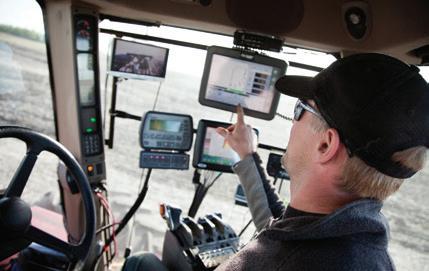

Saturday, beginning at 12:30 PM, in Room 101, Level 1 of the Renasant Center.
All have insight on the monumental changes ongoing in government and how that relates to agriculture. You don’t want to miss any of these seminars.
Knowing the issues to effectively communicate with state and federal lawmakers is on the schedule at this year’s Mid-South Farm & Gin Show. The Farm & Gin Show is happy to welcome again the Mid-South Agricultural Trade Conference on Friday, February 28 beginning at 11 AM in room 115 on the Lobby Level of the Renasant Center.
International trade, a top concern, for farmers will come into play with presentations by Former Underscretary of Agriculture, Ted McKinney, now President of the National Association of State Departments of Agriculture, and respondents will discuss the loss of international market share and needed responses.
Dr. Andrew Muhammad, professor of agricultural and resource economics at the University of Tennessee in Knoxville, along with representatives from other state universities, departments of agriculture, and Farm Bureaus around the Mid-South, will also discuss trade efforts in each state and nationally. The goal is to educate the public on global issues affecting agriculture, to provide a forum for relevant input and Q & A sessions on how to keep US ag competitive and viable in markets around the world.
Each year, I am impressed by the ideas, innovation and solutions-driven farmers and ginners who attend the Farm & Gin Show each year. These attendees show up in years of uncertainty and years of calm. They value the show’s
environment that prompts them to think ahead, ask hard questions, and have farmer-to-farmer and ginner-to-ginner conversations about change, how rapid it seems compared to just a few years ago, and how change can benefit their operations and our industry.
The show tries to have answers for the many questions on attendees’ minds. But, the reality is, we don’t have all the answers. What we do have is a place to have crucial conversations and find meaningful support from others. Sometimes the best information comes from learning how another farmer tackled a similar situation.
Last year, I mentioned the concept of radical resilience as the ability to endure, grow, and thrive through adversity. I am going to repeat Episcopal priest and researcher Alice Updike Scannell’s comments, because I think they are as relevant today as they were last year:
“We usually think of resilience as the ability to recover from an adverse experience and pick up our lives where we left off. It is that too.… But there are times when adversity permanently changes our reality, and we can’t go back to the way things were.…
Resilience then becomes the work of coming through the adversity so that, at least on most days, we see our life as still worth living. With this kind of resilience, we come through the adversity knowing that we’re still ourselves, even though things are very different for us now.”
This offers, in my mind, a realistic picture of agriculture and all we have been through the past several years. We go on, sometimes slogging through adversity and change. We plant another crop. It’s what we know, we do it well, and it provides a measure of stability in an increasingly instable world.
There are still many questions, and seemingly few answers. Right off the top of my head, these questions come to mind: what is the future for farm legislation? How will we address the significant loss of market share to Brazil? How can we continue to transition the farm to the next generation if we don’t have more certainty of markets and prices? How can we remain relevant while meeting the challenges of the day? There is so much change, everything is happening so fast - how do we go on?
Leadership expert John Maxwell said this -“Change is inevitable. Growth is optional.” Change requires us to, well, change, even with so much being beyond our control. If we deny the need to change, we’re stuck. If we try the same things and expect a different outcome, that doesn’t move us forward. Albert Einstein labeled that as insanity.
The one question that connects with nearly every topic we discuss is how do we futureproof the industry, so we won’t become obsolete in the future?
We plant another crop. We return to our roots and rely on the foundations of farming. We plant, and cultivate, harvest, and market. We connect with those we trust, those who have a history of providing accurate information. Extension agents, university scientists, certified crop advisers and certified agronomists, and others who are working with farmers and ginners to address new and different challenges. We attend conferences and trade shows to glean nuggets of information from industry experts and our peers. We attend the Mid-South Farm & Gin Show.
Maintaining connections in an uncertain world is critical. Relationships with family members, neighbors, agribusiness reps, members of ag organizations, civic groups, faith-based organizations, or those who regularly gather for coffee. The organizations themselves are important, but it’s the sense of community that helps us collectively deal with change.
The farmers I have known for years, who talked about their early farming careers, now tell me the main goal for their operation is to survive, and do and be better than previous year. Adopting a growth or continuous improvement mindset helps us see beyond the current crisis to a future where circumstances are better.
Change is inevitable, making changes will continue to be a growing challenge.
Toward the end of the 20th Century, businesses rapidly adopted computer technology. On the farm computers were used to track yields, input costs, grain sales, livestock marketed, and more. The internet paved the way for technology we once saw only in science fiction, on Star Trek, The Twilight Zone, Lost in Space, or The Jetson’s. Today, drones are used to scout crops and spot-spray weeds. Automated systems improve processes, reduce waste, and improve profitability. We don’t have flying cars (yet), but we do have many levels of autonomous machinery.
I think we’re on the cusp of significant artificial intelligence (AI) contributions to agriculture. We may see robots assist with research and data collection or take calls and manage emails. And while you may not use AI, you can bet those you do business with do. Many say AI will become one of the most important revolutions in agriculture.
We will have to see about that. What we know now is we can’t avoid change, we can’t control it, and it’s difficult to welcome, but we can learn to accept it as part of the journey.
A recent email resonated with me, especially in this time of uncertainty and change. It stated when we’re at the end of our own resourcefulness, when we are full of questions and out of answers, we seek certainty.
And so, we plant another crop. Our discipline to consistently put seeds in the ground, pray for favorable growing conditions, harvest and deliver crops to market, is an important part of the stability we have. We know when we plant another crop, we’re taking more steps forward, even if it is down an uncertain path.
The Mid-South Farm & Gin Show has been a constant in helping farmers, ginners, agribusiness, and others navigate instability. It’s the place where you can interact with those you do business with, and where you can find new products, services, technology, and equipment. The Farm & Gin Show is where you learn that one piece of market intelligence you couldn’t get anywhere else. It’s the place where you share a meal with long-time friends and new acquaintances. And don’t forget, the show is also the place of fun and family -- you have a chance to win a Labrador puppy or cold hard cash with thousands in cash prizes awarded daily.
The Mid-South Farm & Gin Show is where it all comes together, and it won’t be the same without you. Bring the family and join us February 28 and March 1 for the 73rd Annual Mid-South Farm & Gin Show at the Renasant Convention Center, Memphis. We can’t wait to see you at this year’s show!
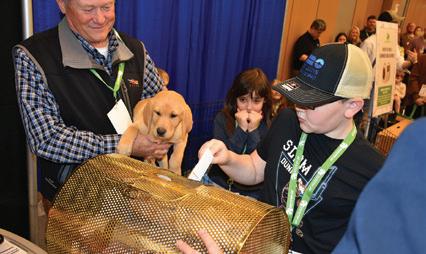
WHILE SOME OF the more than 300 companies at the 2025 Mid-South Farm & Gin Show are returning exhibitors - some going back to the first show 73 years ago - a host of new exhibitors will be at the show for the first time.
Tim Price, show manager, voiced appreciation for the support of those companies that have exhibited at the show year after year. “We sincerely appreciate their support and commitment to The South’s Premier Farm Show,” he says. “At the same time, we are very excited to welcome our many new exhibitors and the range of products and services they offer.
“The pace of change in today’s agriculture is rapid and a driving force in many of the products and services being offered by these new exhibitors. Farmers attending the show will have the opportunity to get a firsthand look at these new developments.”
There are more than 80 companies at the 2025 show that were not at the 2024 show. New exhibitors for the 2025 show include:
Ab Jewelry, Sheridan, AR; AgHeritage Farm Credit Services, Little Rock, AR; Agri Drone Solutions, Athens, AL ; AgroLiquid, St. Johns, MI; American Legacy Land Co., Monticello, AR; Arkansas Propane Education and Research Council, Jefferson City, MO; Ascenso Tires North America, Stow, OH; ATA, Jackson, TN; AZA Import & Export Co., Lubbock, TX; Banyon Game Calls, Millington, TN; Better Cotton Initiative, Genève, Switzerland; Bigham by Adams, Carlisle, AR; BigIron, St. Edward, NE; Bobby Henard Tire Co., Brinkley, AR; Bowen Equipment Co. LLC, Newport, AR; Brooks Custom Application, Houston, MS; Bruces leather belts, Smithville, MS; Buckup Drone Recovery / Aerial Edge, Huntingdon, TN; BW Fusion, Fort Wayne, IN; Caroline Taylor Jewelry, Brooksville, MS; CC Diesel Performance & Tuning LLC, Horace, ND; CENTRAL BAG COMPANY, Leavenworth, KS; CNC Performance Engineering, LLC., Huntersville, NC; Concept Industries Ltd., Winkler, MB; Condor Metal, LLC, Atoka, TN; Croptell, Hernando, MS; Directpivotparts.com, Saint Edward, NE; Ducks

Unlimited, Memphis, TN; EasyFarm - Vertical Solutions, Minot, ND; Enforcer One, LLC., Peachtree City, GA; EZ-Drops, Kirkland, IL; Fastline Marketing Group, Buckner, KY; Five Star Equipment & Auction Co, Sardis, MS; G&H Petroleum, Nashville, MI; Gen 3 Dynamics, Troy, OH; Get Wet Irrigation Engines, Inc, Pocahontas, AR; Gilland Ag Service, Elkton, TN; Goanna Ag, Waterloo, NE; Grain Systems Distribution, Vincennes, IN; Greenway Equipment, Weiner, AR; Honestly Beef, Magee, MS; Ignited digital marketing, Tupelo, MS; INCO Irrigation and AG Drainage, Union City, TN; Kagmo Electric Motor, Cape Girardeau, MO; Kisco Leasing Company, LLC, Haskell, TX; Koch Agronomic Services, Greenwood, MS; Kwan Safaris, Angleton, TX; Leaf Guard, Roanoke, VA; Legacy Steel Building Inc., Fargo, ND; Metos USA, Loxahatcheel, FL; MidSouth Ag Source LLC, Paris, TN; Mississippi Agriculture and Forestry Museum, Jackson, MS; Mississippi State University Geosystems Research Institute, Mississippi State, MS; MJP, Inc. – PipeBreakUSA, Middlefield, CT; parallelarmexchange.com, Remington, IN; Parman Energy Group, Olive Branch, MS; Planter-Tech Solutions LLC, Trumann, AR; PPF Gin & Warehouse, LLC, Cooper, TX; Prinsco, Earlham, IA; Propel SDA LLC., Delphos, OH; Quail Forever, St. Paul, MN; Redfern Enterprises Inc., Las Vegas, NV; Rolling Thunder Game Calls and Rogue Ammunition, Somerville, TN; Root Cause Podcast and Financial Services, Trenton, TN; S&K Packaging, East Dubuque, IL; Schlagel Manufacturing, Torrington, WY; Seametrics, Kent, WA; Small Town Properties and Real Estate, Flora, MS; Southern Chics, Calhoun City, MS; Spraytec Fertilizers, Urbandale, IA; Stalk Knockers, Randolph, IA; T&B Welding & Trailers, LLC, Lockwood, MO; Tech Solutions Group LLC, Nashville, TN; Tex-Trude, Channelview, TX; The Cotton Store, LLC, Gould, AR; The Reluctant Beekeeper, Hickory Plains, AR; TSW Automation, Inc., Nashville, TN; University of Tennessee - Institute of Agriculture, Middleton, TN; USDA NRCS, Little Rock, AR; Vantage Mid South, Carlisle, AR; Vaughn Electric Company, Union City, TN; Weihai EzeWrap New Material Co., Ltd., Qingdao, AL; Wildfong Enterprises LTD., Craik, SK
















JOHN ANDERSON is an expert in grain hedging with 30 years’ experience in rice marketing. He is a rice analyst at Firstgrain, an advisory service for the world rice industry. Prior to this role, he was the Senior Manager, Customer Development with rice buyers to adopt new technology in grain merchandising. Most of his career has been working with producers directly, buyers directly, and in management. John holds a Bachelor of Business Administration (B.B.A.) focused in Marketing/Marketing Management, General from University of Tennessee at Martin.
JOHN BARANICK, is an Ag Meteorologist, DTN. He graduated from Iowa State University with a BS in meteorology and a minor in agronomy. He has been a meteorologist with DTN since 2011. John uses his forecasts to comment on its impacts to different industries and helping customers make important business decisions. His comments have been received by clients in the aviation, transportation, energy, and agriculture industries worldwide.
LARRY BLACK is President of the National Cotton Ginners Association. His cotton ginning career began in 1981 when he joined Quanah Farmers Co-op in Quanah, Texas. He became assistant general manager in 1986, and in 1988, was named general manager. While in Quanah, he served on the city council for nine years and for seven years as mayor pro tem. He also served four years as chairman of the Quanah Economic Development Corporation. Larry was named general manager of the Central Rolling Plains Co-op in Roscoe, Texas in 2022. He is a past president of both Texas Cotton Ginners and Texas Agriculture Cooperative Council. Larry currently serves on the Texas Cotton Ginner’s Trust Board of Directors, the Nolan County Groundwater District Board, the Roscoe Collegiate High School STEM Advisory Board, the National Cotton Council Board of Directors, the US Cotton Trust Protocol Board.
RICHARD BROCK is Chairman of Brock Holding Company which is comprised of Brock Associates, an agricultural marketing advisory service and publisher of The Brock Report, established in 1980 and Brock Investor Services (futures and options brokers). The Milwaukee, Wisconsin-based firm has six offices and manages grain sales on approximately 800,000 acres throughout the U.S. and is an advisor on purchasing strategies for many large poultry, pork, dairy and food companies. Brock grew up on the family grain and pork farm in central Indiana. He received his Bachelor of Science Degree in Agricultural Economics from Purdue University and his master’s degree from Cornell University.
MILO HAMILTON has been CEO of Firstgrain since 2000. Firstgrain is an advisory service for the world rice industry. For nearly 20 years at Mars Incorporated Hamilton ran one of the largest rice buying teams for retail food products in the world. He has degrees from Stanford University agricultural economics from the University of Missouri, and Minnesota. Hamilton has been involved, in one way or another in the rice markets for 42 years. He has been instrumental in the birth and development of the CME Group’s rice futures contract in Chicago. He has served on the boards of many rice associations, advises customers throughout the global rice marketing chain, and is senior editor of the weekly publication, the Firstgrain Rice Market Strategist. His book on the world rice industryWhen Rice Shakes the World, explains how the world rice market really operates and where it may be headed.
PATRICK JOHNSON is chairman of the National Cotton Council. He previously served as the NCC’s vice chairman. Johnson is a partner in Cypress Brake Planting Co., a family farming operation in the Mississippi Delta. The diversified farm produces cotton, rice, corn, soybeans, and wheat. Joining the operation in 1996, Johnson has sought to improve conservation and efficiency in the operation through the implementation of new technology and best management practices. In addition to the farming enterprise, Johnson is involved in several ag-related businesses, including Buck Island Seed Co., Three Way Gin, and Tunica Air Inc., an aerial application service. Johnson is a National Cotton Council Cotton Leadership Program graduate and past participant in the NCC’s Producer Information Exchange program. He has served as a NCC director and on multiple NCC committees as well as the American Cotton Producers chairman.




RICHARD “RICH” JOE LINDSEY, JR was born and raised in the cotton business in Cherokee County, Alabama. He has been involved in the management of Cherokee Gin & Cotton Co. since 2005, where he is now the manager and a partner. Rich oversaw the design and construction of their new state-of-the-art cotton ginning, warehousing, and marketing facility which is now the largest producing gin in Alabama, serving more than 70 cotton producers in Northeast Alabama, Northwest Georgia, and South-Central Tennessee. Rich, along with his Dad and another partner, have a 3800-acre row crop operation where cotton is the primary crop. He is also a partner in a five-house poultry farm. Rich completed the National Cotton Ginner’s Association’s Certified Ginner Program in 2014 and the National Cotton Council’s Policy Education Program in 2017. He has also served 16 years as a Director to the Southeastern Cotton Ginners Association.
DR. RYAN LOY is an Extension Economist for the University of Arkansas Division of Agriculture. He serves producers by providing education and research on relevant farm financial management topics. Loy’s research interests include agricultural finance, farm management, supply chain resilience, and value-added marketing channels. Dr. Loy earned his Ph.D. in Agricultural Economics, from Oklahoma State University; an M.S. Agricultural Economics from Oklahoma State University; and B.S. in Agribusiness, also from Oklahoma State University.
JONATHAN MCBRIDE is general manager of Bogue Chitto Gin, Macon, Miss. He started his career at Holly Bluff Gin, Silver Creek Gin and spent most of his career there. In 2017, he moved to Bogue Chitto Gin in Macon, Mississippi. Since 2017, McBride has worked to integrate RFID technology to help give producers more information about what’s happening in their cotton. He’s working with Cotton Incorporated and USDA’s Ag Research Service to further the technology, although he admits it will take installing additional automation to fully benefit farmers.
JOE NICOSIA is Trading Operations Officer and Head of the Cotton Platform for Louis Dreyfus Company, and Executive Vice President of Louis Dreyfus Company LLC. He graduated from Dartmouth College in 1981 with a bachelor’s degree in economics and joined the Group that same year as a grain trader in Minneapolis. In 1982 he transferred to Allenberg Cotton Co. in Memphis, and in 1985 assumed responsibility for cotton trading worldwide. He was CEO of Allenberg Cotton Co. from 1991 to 2012, resumed the role in 2015, and remains CEO today. From 1989 to 2000 he also served as President of Allenberg Cotton Co. He was Director of Louis Dreyfus Corporation from 1995 to 2010. Since 2010, Joe has been Director and Vice President of LDC Holding Inc. and has coordinated the trading and merchandizing activities of LDC’s cotton business. He is also a member of the board of directors of American Cotton Shippers, where he serves as Chairman of the Futures Committee.

BY WHITNEY SHANNON HAIGWOOD AND JOSHUA BAETHGE whitney.haigwood@farmprogress.com Joshua.baethge@farmprogress.com
There’s little doubt U.S. Sen. John Boozman loves agriculture. The three-term Arkansas Republican has raised Polled Hereford cattle and grown cotton. His daughters were active in 4-H and grew up showing heifers.
He continues to advocate for agriculture because it is such a huge part of his state’s economy. While the ag industry represents a quarter of Arkansas’s economy, for most rural communities it is their lifeblood.
“We are blessed. We have the safest, cheapest food supply of any place in the world and that has taken a lot of hard work of many generations of Americans to get us in that position,” he said. “We have to be careful about making sure that we preserve that.”
While farmers can certainly relate to that sentiment, what they really want to know is how Boozman plans to pass a new farm bill this year. As the new chair of the Senate Agriculture Committee, he has more influence on that process than any other lawmaker.
Boozman makes no bones about the dire conditions many farmers are facing. While the 2018 Farm Bill may have been adequate when it was first enacted, he believes it has more than outlived its usefulness, especially following the pandemic and ensuing inflation.
“The safety nets, the risk management fields that farmers have just don’t work,” Boozman said. “Because of that, there’s lots of uncertainty in farm country.”
He is among the many lawmakers who spent more than a year and a half crisscrossing the U.S., seeking input from stakeholders. He expects to do more of that this year as a new congress, with new committee members who bring their perspectives to the table. He says he is looking forward to working with Sen. Amy Klobuchar, the new top Democrat on the Ag Committee, to get the ball rolling.
Of course, many hurdles remain before a new bill can get passed. 2025 marked the beginning of a new congressional session. Thus, any bill must be introduced from scratch.
Last year, the House Ag Committee passed a farm bill introduced by Rep. Glenn “GT” Thompson. That bill was never voted on because Speaker Mike Johnson knew it did not have the votes to pass.
Boozman introduced a similar farm bill framework that never made it out of the then Democrat-controlled committee. While the work that was put into those two proposals could serve as the blueprint for a new farm bill, other factors could force changes.
Any bill must first be scored by the Congressional Budget Office. President Trump has indicated he plans to cut spending and lower taxes. If he follows through with those plans, there may be fewer dollars available for the farm bill. This, after Chairman Thompson’s bill last year already exceeded the farm bill’s baseline budget.
House Republicans dispute that math.
Still, Boozman believes growing calls from the agriculture world to deliver a new bill will ultimately persuade lawmakers to get a deal done. Higher input costs coupled with lower commodity prices have created an environment where many farmers simply cannot make a living.
“I think just the necessity of getting these things done is such that members of Congress are understanding of that,” Boozman said. “Certainly, the farm community is becoming more vocal.”
Speaking of vocal, President Trump has repeatedly vowed to impose tariffs on major agriculture trading partners, including China, Mexico, and Canada. Boozman said he is not necessarily inclined to impose across-the-board tariffs. Still, he believes something needs to be done to address countries that are not playing by the rules. That, he says, is something President Biden failed to do.
Boozman plans to take a wait and see approach to exactly how Trump intends to protect agriculture while imposing new tariffs. He believes incoming Secretary of Agriculture Brooke Rollins will play a key role in ensuring that any new trade deals will benefit all countries involved, while protecting farmers.
Boozman met with Rollins a few weeks after she was nominated to lead USDA. He said he came away impressed with her love and understanding for rural America. Just as importantly, Boozman believes she has the ear of the president and will be able to effectively advocate for agriculture.
“I think she has the opportunity to make herself a great secretary of agriculture at a time when we desperately need leadership in that area,” Boozman said.
Q
New leadership brings new questions and farmers are not bashful about asking them. During a recent interview with Farm Progress, Senator Boozman addressed some of the important questions farmers asked us to relay to him.
In December 2024, the USDA announced $30 billion combined in economic and disaster relief to our U.S. farmers. In the past when this kind of relief package was passed, many did not think the dollars were distributed fairly.
“We were prescriptive in this bill and how it gets done. It is just a matter of getting the paperwork in place and getting the mechanism in place,” Boozman said.
While he doesn’t have a timeline, Boozman said it is forthcoming and will be done as soon as possible. “We are pushing the USDA to get the dollars out the door.”
Boozman underscored how important this monetary relief is, not only to farmers, but also to lending agencies.
“The farmers need the money. It is also important because the bankers and lenders need to know that source of income is coming in, to help farmers in getting their loans for the next crop.”
Boozman has been named the 2025 A.L. Vandergriff Cotton Pioneer Award winner by the Southern Cotton Ginners Association. He has been a great advocate of Midsouth agriculture and its farmers. He has provided much needed support to the agriculture community at large.
The award is presented annually to an exceptional individual whose efforts have supported ag producers and the ag industry. Leading up to the Mid-South Farm and Gin Show, the award presentation takes place at the Southern Cotton Ginners Honors Banquet at the Peabody Hotel on Feb. 27.

2. What can we expect with reference prices?
Farmers make great yields. The yields are so high at times that their hard-earned efforts are not necessarily reflected when the grain or the protein is delivered.
Reference prices are supposed to provide a safety net. Farmers are at the mercy of the markets, and they cannot set their own prices. They need a stable safety net. Instead, current reference prices do not trigger as an effective risk management tool. By the time PLC or ARC payments do trigger, a farm is already going under.
Increasing reference prices is a big part of the next farm bill. But it has also been a holdup. Past proposed farm bills have included price updates.
Boozman said, “Now it is making sure those risk management tools like reference prices are updated because of the way the farm economy is right now.”
3. Are there mechanisms in place for crop quality?
What happens when a farmer raises his highest bushels per acre for a crop, like rice, then takes the highest quality loss when the crop is delivered? The farmer takes the hit. That happened this year across the Midsouth. Farmers took it on the chin. Quality loss is expensive, and crop quality is largely dependent on environmental factors.
Boozman said compensation for quality is a possibility, and it is something he heard throughout listening sessions held across the U.S.
As far as the recently passed economic relief package, Boozman said the disaster relief portion would kick in and account for some of the quality loss due to extreme weather like drought and hurricanes farmers experienced in 2024.
4. Looking ahead, 2025 looks grim for farm country. What is next?
Crop prices are historically low, and input costs are historically high. Farm economists from across the nation are predicting the situation to be worse in 2025. The best solution is a farm bill, and Boozman said it is top priority going into 2025.
“We are going to get this thing done as soon as possible,” he said. “We are talking about a five-year contract with our farmers. As I have said over and over again, we have to have more farm in the farm bill.”
BY BRENT MURPHREE
Lewis Rone will represent the Rone family farm when he accepts the 2025 Ag Achievement Award from the Southern Cotton Ginners Association on February 27.
His family’s operation is a picture of the cooperation between the growers in the Missouri Bootheel and the University of Missouri. And, he is the first to tell anyone that nothing gets done without the partnership of growers in that area.
“There are a lot of families who have supported the Delta Center for decades. Across our bootheel counties you’ve got dozens of families who are part of what we affectionately term ‘the bootheel mafia’ who have been steady supporters of the Delta Center. And fortunately that support has continued with the current generation in the ag community,” he said.
The Fisher Delta Research, Extension and Education Center in Portageville, Mo., was facing some hard times as the university cut back support to the center.
“We went from having seven PhDs at the center to one PhD,” he said.
Area growers were disappointed with the results of the cutbacks by the university and determined that action needed to be taken. Lewis’ brother, Don, was in his last term as a Missouri state representative and chairman of the house ag committee. He teamed up with freshman state senator Jason Bean, who is also a farmer in the Bootheel, to address the situation.
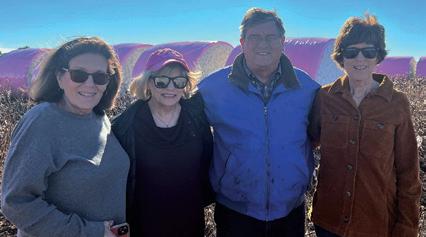
“When my term came up because of term limits, Senator Bean kept the ball rolling,” said Don Rone. “Our goal was to bring the station back to what it was when Jake Fisher was there. You have to keep the researchers there to support the growers.”
T.E. “Jake” Fisher served as superintendent of the center and was employed by the university for over 50 years. He retired in 2011 but continued to serve as an advisory board member.
“We were at one time on par with Texas, Purdue and Mississippi State in doing research
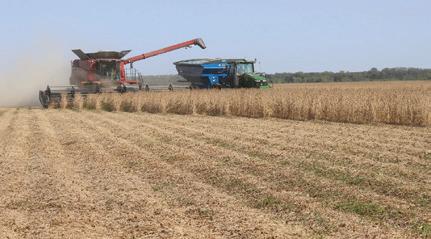
for the growers and for the ag industry as a whole,” Don said.
Through meetings with university president Mun Choi and Dean of the College of Agriculture, Christopher Daubert, the advisory board of growers was able to get funding reinstated to support more researchers at the Fisher Delta site.
“We now have six PhDs out here and we’re back,” said Don. “It was only because of the support from those families Lewis mentioned earlier – our bootheel mafia. Everyone came together with one goal - the Delta Center. And today the center is strong. They’re doing great research.”
The center was originally established in 1959 in Portageville to provide research and education focused on the Missouri Bootheel. Consisting of 1,119 acres at five locations, research is conducted on cotton, corn, rice grain sorghum, wheat, peanuts and other crops with an economic impact on the region.
“There are three things I’d like to mention about the Delta Center,” Don said. “One is that it exports a lot of people to the industry”
Which is one of the issues that arose as personnel moved away from the center and necessitated the move to ensure funding and personnel remain at the center. “
Number two is the cyst nematode research,” he said. “A lot of transformational cyst nematode research has been done here at the Delta Center.”
University research includes identifying genetic lines of resistance, as well as seed treatments that help keep the pest at bay.
“Number three is high oleic soybean research. That started right here in Portageville,” he said.
High oleic soybeans produce an oil that contains at least 70% monounsaturated fat, making the oil more stable at high temperatures. It is edible, with zero trans fats, for heart-healthy baking and frying. It also has a longer shelf life.
In addition to funding from the university, the center takes in support funds from commodity research groups like Cotton Incorporated, Missouri Soybean Merchandising Council, USA Rice and more.
“We know the importance of keeping research funding down here in the bootheel because our production is high and our soils, weather and drainage are unique.,” Lewis said. “It’s research that matters to the farmer.”
Variety yields are organized through researchers at the center in different parts of the
bootheel to determine which variety yields best in a particular soil type or region.
“We keep our variety testing to tell when our varieties are keeping up with the yields of other private or public researchers,” he said. “They report their yields at 100%, 105%, or 115% of a check, so that you know they’re doing better than the check.”
The Rone family farm is just north of the Portageville university center and they lease land in the surrounding area. Currently, soil testing is conducted in Columbia, Mo.
“Columbia is 300 miles away,” he said. “I can be at Mississippi State before I can be at my own soils lab.”
With the help of the advisory board and former Missouri Senator Roy Blunt, that will now change.
“We are in the process of building a two and a half million-dollar soils lab here at the Delta Center to meet not just the needs in the bootheel but for the entire southern Missouri ag community,” he said. “We are going to be able to test water samples, and do petiole tests in additional to soils tests. And do it all locally.”
BY BRENT MURPHREE
The Southern Cotton Ginners Association has named their 2025 Memorial Scholarship in the honor of John Edmonston, a longtime SCGA member and 1997 association president.
Edmonston was a third-generation cotton ginner and managed the family gin in the Bootheel of Missouri. He passed away on September 12, 2024.
He was active in the cotton industry as a delegate to the National Cotton Council and a member of the National Cotton Ginners Association, as well as SCGA.
When he was president of SCGA, Dunklin County where he lived, farmed and ginned, was one of the largest cotton producing counties in the Midsouth. It still is today, even though Edmonston Gin is now closed.
“Our county never really left cotton back in the ‘60s and ‘70s, when a lot of areas dropped cotton and went with a grain,” he said in 1997 as he was starting his year as association president. The same rings true today as growers continue to farm cotton in Dunklin County.
“I’ve come to believe that any ginner not involved in the (ginners) association is missing
out - if for nothing else than for the information it provides to members,” he said. “With all the government regulations, changes on the trade front, and everything else, things can sometimes be scary. The association helps to make sense of all these things.”
Almost 30 years ago he pointed to advancing technology and the constantly evolving nature of the industry.
Even back then he acknowledged that ginners who don’t stay on top of the new technology can face problems keeping up in their operation. He sited SCGA as useful for keeping ginners on pace with the changes.
Both brothers kept returning to a central point.
“The success of the Delta Center has been a massive group effort, and our family has just been fortunate to be part of that effort,” Don said. “My grandpa told me a story one time and he said, ‘You know what a good leader is?’ And I said, ‘no, Papaw, what is a good leader?’ He said, ‘It’s a man that finds out the way the people want to go, and he gets out in front.’”
The Rones, and their fellow farmers in the Bootheel, are helping to lead by getting out in front for the University of Missouri and the Delta Center.
The Southern Cotton Ginners Association Agriculture Achievement Award will be presented to the Rone family and the University of Missouri at the annual honors banquet on February 27 at the Peabody Hotel in Memphis, Tenn.
The award is presented each year prior to the opening of the Mid-South Farm and Gin Show, which takes place February 28 to March 1.

Current members of the association agree as they honor Edmondston after his passing.
“The association helps to make sense of all these things,” he said.
Association Executive Vice President Tim Price said, “What John said 28 years ago are so true today. He was a forward-thinking president and the association benefited from his leadership.”
Edmondston was also active in the community of Hornersville, Mo., as a member of Hornersville United Methodist Church, the Masonic Lodge, Farmers & Merchants Club and as a veteran of the National Guard.
He is survived by is wife, Becky, his sons Aaron Lance (Jackie) and John Leonard II, his daughter Becca Christine (Stoney) Cook, and nine grandchildren.
The University of Missouri’s (MU) College of Agriculture, Food and Natural Resources (CAFNR) is continually investing in the right faculty, facilities and collaborations to provide Missouri farmers with the research, demonstrations and outreach they need to keep the agriculture industry in the state thriving.
This is evident across the Missouri Agricultural Experiment Station’s four Research, Extension and Education Centers (REECs), including at the bootheel’s Fisher Delta REEC, where new faculty positions, building projects and outreach activity has exploded over the last five years.
The FD-REEC was established in 1959 in Portageville, Mo., to provide research and educational programs unique to the Southeast Delta Region of the state. Facilities include 1,119 acres of land at five locations representing the major soil types of the region.
The number of resident faculty at the FDREEC has grown considerably to assist needs of local producers.
A partnership between MU and the Missouri Rice Research and Merchandising Council created a position focused on rice agronomy in 2021. Additional staffing areas for Extension specialists/resident faculty at Fisher Delta REEC include soybean breeding, cotton agronomy, soil and cropping systems, crop protection and weed science.
Researchers at the FD-REEC have gained recognition for developing improved soybean varieties, especially those with soybean cyst nematode resistance. Research also focuses on the improvement of yield and resistance to stressors, and on enhancing the seed composition of soybean.
Research at FD-REEC also includes studies focused on improving irrigated crop man-
agement systems for humid and sub-humid climates; evaluation of herbicide programs, products and resistance management strategies; applied agronomic research focused on innovative crop production systems for southeast Missouri; and applied research to improve sustainability and profitability of rice and cotton production.
Having a team of resident faculty at the Fisher Delta REEC has led to an increase in outreach opportunities; recent years have seen the addition of an Ag Expo for producers, social media accounts directly from each programmatic area, and a monthly newsletter dedicated to showcasing activities at the center.
In the spring of 2024, ground was broken for the Roy Blunt Soil Testing and Research Laboratory at the FD-REEC. The building is named for former U.S. Sen. Blunt, who was integral in bringing together federal, state and local funding to build the new facility.
This $4.6-million facility will enhance agricultural research programs housed at the center, offering advanced soil, water and planttissue testing – some currently unavailable in the region.
“The addition of this laboratory at the Fisher Delta REEC will be crucial to enhancing the quality of research conducted at the center, thus enhancing the agricultural production and profitability of Missouri farmers,” said CAFNR Vice Chancellor and Dean Christopher Daubert.
In addition to new construction, updates have been made to current spaces at the FD-REEC in recent years, including the soybean breeding laboratory and the greenhouse.
“It is crucial to continue these improvements to enable our researchers to conduct groundbreaking research, and provide farmers

and producers with critical knowledge to improve their production practices and bottom line,” said Aaron Brandt, director of the FD-REEC. “This is more important than ever as farmers and producers are continually faced with the task of producing more with less resources.”
An update to the cotton program’s microgin aims to provide the industry in Missouri with a comprehensive, visual understanding of the ginning process, mirroring large-scale operations. This educational tool will allow viewers to follow the journey of cotton from harvest to useable lint. By simulating real-world ginning procedures, the program enhances industry knowledge and helps improve cotton lint quality in Missouri.
Additional cotton storage and office space is also currently in the works.
New initiatives and collaborations across the Missouri Agricultural Experiment Station aim to keep farmers more productive and efficient with time and resources – and producers in southeast region of the state are benefitting.
Mizzou’s new Digital Agriculture Research and Extension Center (DAREC) looks to enhance research, education and outreach in emerging digital technologies for farming; the goal is to help producers’ efficiency by using data-driven strategies for decision making.
Formed by a partnership between CAFNR, MU Extension and the United States Department of Agriculture (USDA) Agricultural Research Service, the center will explore key areas including crop production, soil health, precision livestock farming and engineering innovations through research and collaboration with industry partners and agencies.
A signature program is a grant from the Missouri Department of Higher Education and Workforce Development for agricultural drone training through the REECs, DAREC and MU Extension.
“This technology is just going to keep advancing, and it’s going to keep getting better and better, and we want to make sure we are working to harness that to help people farm better,” said Jay Chism, director of the Southwest REEC and program coordinator.
Finally, a partnership with the USDA’s Natural Resources Conservation Service (NRCS) has placed staff members across the REECs to work directly with landowners in their area.

“The purpose of this project is to enhance the adoption of conservation practices that will increase crop productivity, improve adoption of water management practices and enhance water quality,” said Jeff Case, director of the Northern Missouri REEC and of the project.
These forward-looking, creative and collaborative initiatives look to benefit Missouri farmers and ranchers for years to come.
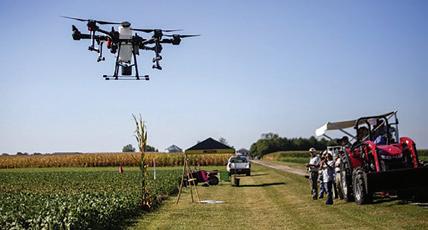
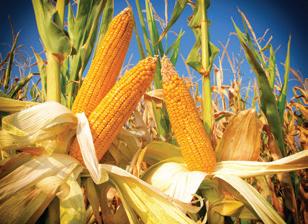
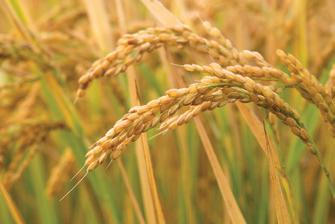
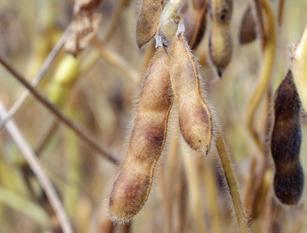
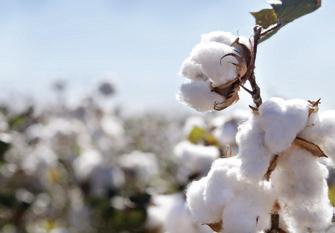
Throughout 2024, the National Cotton Council (NCC) worked diligently to amplify U.S. cotton’s presence across various platforms. NCC leadership from the seven segments of the U.S. cotton industry were engaged in numerous issues ranging from trade to regulatory. However, our primary focus remained the development of the new farm bill.
The NCC took proactive steps to communicate its priorities to Congress and the Administration, advocating for a meaningful farm bill that includes an effective safety net and comprehensive risk management tools. Throughout the year, NCC staff educated numerous new Congressional Members about the contributions of production agriculture to the national economy, the necessity of robust farm legislation, and the challenges facing U.S. agriculture.
Last year’s crop was covered by the 1-year extension approved by Congress and signed by President Biden late in 2023. However, as the NCC stressed to Congress, simply extending the current bill did not provide an adequate safety net given the costs of production. It remains critical that a new farm bill be passed to increase reference prices to a more meaningful level.
NCC staff has been actively involved at every stage, acknowledging that this process will extend further into 2025. For many producers, current cotton prices still fail to cover production costs, inhibiting grower profitability. Growers cannot afford another season without resolving the current deficiencies in the cotton safety net.
In September, the NCC led an initiative by sending a letter to House and Senate leaders advocating for a new farm bill with improved safety net provisions for producers. The letter, endorsed by over 300 organizations representing commodities, lenders, and other rural interests, highlighted that the current Title I safety net had not kept pace with inflation.
In addition to the letter, the NCC coordinated multiple commodity groups and lenders visits to nearly 100 House and Senate offices, including key Congressional Leadership offices in both Chambers. Participants noted that this was the first multi-commodity advocacy campaign
in recent memory, which added significant momentum to the process. Additionally, several state and regional cotton groups made separate visits to Capitol Hill, meeting with over sixty offices. All groups emphasized the urgent need for Congressional action and provided lawmakers with firsthand accounts from farmers about the challenges they face and the potential consequences of inaction.
In August of last year, the Council convened a Strategic Planning Task Force, consisting of eighteen industry members representing all segments and production regions. The Task Force continues to assess the global economic landscape and competitive forces facing the U.S. cotton industry, identifying strategies, policies, and initiatives to enhance the competitiveness of U.S. cotton, U.S. cotton textile products, and U.S. cottonseed.
The Task Force identified significant challenges facing the U.S. cotton industry, with the most pressing issue being the alarming gap between rising production costs and falling market prices. Discussions also highlighted the increased competition in global fiber markets from Brazilian and Australian cotton production, as well as the influx of Chinese polyester flooding the market.
Regarding issues that could harm the reputation of U.S. cotton, the Council is carefully observing reports of lint contamination from our textile customers, with most cases involving plastic contamination. This contamination is adversely impacting the economic well-being of the entire industry. Therefore, we are persisting with our educational efforts to prevent contamination.
Since exports are crucial for the sustainability of U.S. cotton, the industry is set to gain from the U.S. Department of Agriculture’s announcement of an additional $300 million in competitive grant funding through the Regional Agricultural Promotion Program (RAPP). This program targets applicants aiming to open markets in Africa, Latin America, the Caribbean, and South and Southeast Asia. This announcement marked the second RAPP application period of the year. In May, the USDA awarded $300 million in the first round of grants to 66

organizations, with Cotton Council International receiving $19 million, the third largest award among agricultural organizations.
The NCC also continues to support the U.S. Cotton Trust Protocol, a sustainability initiative that will greatly enhance the marketability of our cotton. This initiative presents a significant opportunity for our industry to offer the data and supply chain transparency that brands and retailers require. The NCC is pleased to announce that the planted acreage enrolled in the Trust Protocol has increased to 2.1 million acres, a 31% rise from the previous year, showcasing the industry’s strong commitment to responsible production. For more details, visit TrustUSCotton.org to learn more about the program.
The NCC will build on its longstanding service to the U.S. cotton industry by addressing challenges in farm policy, international trade, regulatory requirements, and appropriations in the coming year.
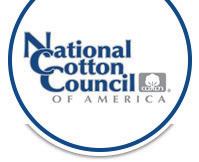
The National Cotton Ginners Association continues to address important regulatory issues that could significantly impact ginners. One important issue is the OSHA Heat Injury and Illness Prevention in Outdoor and Indoor Work Settings August 30, 2024 Proposed Rule, which is the first-ever national heat stress rule that is aimed at protecting workers from heatrelated illnesses and fatalities. This proposed rule requires employers to implement measures to safeguard employees from extreme heat in both indoors and in outdoor setting. This proposal could greatly impact your workplace safety protocols regardless of your industry, and therefore would affect agricultural operations and cotton gins. As we see it, there are several problems with this proposed rule, including a nationwide heat index triggers of both 80° and 90°, which most Southerners can easily withstand.
Just a few of the requirements are break areas with cooling measures, indoor work area controls, acclimatization protocols for new and returning unacclimatized employees, and paid rest breaks, if needed, to prevent overheating. The 90° trigger adds other layers to this proposed rule, including mandatory rest breaks of fifteen minutes at least every two hours. National Cotton Ginners posted comments regarding this proposed rule. In fact, there were some 30,000 comments posted, and we are hopeful that this rule will never be finalized, as employers are already doing what it takes to keep employees safe from the heat.
The inability for ginners to find and keep labor continues to be a major issue and gins are increasingly relying on the H-2A program to fill this need. Over the past few years, there have been several changes, including the methodology to calculate the Adverse Effect Wage Rate (AEWR) that has impacted the H-2A program.
The AEWR methodology change that has significantly increased the H-2A wage rates and has contributed to wage inflation in agriculture, as all employees who are hired by an employer using the H-2A program must be paid that same rate if the employees are performing corresponding labor. Changes also stated that to avoid paying higher wages than necessary, it was very important to include the correct AEWR Standard Occupational Classification Codes. Furthermore, several new rules and regulations, such as the 2024 Farmworker Protection Rule, are directed at employers using the H-2A program. This rule has a number of focuses on strengthening protections for agricultural work-
ers and on enhancing the Department of Labor’s capabilities to monitor H-2A program compliance and to take necessary enforcement actions against program violators. The problem is that the thrust of the rule is on protections for the employee and that there is nothing in this rule to address the needs of the employer. Users of the H-2A program should be aware of the new Department of Homeland Security Rule - Modernizing H-2 Program Requirements, Oversight, and Worker Protections that went into effect on January 17. The purpose of this rule is to modernize and improve the DHS regulations relating to the H-2A temporary agricultural worker program and the H-2B worker programs. The main purpose of the rule is focused on program integrity and worker protections, but the rule also includes strict requirements and penalties for employers who violate the requirements of these programs.
Another important issue that we are closely monitoring is the recent lowering of the National Ambient Air Quality Standards for fine particulate matter, or PM2.5, and the recent lowering of the annual standard from 12 to 9 micrograms/cubic meter. Ginners are concerned because the standard is set at such low levels that we are approaching the background levels that could put many additional areas into “nonattainment.” In fact, the average background monitor reading for PM2.5 across the U.S. is 8 micrograms/cubic meter. While EPA states that the earliest year that States will likely need to come into compliance with this standard is 2032, it is important to note that the standard went into effect last April, which means that state agencies will use the new annual standard of 9 micrograms as the limit if you are required to submit modeling for a new or a modified facility. Gins are seasonal operations, and how this new annual standard will impact the ginning industry is still being assessed.
Obtaining property insurance for gins considering increases in deductibles and premiums, and securing coverage are ongoing problems, and ginners must do everything that we can to detect and prevent fires. National Cotton Ginners has worked with insures and has developed the best management practices to help prevent fires, and these best management practices are available on the National Cotton Ginners’ website https://www.cotton. org/ncga/. Fire prevention research continues, and the committee heard an update on research that is being conducted by Greg Holt, with USDA, to determine if chemical precursors can
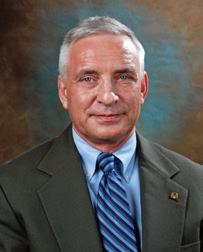
Harrison Ashley Vice President, Ginner Services National Cotton Council
be detected that signal that a fire in cottonseed is imminent, with a goal of developing an earlier warning detection system for a potential fire.
During the 2025 Ginning Conference in New Orleans, and in the National Cotton Ginners’ Technology Committee meeting, a major topic was discussions involving the vast amount of data that gins have available to them. Discussions involved the best way to capture this data and how the data can be utilized to increase ginning efficiencies, reduce costs, and provide benefits to farmers. One set of data that ginners have been collecting for years is the variable ginning costs that are documented in the Cotton Gin Cost Survey, and we need your gin to complete the survey. That survey is now webbased, and the link to the survey is available on the National Cotton Ginners’ website. This survey will allow you to track your individual gin’s variable ginning cost and to compare your cost to other gins in the region and in the rest of the Cottonbelt. However, if you would rather use a paper survey, that too is available on the National Cotton Ginners’ website. Just complete the paper survey and email it to hashley@ cotton.org. I will enter the survey data and will destroy the document. Your data is strictly confidential and will be shown only in aggregate. The data for ginning costs that includes energy use also may become an important discussion point in sustainability programs, such as the U.S. Cotton Trust Protocol.
BY RANEY RAPP
Raney.Rapp@FarmProgress.com
Agricultural trade is often broken down into dollars and cents. Twenty percent of U.S. agriculture is exported. Some commodities like cotton, for example, reach 70%-80%. Even more limited exports, like beef or milk at less than 15%, all cumulatively add up to billions of dollars for the economy.
In 2025 it is more critical than ever to know international trade markets and opportunities more intimately than simply numbers on a page – and visitors at the Mid-South Farm and Gin Show will have the opportunity to connect with trade more closely during the Mid-South Agricultural Trade Conference.
“What’s so unique about this year is the incoming administration and how it thinks about its broader trade policy agenda and what could be the consequences for the U.S. agricultural sector,” said conference coordinator Andrew Muhammad. “That’s important because we might think specifically about agricultural trade, whereas administration is simply thinking about all trade - manufacturing services, computer chips, automobiles in addition to soybeans, cotton and wheat.”
Muhammad said because agriculture is a political push point, countries often retaliate against agriculture specifically.
“There’s kind of tentative concern right now,” Muhammad said. “What will the trade outlook in the global situation be for US agriculture in that context?”
Held Friday, March 1, at 1 p.m. at the Renasant Convention Center in Memphis in conjunction with the Mid-South Farm and Gin Show, the trade conference will allow individuals to interact with national experts alongside professionals from the hosting entities including Tennessee Department of Agriculture, University of Tennessee Extension, UT Martin and UT Institute of Agriculture.
The Mid-South Agricultural Trade Conference provides knowledgeable resources on international trade, and the 2025 keynote speaker has insight to offer.
“Under the first Trump administration, a mission area was created called Trade and Foreign Affairs, and Under Secretary Ted
McKinney was the first individual to hold that title for agricultural trade and foreign affairs,” Muhammad said. “His tentative topics will rely on his well-versed experiences in issues of global trade.”
McKinney is also expected to weigh in on farmers’ top concerns.
“The elephant in the room is this potential new round of possible retaliatory tariffs,” Muhammad said. “Unlike during President Trump’s first term, when we had an agricultural trade surplus, meaning that we exported more to the world than we imported, now we actually have an agricultural trade deficit where we buy more food and ag from the world than we sell.”
In addition to national experts, attendees will have the opportunity to connect with local policy makers with a vested interest in representing Midsouth agriculture on an international level.
“We’ll have representatives from the Tennessee Department of Agriculture highlighting initiatives and efforts dedicated to promoting Tennessee products globally,” Muhammad said. “The Tennessee Department of Agriculture has been quite active in making sure companies in the state are engaged in global opportunities and so we’ll get an overview of all the success stories that have taken place over the last year.”
Speakers will discuss 2024 Tennessee agricultural exports and projections for the coming year.
In a trade deficit, identifying and marketing for international export opportunities can help improve commodity challenges. Muhammad said he intends to cover emerging issues farmers should be aware of.
“I will try to highlight some pressing policy issues that may have affected us the year past, as well as emerging policy issues going to affect us moving forward,” Muhammad said. “We’ll cover increasing competition globally, the state of agricultural exports at the national level, and then the changing dynamics we’re seeing at the state level.”
Overall, the trade conference offers attendees the chance for a greater understanding of the challenges facing ag commodities entering world markets.
“I hope this helps farmers have an understanding of what’s going on in a broader context to help them digest the local phenomenon that you actually experience due to global dynamics that are taking place,” Muhammad said. “Global issues are often paramount in even the day-to-day down in the weeds level decision making that farmers make. I hope that’s the main take away.”

BY WILLIAM E. LINDAMOOD, JR. Safety Director
Southern Cotton Ginners Association
Cotton gins have proven successful providing efficient, safe operation in the processing of quality fiber. There are several areas where this success is threatened by challenges beyond their control. Individual gins benefit from the lobbying and intervention of our professional associations to address industry and regulatory challenges. Excellent safety results and proven regulatory compliance are helpful in this effort.
Mid-South cotton gins continue to make good use of the safety and regulatory tools the Southern Cotton Ginners Association (SCGA) provides in the Gin Safety Program binder and various seminars, and our goal remains: no serious injuries. During the 2024 ginning season, falls and amputations were limited to one trip resulting in a broken hip, one hand amputation and one finger amputation. Tragically, two individuals were killed when struck by a loader in the middle of the gin yard during broad daylight. As important and effective as training has proven to be, it is the individual’s situational awareness that is required 100% of the time in the gin and on the gin yard.
The advocacy of your associations is often in the background. They diligently pursue goals critical to the success of the cotton industry. One current priority is the availability of insurance writers and rewriters for the entire agricultural sector. The commitment to safety by our Mid-South cotton gins and willingness to implement requests from the insurance industry, such as dash cams on trucks, is a big help. In 2025, SCGA will be advocating for member gins to install cameras on loaders with split screens in the cabs to ensure that operators have clear sight lines in all four directions.
While we hope for a more simplified regulatory environment, the government’s funding of 100% more DOL OSHA investigators and further regulatory intrusion, such as the new walk-around rule proposed by OSHA allowing union organizers and labor consultants to accompany OSHA onto your property at your expense, will require more work to correct.
The lobbying of the cotton industry professional associations to Congress and the Executive administration has proved valuable in identifying and eliminating burdensome rulemaking.
The attempts by OSHA to create a national rule based on California’s heat exposure regulations are also problematic. The attempt by OSHA to create an absolute rule for all national environments and all crews shows a serious disregard for work required for industry to function. Wage and Hour and the Employment and Training Administration (ETA) continue to pressure contract labor and H-2A programs, even as local agricultural labor becomes problematic. Again, the lobbying efforts of the cotton industry professional associations are key in maintaining access to competent labor.
As diligently as cotton gins work to process quality fiber in a safe environment, there are challenges they cannot address individually. How much cotton will be planted in the Mid-South? Cotton gins need to know in order to plan and schedule required maintenance and or improvements. Planting preparations for the 2025 cotton season are fast approaching. The chances of securing producer financing have been improved by the extension of the farm bill and approval of disaster payments to help cover the notes due from 2024.

The SCGA acknowledges and appreciates the advocacy from the National Cotton Council (NCC) and the National Cotton Ginners Association (NCGA) in eliciting support for the farm bill extension and relief payments from our Representatives and Senators. Individuals contacting their Representative and Senators also contributed to this result.
Mid-South cotton gins face another dilemma. While the mission statement goals from the 1990’s for lint production and fiber quality have been met and surpassed, the seed size and quality has not been met. The average 750-to-850 pounds of seed per bale in the 90’s has dropped to 500-to-600 pounds of seed per bale. This 33% drop in revenue makes it crucial that SCGA, NCGA, NCC and Cotton Incorporated continue to reach out to university and commercial breeders to develop seed size and quality.
The cotton industry is resilient, and SCGA looks forward to helping create a successful and safe operating environment. Ginners, please keep us informed of your experiences. You may call my cell phone number in the Safety Program binder at any time.

Allen Espey is the incoming president of the Southern Cotton Ginners Association and the association’s 2025 Ginner of the Year.

Allen Espey is killing two birds with one stone this year. He is the incoming president of the Southern Cotton Ginners Association, as well as having been awarded the association’s 2024 Ginner of the Year.
“I sure didn’t seek the award, I’ll tell you that. I think I just got old, you know,” he said with a laugh. “I’ve been here a long time, since I was nine years old.”
He started working at Espey Gin at the age of nine in 1974 after his father bought the gin.
During ginning season, he’d ride the school bus to Espey Gin, which is inside the town limits of McLemoresville, Tenn., to help out in the family operation.
The original gin had been built in 1898 by James H. Bramley and passed down from father to son to daughter and son-in-law before Espey’s father, Billy, purchased the site in 1974. He is passing this dedication on to the next generation as his son, Will, is actively involved in the farming and cotton gin operations.

When Allen started, they were pulling cotton out of cotton trailers with a suction pipe. Today the cotton is fed into the gin from round modules by a module feeder.
“I think the biggest change at the gin has been the modules,” Espey said of the densely packed cotton blocks. “First, the regular big modules, and now the round module.”
Prior to the module builder development in the early 1970s, loose cotton was hauled to the gin in wire caged cotton trailers. The module builder packed cotton into tight forms on the ground that could be picked up and hauled to the gin. That evolved into module builders built into the cotton picker. The cotton is packed, wrapped and dropped in the field for easy pickup, and then delivery to the gin.
Timely improvements in Espey Gin over the years have culminated into the current operation with two Lummus 170 gin stands and an automatic strapping system.
However, the basic process of removing lint from the seed has remained unchanged into the modern era.
“We’ve averaged around 35 to 40 thousand bales a year in the last five to 10 years,” Espey said. “I’d say our yield average is probably 1,250 pounds per acre - probably a two and a half bale average.”
In 2024 the yields were off due to weather related conditions, but overall Espey notes that Carroll County is a good place to grow cotton. He farms about 5,000 acres split between cotton and corn.
Espey showed a picture of himself as a child with his dad in the gin. “I’ve been involved all my life,” he said. He took over the operation in 1986 after his dad passed away.
He credits his family, employees and customers he works with in the enterprise to its success.
“I’ve been blessed with good employees,” he said. His head ginner, Frank Villalobos, has been around since 1990 and the office manager, Angie Martin, since 1986.
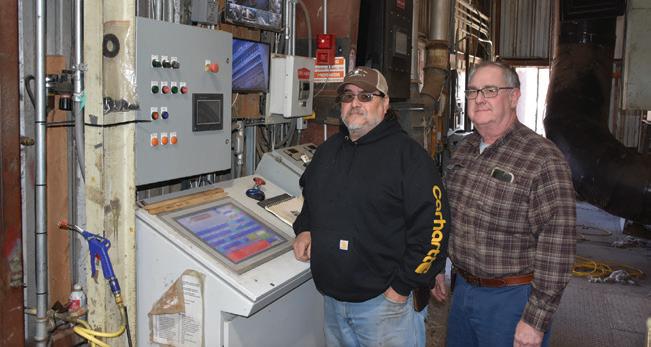
From another room in the office Martin said, “I grew up picking cotton, so it’s been a part of my life. It’s interesting, amazing and astounding to see how it has improved over the years.”
And, after meeting Villalobos out in the gin, it is like a family of sorts. An easy familiarity is evident in the team that works well together to make the operation work.
Espey’s work effort certainly shows at the gin, but also in the community, and with the ginners’ association.
“I haven’t missed a gin show since I was nine years old,” he said of his exposure to the Southern Cotton Ginners Association. So, his involvement with the association goes back to the time when he was a kid.
He began participating actively in the association in the late 1980s, first going to the meetings, and then sitting on committees.
The front office of the gin is lined with diamond safety awards presented to the operation, attesting to his diligence to keep the environment of the gin safe for his employees with the association’s help. The room is also filled with educational posters and displays for visitors who stop into the operation. These displays and handouts help make people more aware of the diversity of cotton and cotton products and encourage local business, factories and the public at large to use cotton.
Of course, that traffic through the office and gin has slowed down since the pandemic. But, it’s this dynamic focus on the industry, how much cotton means to the livelihood of Carroll County, West Tennessee and the cotton industry, that drives Espey to the ginners’ association business.
“It’s a good organization,” he said. “It’s been good to be a part of it. I’ve met a lot of good people.”
SCGA Executive Director Tim Price notes that Espey’s dynamics as part of the leadership of the association show his long-time commitment to the industry at large.
“Allen is a generational leader for agriculture and is widely respected as a steady, thoughtful, solidly dependable leader, fully participating in his community and the cotton industry locally, regionally and nationally,” Price said.
Given the current economic situation, Espey said he wants to make sure the organization maintains its focus on safety and education. “I’d like to just make sure that we keep everything going like it’s been. It’s a very important organization that keeps up with all the regulations and requirements for running the gins.”
And, concerning the Ginner of the Year Award, when asked again what he thought about it, he said, “You know, I think anybody that runs a gin gives the best service they can.
“I’ve been blessed with a good wife and family that supports me. During ginning season you’re at the gin 24/7, you just do your job. You know, I’m not any better at this than anyone else.”
Espey will receive his Ginner of the Year Award at the annual Southern Cotton Ginners Association honors banquet on Thursday, Feb. 27, at the Peabody Hotel in Memphis, Tenn.
The award is presented each year to an exceptional cotton ginner in the Midsouth, just prior to the opening of the Mid-South Farm and Gin Show.

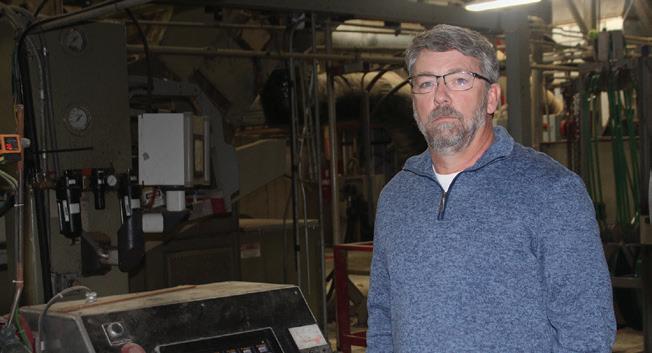
BY WHITNEY SHANNON HAIGWOOD whitney.haigwood@farmprogress.com
The U.S. cotton industry is robust, and Missouri ginner Jeff Lindsey understands that very well. Now that he is in the final weeks of his presidency of the Southern Cotton Ginners Association (SCGA), he even better recognizes the grand scale.
In his one-year term as SCGA President, Lindsey said decision making within the association was complex to meet the needs of the five cottongrowing states represented by the SCGA along with other major key players in the cotton industry.
“I see firsthand with the Southern Cotton Ginners Association, there are so many things we are involved in helping with. There is a lot of things tied to decisions, and it is a domino effect,” he said, as he underscored that one association decision impacts another or other commodities.
Lindsey is no stranger to hard work. In addition to his career as manager and head ginner at McCord Gin Company, Inc. in Gideon, Mo., he has also volunteered to serve on corporate boards and on the local school board.
In his experience as SCGA President, the SCGA compared to his past leadership role is part of a much larger network and connects all things cotton for the states of Arkansas, Mississippi, Missouri, Louisiana, and Tennessee.
“You have the National Cotton Council involved, and you have the gin laboratories and all their research. Then, there are frequent conversations with legislators at both the state and federal levels,” he said.
Teamwork is key. Lindsey said, “Our board works great together. Our goal is to help improve the entire cotton industry, whether it be to help the National Cotton Council or our individual states.”
Navigating decision roles takes patience, because each state has different regulatory issues. Plus, logistics are different when it comes to marketing cottonseed. All of that, plus the expanse of the network, determine the decision-making process for the SCGA.
“The cotton industry is extremely dynamic in the fact that it is nationwide. I would say that is the biggest difference in this board compared to others I have been on. The cotton industry is continually moving,” Lindsey said.
Going forward, Lindsey said the SCGA staff is in good shape with a great board and internal leaders working to accomplish the association’s goals.
“We have been 20 years with great leadership, and we still have great leadership,” Lindsey said.
Cottonseed prices and labor shortages are continued concerns for Lindsey as a ginner and others in the industry.
After conferring with a cottonseed trader, Lindsey said, “Really, the cottonseed oil market has not improved. I heard that for dairy, the free fatty content in cottonseed has gone down some, and that is starting to be a concern with feeders and crushers.
“Nothing happened from it (cottonseed deductions) this year that I am aware of as far as docks or deductions, but it does concern me that it could continue to be a greater problem going forward.”
Plus, local labor is scarce like other realms of row crop production. The new U.S. Presidential administration leaves agriculture to wonder what is in store.
At Lindey’s gin in Gideon, he has four employees. None are foreign workers. Two of the three ginners have been with him for three years. The fourth is his office manager for 18 years.
From a ginning perspective, Lindsey said trade school employees are where it’s at. “A lot of these other ginners I talk to are saying the same thing. Trade positions are needed.
“I feel like the kind of people we need to hire are those who go to trade schools and learn about electrical and mechanical and maintenance issues. Employers are not doing that in this country as well as we should be.”
The SCGA summer meeting was a success, as were the district meetings
Lindsey said, “The summer meeting this year was packed with information. We discussed everything from cotton to the cotton market, cottonseed, and the size of the seed and seed oil. They had people speaking on all these different topics who were very knowledgeable.
“They checked every box this summer, I thought. In fact, it was almost so much information that it was nearly too much for a day. New technology was really hammered hard at the summer meeting.
Then there were district meetings, and for the past few years the SCGA President has tried to make as many as possible.
“As far as the district meetings, they were a summary of everything that was discussed at the summer meeting. I saw that so enjoyable.
Lindsey continued, “Each of the district meetings I went to, I talked to many in the past. It was nice to get to talk to them again, and in some cases, it was new people and new stories and new challenges. That was one of my highlights of being in Southern Ginners was attending all those different meetings.”
Another highlight for Lindsey was working with Tim Price, executive director of SCGA. Lindsey said, “A lot of people do not see the stuff going on behind the scenes. It was nice for me to get to see it. We know all the things are getting done, but you are not sure until you get those weekly phone calls to address issues or send a letter.
“You get a new appreciation for Tim and his whole staff for how much work goes into the association in addition to the Gin Show.”
In the coming month, Allen Espey is seasoned to assume Lindsey’s role as SCGA President.

Lindsey said he and Espey have spoken often. “We have discussed a lot of the job details of the presidency. I have shared with him and what I have learned. Actually, he has been on the board a lot longer than I have, and he has helped me through it probably more than I have helped him.
“As far as words of advice for Allen, I do not know that I have much other than to keep doing what we are doing, because it seems to be working.”
The annual meeting of the Southern Cotton Ginners Association takes place, Thursday, February 27 at the Peabody Hotel at 1:30 p.m., just prior to the Mid-South Farm and Gin Show.
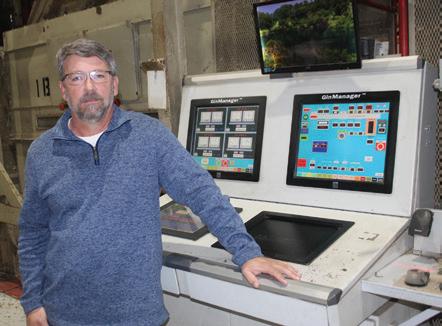

By FORREST LAWS
Contributing Writer
Farmers have long benefited from entrepreneurs’ willingness to take risks to bring new technology and methods of farming to agriculture. A new partnership may help improve the process and deliver even more innovations sooner.
AgLaunch, a Memphis, Tenn.-based ag business incubator, which has been working with AgTech startups for more than a decade, and Ag Ventures Alliance, a farmer-owned cooperative, have launched AgTech Innovation Connect to achieve that goal.
Officials with AgLaunch, which recently announced that 21 new startups are seeking up to 10 spots in its 2025 AgLaunch365 Accelerator program, and AgVentures Alliance said the AgTech Innovation Connection will include a series of regular virtual meetings for supporting those earlystage AgTech startups.
“This joint venture is designed to help founders and entrepreneurs grow their businesses through access to practical resources, industry expertise and a strong network of AgTech professionals,” said Pete Nelson, president of AgLaunch.
Startup resources
He said those resources will include information on:
■ Intellectual Property: Guidance on protecting and managing innovations.
■ Marketing & Branding: Insights into building a brand that connects with the agricultural market.
■ Talent Strategies & Fractional HR: Flexible HR support for attracting and retaining top talent.
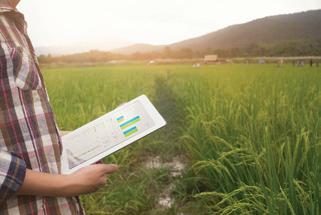
The joint venture is
to help founders and entrepreneurs grow their businesses through access to practical resources, industry expertise and a strong network of AgTech professionals. Getty Images/iStockphoto
■ Grant Writing & Fundraising: Resources for securing non-dilutive and dilutive capital.
■ Company Structure: Advice on setting up a sustainable business framework.
■ 1:1 Mentoring: Access to experienced mentors for personalized guidance
“The program includes exclusive information on opportunities like specialized webinars, industry bootcamps and the AgLaunch365 accelerator program,” said Nelson. “Through AgLaunch365, startups receive handson support, connections to industry leaders and opportunities to conduct follow-on farm trials that allow for real-world application and validation of their products and services.”
That support was in evidence when the entrepreneurs behind the 21 new startups met in Memphis to compete for one of the the spots in AgLaunch 365 in October. Startups that made it to AgLaunch 365 were selected from a broad pool of applicants by farmers who work with AgLaunch.’
The new companies came from across the globe and are developing technologies that span the fields of robotics, biologics, climate-smart, genetics and animal health. The finalists will participate in a special session at the 2025 Mid-South Farm and Gin Show, which will be held in Memphis on Feb. 28 and March 1.
“The 21 teams chosen by our farmer members for the AgLaunch365 Challenge represent some of the best and brightest early-stage startups that recognize the value that our farmers and unique commercialization approach offer,” said Margaret Oldham, vice president of innovation at AgLaunch.
AgLaunch 365 provides two-year support from proof of concept through Series A, the first round of equity financing after seed funding, leveraging its farmer-centered business development approach and multi-year farm trials. The 50 farmers who provide this support share an equity stake in each startup that goes through AgLaunch 365.
The 10 startups selected for AgLaunch will be announced in December and will pitch their companies to a national group of investors and strategic partners in Memphis on Feb. 27, 2025, Nelson said.
“AgTech Innovation Connection invites founders of early-stage AgTech startups and established companies interested in the latest innovations to request to join here,” said Nelson. “By joining, members become part of a vibrant community shaping the future of agriculture.”
Story provided by Delta Farm Press.
What happens when sweet potatoes are under the influence? From the farm to the distillery, read how this family transformed their business model to deliver premium spirits, with raw ingredients grown in the Delta.
BY WHITNEY SHANNON HAIGWOOD whitney.haigwood@farmprogress.com
The Williams family has deep agricultural roots in Arkansas, tracing back to the late 1800s. Four generations ago, the Phillips County farm they know today was originally sharecropped by their family patriarch. This land continues to deliver, but now with a different mash-up compared to traditional agriculture. Why? Because the Williamses make vodka out of sweet potatoes.
The idea was born in 2017, when Harvey Williams Jr., and his wife Donna co-founded Delta Dirt Distillery, a farm-to-bottle craft operation. Their adult children, Thomas, Donavan, and TaHara, are part of the family business, and together they specialize in award-winning sweet potato vodka, along with other craft options like gin and Arkansas Brown.
Farm Press recently took a guided tour of Delta Dirt Distillery, where Thomas shared the history of the farm and what led their family to launch this business model.
SHARECROPPING, MOONSHINE, AND SWEET POTATOES
The storefront of Delta Dirt Distillery brings a warm and modern vibrance set against the backdrop of downtown Helena-

West Helena. However, if you dig a little deeper, the real story starts in the field.
The Williams story began with 86 acres, sharecropped by Joe Williams, the family’s firstgeneration farmer. His son, U.D. Williams, continued the agricultural legacy and purchased that land in 1949 by his sale of cotton and homemade moonshine.
Next, Harvey Williams Sr. came along as the thirdgeneration farmer. However, he switched gears from row crops to vegetable production. He began growing sweet potatoes and squash to broaden marketing perspective and profitability. Years later, those sweet potatoes

would take the Williams family to a new level.
Just a few years ago, Harvey Williams Jr. was living out of state with his wife Donna. They wanted to move back home to the family farm in eastern Arkansas. It was then that distilling vodka came into the picture. His son, Thomas, recalled the conversation. “If vodka can be made from anything else, why not sweet potatoes? What reason could we not run our own distillery?”
Harvey Jr. researched what it would take and tasked Thomas with distilling. “I give my dad the visionary credit,” Thomas said. “He was the one who said this is the business we are going to do. He asked me to figure out how to distill, and we just made it work.”
After trial and error, Delta Dirt Distillery released its first run of Sweet Blend Vodka in December 2020, made with corn and sweet potatoes grown on the family farm. They opened the distillery doors on April 1, 2021. From there, they expanded their spirit lines to Tall Cotton Gin and a small-batch Arkansas Brown called Deep Roots.
Walking through the doors of Delta Dirt Distillery gives a warm and inviting ambiance. The spacious front room is softly lit, and a cozy seating area leads to a large bar top. Take one
glance around, and you can see smiles across the room as folks enjoy good company and their choice of Arkansas-made beverages.
This space is also available for events. While Farm Press was there, the venue was hosting a wedding shower for a long-time family friend. Thomas said, “That was what we were going for, for everyone to feel welcome and always feel at home.”
Behind the bar are panoramic windows that offer a view of the distillery. In the forefront, four tall columns are beautifully showcased. Beyond that are fermentation tanks, where the magic begins.
Thomas explained the process from start to finish. First is the mash. Raw ingredients are mixed with an enzyme to turn starches into sugar. These raw ingredients range from sweet potatoes or corn to barley or rye. It all depends on the end product.
“Sweet potatoes have a different process than grains,” Thomas said. “The temperature and enzyme requirements are transitively different.”
Next, the concoction is placed into tanks, where yeast ferments the sugar into alcohol. This timeframe fluctuates, based on the season of the year. In the summer, the distillery is
Story continues on the next page
warm, speeding up the fermentation process to around three days. However, in the winter it takes nearly a week to ferment the mixture. From there, the concoction is distilled, and three cuts are made to separate the heads, hearts, and tails. Thomas explained each of the components that lead to a state-of-the-art drink.
■ The heads are removed to take out low boiling point alcohols you do not want in your drink, like methanol and acetone. These can be saved to use as a solvent or
cleaning solution.
■ The hearts are the good stuff with the highest ethanol concentration and are showcased in the final bottled product.
■ The tails are by-products, high in alcohol, and undesirable in a beverage. Those are kept and distilled in the next run.
At Delta Dirt, vodka is distilled twice. The fermented mixture is heated in two copper stills, and Thomas pointed out the 10 sight glasses aligned down the tall vertical

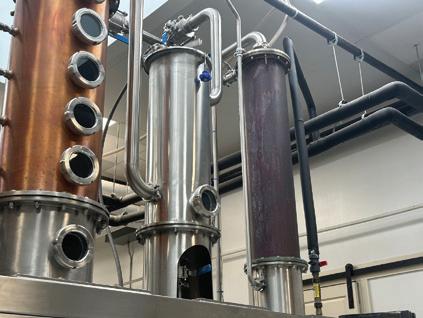
structures. He said, “We do not need to distill it more than twice because of these two columns. In each one of those sight glasses is a copper plate, and a mini redistillation takes place at each one of those plates.
“As the mixture hits that plate, it condenses back to a liquid, and it can only pass to the next plate as a vapor. So, it is being redistilled about 20 different times.”
Immediately next to the copper columns is a shorter stainless-steel column, called a gin basket, exclusively used to distill gin. Thomas said, “When you open that up, there is a little wire tray where you put in all the botanicals –the juniper berries, orange peel, angelica, and coriander – which are vapor infused into the alcohol as it passes through the column.”
The last and farthest right column is a condenser. It never gets hot, so the color of this column remains black, and its job is to return the distillate to a liquid.
After distillation, the final product is sent through the bottling line where bottles are cleaned, filled, corked, labeled, and sealed. No matter the beverage, whether vodka, gin, or Arkansas Brown, the result is a clean, smooth drink. You can taste the passion and hard work behind the process that took years to perfect.
Thomas said, “For the first eight months, I was the only employee from start to finish.” Now the family is four years into the business, and their dedication to the farm and the craft are recognized both regionally and nationally.
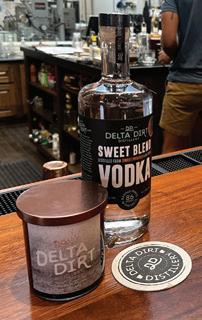
Harvey Jr. serves as CEO, and his wife Donna is the brand manager. Thomas is the head distiller, and Donavan is operations manager. Together, they have earned numerous awards including 2023 tourism attraction of the year and others for packaging, product branding, website and small business.
They also brought home platinum honors from the 2024 San Francisco World Spirits Competition. Receiving a platinum award is a big accomplishment, because it requires three consecutive years of double gold awards based
on a panel of judges who participate in blind taste testing.
Irrefutably, the family conversation that took place in 2017 completely transformed the Williams’s farm business model. From awards to each and every quality driven sip, their accomplishments are undeniable. In fact, their recent Deep Roots release in the fall of 2024 was a sellout.
If you want to see more, check out the slideshow of the distillery tour. Even better,
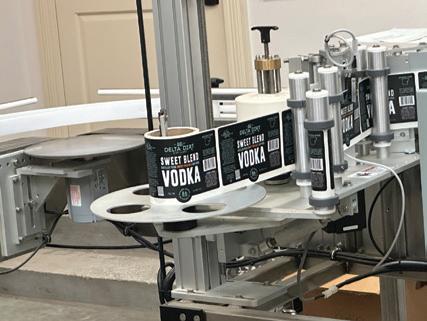
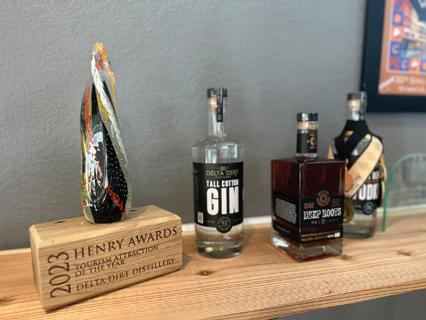
go see for yourself, and cozy up to the bar while enjoying good conversation and a drink from the Natural State. Learn more and book a Delta Dirt Distillery tour on their website at https://deltadirtdistillery.com.
Story provided by Delta Farm Press.
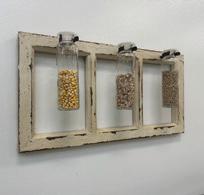
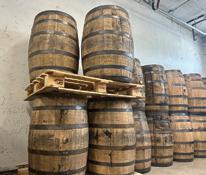
“How do checkoff dollars work for you?” Benefits range from research and Extension outreach to domestic and international promotion.
BY WHITNEY HAIGWOOD whitney.haigwood@farmprogress.com
Of the six rice producing states in the U.S., Arkansas grows more than half of the nation’s rice. This makes research and promotion an important topic. While funding these efforts can be controversial at times, there are many benefits of research and promotion for farmers and stakeholders alike.
Jim Whitaker, fifth-generation McGehee farmer and chair of the Arkansas Rice Research and Promotion board, painted a picture of how rice checkoff dollars and other funds contribute to the industry, especially in Arkansas. He shared how checkoff rates differ in Arkansas compared to other rice producing states. Whitaker also discussed how these efforts impact U.S. rice beyond the borders of the Natural State, from land-grant university research to domestic and international promotion.
The Arkansas Rice Research and Promotion Board consists of nine farmers. The board was established in 1985. Then in 1999, a mandatory leveled assessment was signed into law to collect funds based on the annual sale of U.S. rice. These funds, or checkoff dollars, are collected from the farmer and the purchaser.
Whitaker said, “The role of the board is to support research and promotion of Arkansas rice, and we try to make the best decisions and distribute these collected funds to the best of our ability.”
In Arkansas, a total of 2.7 cents per bushel of rice is allocated to checkoff dollars. Of that, 1.35 cents per bushel come from the farmer at the point of sale, and 1.35 cents per bushel come from industry mills. The portion collected from the farmer goes to research, while money collected from the purchaser goes to promotion.
Each rice producing state sets their own collection rates. While Arkansas may rank number one in rice production, it ranks fifth lowest for checkoff rates. Whitaker shared the allocations.
■ California collects 9.1 cents per bushel
■ Louisiana collects 3.64 cents per bushel
■ Texas collects 3.64 cents per bushel
■ Mississippi collects 3.0 cents per bushel
■ Arkansas collects 2.7 cents per bushel
■ Missouri collects 2.0 cents per bushel
Over the last 24 years, Arkansas has collected the same rate. While rice yields have increased, planted acres have declined and driven rice checkoff funding lower. Based on state average yields, Whitaker said the Arkansas rice checkoff program generated $5,882,560 from 2000 through 2009. Then from 2010 to 2019, that collection dropped to $5,732,165.
Each year, Arkansas plants anywhere from 1.2 to 1.6 billion acres of rice, contributing an estimated $6 billion to the state’s economy and creating around 25,000 jobs. Thus, research and promotion are important to fuel the industry. From a promotional standpoint, Whitaker talked about recent successes from funds distributed directly to Arkansas rice farmers. These include:
◊ $20.6 million through conservation programs of the USA Rice and Ducks Unlimited Rice Stewardship Partnership
◊ $30.5 million of the total $80 million allocated through the Climate-Smart Commodities grant
◊ $1.2 billion in payments through the Rice Production Program, spearheaded by Senator John Boozman in 2022, after an economic analysis conducted by Ag Economist, Joe Outlaw
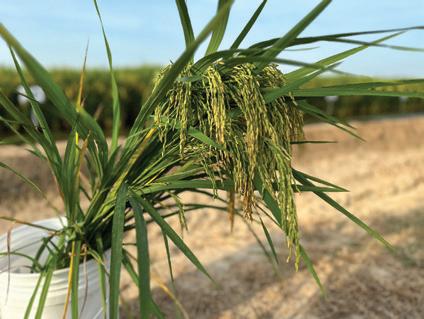
beyond the borders of the Natural State.
Beyond funding for farmers, the USA Rice Federation and the Arkansas Rice Federation advocate on the federal level for the industry. USA Rice is an umbrella organization representing farmers, millers, merchants, and the USA Rice Council.
Sarah Moran, chief operating officer at USA Rice, explained that over 30 different committees are part of an inclusive and comprehensive grassroots process to address policy for the industry. “That really helps us when we go to Capitol Hill and talk with administration about priorities. We have a unified voice from the rice industry, and that is one of our strengths,” Moran said.
text message updates to over 350 subscribers. Whitaker specially applauded outreach contributions of Extension Rice Agronomist Jarrod Hardke, including his social media engagements on Facebook and Twitter.
In the same year, over 500 field trials were conducted in Arkansas for verification, variety performance, and pest and disease management. Whitaker emphasized those 500 trials took place on actual farms.
USA Rice is an umbrella organization representing farmers, millers, merchants, and the USA Rice Council.
Plus, USA Rice conducted 2,700 promotions in 25 countries across the globe in 2023 to promote the sale of U.S. rice, and farm and mill tours are hosted annually for foodservice professionals.
Jeff Rutledge, a Jackson County farmer who also serves on the Arkansas research and promotion board, said, “We are cooperating with other states in doing national promotions and collectively using checkoff dollars from other rice producing states to stretch our U.S. dollars internationally.”
Communication is also key. Michael Klein, USA Rice vice president of communications and strategic development, oversees this through podcasts and daily newsletters to provide information on behalf of U.S. rice farmers. Whitaker added, “Every morning when I get up as a farmer and go to work in a town with one stop light, I know there is somebody working on my behalf all over the world. Somebody is doing domestic promotions, and someone is doing international promotions. Then I have Extension agents and researchers from the University of Arkansas and the USDA in our state, and I can pick up the phone and get advice on how to make a better crop.”
The University of Arkansas System Division of Agriculture is dedicated to outreach, sharing its research findings in a variety of ways. Printed publications are handed out by the tens of thousands each year for weed, insect, and disease management. You may know these as Extension publications MP44, MP144, and MP154.
Digital outreach is also impressive. In 2023 alone, the Division produced 21 podcasts involving rice, 25 weekly newsletters, and 50
Researchers have also intervened when farmers needed additional means of crop protection. In 2022 and 2023, Extension Entomologist Nick Bateman fought for a Section 18 exemption from the EPA so farmers could use the product Indigo to control rice stinkbug infestations.
“I can promise you I would not have killed stinkbugs on my farm without that chemical and without Nick Bateman’s hard work,” Whitaker said. “It would be hard to quantify exactly how that benefitted the state of Arkansas.”
Deacue Fields is vice president for agriculture at the Division. He said, “Our budget is equally split between research and extension. We are the research and development arm as well as an information delivery system for the industry. Our folks are in the service business, to provide information that everybody uses, from farmers to Extension agents and consultants who all rely on the research.”
Another source of funding for rice research and promotion comes from Columbian Tariff-Rate Quota funds through a program
established in 2012. Rice exporters can sell a set amount of duty-free rice to Columbia. Companies bid on the right to bring in dutyfree rice, and proceeds from those auctions are split equally between Columbia and the U.S. From there, TRQ funds are divided between the six rice producing states. A similar program generates European TRQ funds, and Whitaker said Arkansas has benefitted by over $43 million of the proceeds.
Up until 2022, TRQ funds could were allocated only for research. Now, TRQ funds can be used for research or promotion, and recently Arkansas utilized a portion of this money with other public-private funding to construct the Northeast Rice Research and Extension Center.
Whitaker said the station fills a research need for northeast Arkansas where most of the state’s rice is produced. “Rice production is moving north in the state because of climate. This center gives the industry representation there, and we have something to be proud of.”
He also stressed the need for continued rice studies through the University of Arkansas. After all, anyone should be able to turn to the top rice producing state when looking for information about the crop.
Bottom line, all producers have benefitted from these resources and checkoff dollars continue to work for the Arkansas and U.S. rice industry that invests in itself. For more information on the benefits of the Arkansas rice checkoff program, please visit arkrice.org, usarice.com and uaex.uada.edu/farm-ranch/ crops-commercial-horticulture/rice.
Story provided by Delta Farm Press.
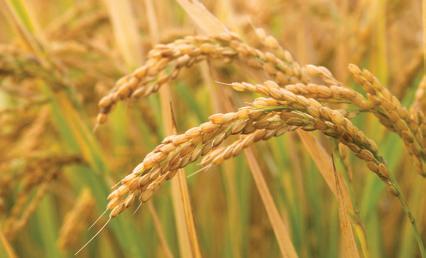
BY FORREST LAWS
Contributing Writer
When a group of farmers in eastern Arkansas hired Ryan Moore to handle their data management several years ago, the idea was that he could help them reduce costs and make their operations more efficient.
They couldn’t foresee that Moore, the owner of M&M Ag Consulting LLC, in Little Rock, Ark., would help them find another revenue source and some encouragement when agriculture was going through difficult times.
But Moore put them in contact with AgriCapture, a Tennessee-based company that recently announced the sale of 30,000 “high integrity methane emission credits” through a landmark deal in climate-smart agriculture. The purchase is part of the largest rice methane reduction project in U.S. history.
“Working with AgriCapture added a significant amount of money to our rice income this year,” said Gavin Sullivan, a fifthgeneration rice farmer from Burdette, Ark. “If
we can continue to do that and, hopefully, sell a high-dollar carbon credit, it could make a big difference in the years ahead.”
Sullivan, who farms about 11,000 acres with his father, Scott Sullivan, says rice prices above $7 a bushel for the last two years have been good for producers. He’s seen prices average closer to $5 and $6 a bushel during the 11 years he’s been farming.
“I foresee us going back to $5 rice at some point, and selling a $100 carbon credit would help offset that,” he said. “I may be wrong, but that’s how I think we will come up with the extra income to keep the ball rolling.
“Carbon credits help us adopt sustainable practices that require higher investment, and this project allows us to do so in a way that works for our operation. The sale of these credits provides an economic return for being better stewards of our rice farm.
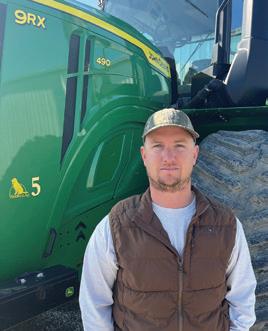
Flooded rice fields emit methane, a potent greenhouse gas with a global warming potential 81 times greater than carbon dioxide over 20 years, according to AgriCapture’s announcement of the sale. With methane accounting for onethird of global warming, reducing emissions is essential for climate change mitigation.
“Our goal at AgriCapture is to lead the way in creating scalable, market-based solutions that help farmers improve the environmental and economic sustainability of their operation,” said AgriCapture President Tyler Hull. “We’re seeing increased demand for buyers as we demonstrate the high return on investment and impact associated with methane reduction.”
AgriCapture generated high-quality methane reduction credits by collecting detailed field data, accurately quantifying environmental benefits and reporting emissions reduction, the company said. The credits are third-party verified and issued by the Climate Action Reserve.
Growers in Arkansas, Mississippi, Missouri and Texas participated in the project by implementing practices such as alternate wetting and drying and furrow irrigation. Besides cutting methane emissions by up to 60%, the practices saved 9 billion gallons of water.
Sullivan says Ryan Moore has been instrumental in helping his group of farmers provide the data needed to qualify for the credits.
Moore began his career working with a John Deere dealership to build its agronomy services department, using Deere’s AgWorld software. That included working with Sullivan and six other farmers who signed up for the AgriCapture program.
“In 2019, I started my own agriculture and data technology consulting company, and we were able to get deeper in the weeds with data management and better analytics,” said Moore. “We could focus on some of the pain points on the farm, and how we could make it better from improving field productivity or machine efficiency.”
Most farm machinery comes with new technology from the factory that allows producers to record what they’re doing from tillage to planting to any application of fertilizers to chemicals and harvest yields. Sullivan and the other growers use the Pump Tracker program to determine how much water they’re applying to their rice.
“We have telematic devices that can send data every 30 seconds to a web portal or the cloud where we can analyze that data in real
time whether it be from a visual map of the tractor patterns or how many pounds of a fertilizer or gallons of chemical we’ve used on a field or the whole farm,” Moore said.
“If we put 100 pounds of fertilizer on a field, we have a time stamp of when that occurred. We know the total amount of N, P and K we’ve applied and the amount of water, and that information is easily retrieved and sent to AgriCapture. The latter is a bonus because what we’re after primarily is looking at farm efficiency and productivity.”
This is Sullivan’s second year in the AgriCapture program. “We sold three years of carbon credits, but we’ve only been in the program two years,” he said. “They were able to reach back because we had the data support for three years ago.”
Much of Sullivan’s water savings are from furrow-irrigated rice. About 75% of the 2,500 acres of rice he typically plants is row rice. Another member of the group, Ryan Sullivan, Gavin’s cousin, is 100% furrow-irrigated rice.
“Going through AgriCapture and the carbon credit program has allowed us to grow more row rice,” Gavin said. “There is some yield lag with row rice, and being able to capture that extra dollar per acre has meant we could grow more row rice and make up for the lesser yield.”
Using the Pump Tracker software and moisture sensors to determine when the rice should be irrigated is an added expense, but funding from USDA’s Natural Resources Conservation Service helps offset those costs.
“Other than the purchase of the data recording equipment, we’re not out any more in production costs,” he said. “And that’s the
joy of this. We’ve been doing this for 10 years because it just makes sense to do it. But we haven’t been able to prove that we were saving water or using less fertilizer or chemicals until now.”
Other members of the group working with Moore agree.
“It’s rewarding to work with AgriCapture and participate in a program that has financially strengthened our family farm, all while enhancing our environmental stewardship,” said Franklin Fogelman, who farms near Marion, Ark.
“AgriCapture makes it possible for us to turn our sustainable practices into revenue by simplifying the process of selling carbon credits,” said Michael McCarty, who also farms near Burdette. “It’s a win for both our farm and the environment.”
Story provided by Delta Farm Press.

I’ve been in this business now for 49 years. Markets change and prices change but people never do. Markets peak on bullish news and bottom on bearish news. When gloom and doom prevail at the coffee shop that is normally a sign that a bottom has just occurred in prices or soon to occur. That’s where the corn and soybean markets are now.
When corn is trading at $9.00 and soybeans at $15.00 almost anyone can make money. But when soybean prices hit $10.00, and corn $4.00 belts start to tighten. The news is almost always negative and many of your neighbors see no end in sight. This is when opportunities occur. It’s very difficult to expand a farming operation when prices are high because everyone’s making money. But when commodity prices are low opportunities are abundant.
The Mid-South Farm & Gin show (also known as the Gin Show) in Memphis is a special conference. It is probably one of the best mixtures of attendees from different backgrounds that I ever speak at. Having been on
the program for more than 20 years, attendees come from several states and are comprised of producers, ginners, agribusiness managers, sales reps, bankers and many accountants and attorneys representing trusts that own farmland in the Mississippi Delta. Always have a few politicians involved as well. Leads to some interesting discussions.
This year is going to be unique in that corn and soybeans prices are coming off of a twoyear bear market. It is our opinion that the bottom is in both markets and very good marketing opportunities are going to occur within the next six months. China has not been buying our corn. Hopefully Trump can change that. Demand increases significantly when corn is under $5.00 versus over $8.00. Crush is up for ethanol. Exports are strong. Good things are happening.
There are three important steps in a marketing program, and they include:
1. What to do.
2. How much to do.
3. How to do it.
In every year the most important one is number 2, how much to
do. To be wrong on 10% or 20% is not going to change anyone’s life. But to be 80% sold early in a bull market or 80% unpriced early in a bear market can be devastating.
At my session on Saturday morning (March 1, 8:30 AM), we will discuss once again the fundamentals and technical side of the corn and soybean market, strategies and of course will touch on the general economy, interest rates and farmland values. More important is we will discuss how to make decisions. Looking forward to seeing all of you there again this year.
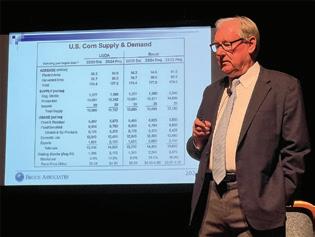
Autonomous helicopter could be the next big thing for unmanned ag spray applications as Rotor strives to market the “world’s biggest spray drone.”
BY RANEY RAPP Raney.Rapp@FarmProgress.com
Agricultural spray drones are quickly revolutionizing the way applications are achieved on-farm. Drones offer quick solutions, less user interfacing with chemicals and flexible spraying in difficult topography.
The catch-drone size and spray capacity just can’t top a ground rig or plane application. Rotor Technologies is a New Hampshire-based company, with its sights set on filling the high-tech, high-capacity autonomous ag application void.
“The Sprayhawk is an automated remotely piloted aerial application aircraft,” said Charlotte Keys. “We’ve taken a Robinson 44 helicopter and created it to be able to be piloted from the ground.”
In person, the effect is striking. The Sprayhawk boasts a 30-foot spray boom, 110-gallon spray tank and an estimated application rate of 240 acres per hour. A precision machine with a conspicuously barren cockpit.
Essentially, Rotor’s Sprayhawk – like many other ag drones – offers a method of autonomous aerial spraying.
“Sprayhawk is an agricultural drone, and it’s used mostly for aerial application,” said Nik Coates, vice president of partnerships. “A couple of features that it has that you might be interested in knowing about include its camera systems, LIDAR and trip planning system through AG-NAV, where you can waypoint find and set up your rows to be able to do your crop spraying.”
The difference with a Sprayhawk is all about size, capacity and efficiency. As drones try to top the competition by increasing size and weight, Rotor makes use of an existing aircraft platform to streamline technology development.
“You have more capacity with this. You have 110 gallons worth of water and chemical capacity, and because it’s built on a Robinson R44 platform, you’ve got 30 gallons of gas to work with,” Coates said. “You get a lot of endurance, you’ve got a lot of speed, you’ve got all the good stuff that a helicopter has, but also got some of the good stuff that a drone has with precision.”
Rotor simplifies the in-air component to maximize application ability by focusing weight on the most important components.
“The way we get more of the capacity is really because we take the pilot out, and because we take out some of the instrumentation,” Keys said. “It allows us to have more weight for carrying capacity, as well as product and the spray boom.”
The components that would typically find a home with the pilot in the cockpit also move from in-flight to on the ground. Each Rotor Sprayhawk has a control station component to manage flight paths and application abilities.
“It comes with a ground control station that allows the pilot to remotely pilot from the ground,” Coates said. “It will have displays that allow you to see what’s going on with the situation around you and be able to make decisions and work with the helicopter to get the job done.”
A Sprayhawk is recommended to be piloted by a total crew of three – a remote pilot, an in-field observer and a spray tank filler. While it’s good to have a ground crew to look out for issues and assist in labor, Keys said air to ground communication should not be an issue.
“We add six or seven different communications links. That includes line of sight radio cell or LCD coverage, as well as satellite,” Keys said. “You should not be losing contact with the aircraft at all. With the communications supporting those features, you should be able to fly a spray pattern or do terrain following autonomously.”
The big question is – how much does it cost? For current owners of Robinson R44 aircraft, retrofit kits are being created with an MSRP of $700,000. For aerial application companies looking to purchase a new Rotor Sprayhawk, the 2025 MSRP is currently $1.5 million.
It’s a hefty investment for new aerial spray aircraft owners, but for farmers looking to hire the service, Keys estimates an application cost of around $2 per acre.
Currently, Rotor Technologies has two production prototypes, including a model debuted at the Farm Progress Show in 2024 in Boone, Iowa. The prototype was also recently flown at Ft. Worth at an event showcasing new technologies for aviation leaders.
The next step is flight testing ahead of joint operations with U.S. members of Rotor’s Joint Development Program. The end goal is product availability for interested pilots and applicators across the U.S.


Marty Matlock, a professor of biological and agricultural engineering, is a leading author of the recently published report “Potential for U.S. Agriculture to Be Greenhouse Gas Negative,” which was presented at the U.N. Climate Change Conference. (Photo by U of A System)
• U.S. agriculture has potential to be greenhouse gas negative
• Report was presented at U.N. Climate Change Conference
• Five major areas of opportunity highlighted
BY AMY GIMPEL
Biological
and Agricultural Engineering Department
U of A System Division of Agriculture
As delegates from around the world convened in Baku, Azerbaijan, for the U.N. Climate Change Conference, a new report suggested that agriculture could become greenhouse gas negative.
Marty Matlock, a professor of biological and agricultural engineering with the University of Arkansas and the University of Arkansas System Division of Agriculture, is a leading author of a recently published report, “Potential for U.S. Agriculture to Be Greenhouse Gas Negative,” that was presented at the conference on Nov. 20.
“U.S. agriculture has the technologies and practices necessary to achieve greenhouse gasnegative agriculture this decade,” said Matlock, who conducts research as part of the Arkansas Agricultural Experiment Station, the research arm of the Division of Agriculture.
Matlock’s co-authors on the report include Jerry L. Hatfield, retired U.S. Department of Agriculture Agricultural Research Service laboratory director; Ying Wang, former research associate with U.S. Farmers and Ranchers in Action; and Charles W. Rice, University Distinguished Professor at Kansas State University.
At the conference, Rice presented the report’s findings and highlighted how agriculture provides food security, supports livelihoods and accelerates progress to limit climate change and enhance biodiversity.
Carbon dioxide is released back to the atmosphere through processes associated with agricultural production, along with methane from ruminants and nitrous oxide from nitrogen fertilizer use. The report shows that U.S. agriculture, which currently accounts for roughly 10% of total U.S. greenhouse gas emissions, has the potential to reduce its footprint and become a “carbon sink.”
Carbon sinks reduce atmospheric greenhouse gases by capturing or storing carbon in another form. For example, trees and cover crops can sequester carbon, while anaerobic digesters can capture methane by using bacteria to maximize manure breakdown in sealed vessels where methane-rich biogas is generated.
Matlock noted that the authors see greenhouse gas-negative agriculture as a promising and achievable path forward. The report presents five major areas of opportunity:
• Soil carbon management
• Nitrogen fertilizer management
• Animal production and management
• Efficient energy use
• Closing the crop yield gap
More aggressive adoption of regenerative practices in these areas provides the opportunity for U.S. agriculture to more than offset its carbon footprint, Matlock explained.
“This report, co-authored by 26 of the nation’s leading agricultural scientists, provides a clear pathway for achieving this goal,” Matlock said. “But only farmers and ranchers can make this happen, in partnership with our land-grant universities and USDA,” Matlock said.
Matlock noted that the authors recommend that producers, researchers and stakeholders across the agricultural sector and beyond review the report and consider how they can support the vital role that farmers and ranchers play in our lives and our national security.
Read the report for free here: https://bit.ly/3O8hbOo.
Source: University of Arkansas System Division of Agriculture
Thanks to industry partnership, AgCenter learns Louisiana’s most widely grown rice variety has low glycemic index
BY OLIVIA MCCLURE Louisiana State University AgCenter
People in Louisiana love to eat rice. So when an LSU AgCenter-developed rice variety offering a low glycemic index and a boost in protein hit store shelves a couple of years ago, customers took notice.
The Frontière variety has a lower glycemic index than standard rice, meaning it won’t spike blood sugar levels as quickly. It can be a better choice for people with health conditions such as diabetes — a trait that has made Frontière both a culinary and commercial hit. It was developed by Herry Utomo and the late Ida Wenefrida, scientists at the AgCenter H. Rouse Caffey Rice Research Station near Crowley.
Thanks to a collaborative effort with Supreme Rice, the AgCenter recently learned that another of its varieties, PVL03, has a low glycemic index. PVL03 happens to be the most popular rice variety in Louisiana, accounting for more than 30% of the state’s nearly 470,000 rice acres.
This finding could help put low-GI rice in the hands of more consumers and allow more farmers access to higher-yielding, low-GI varieties.
“This is an example of how valuable the LSU AgCenter Rice Research Station is to the rice industry,” said Bobby Hanks, CEO of
Supreme Rice, a Crowley-based mill. “Their relentless efforts to bring new and improved varieties to the market is helping our industry to survive.”
He added that his company has already launched its own line of the popular variety called Supreme Rice Low Glycemic Long Grain.
“This product has already begun distribution and is available for purchase,” Hanks said.
The journey to discovering PVL03’s lowglycemic qualities began several months ago when Supreme Rice leaders became curious about the glycemic index of varieties commonly grown in Louisiana. Adam Famoso, an AgCenter rice breeder and director of the Rice Research Station, put them in touch with a company in Canada that did the glycemic index testing on Frontière and suggested four additional varieties to screen.
“The process for testing GI in rice involves human subjects in controlled studies and is very expensive, thus we are not able to routinely evaluate lines,” Famoso said. “With Supreme Rice’s interest in doing their own research, we were able to learn more about our varieties through the testing they did independently.”
Glycemic index is measured on a scale of 0 to 100, with most rice considered to be in the 70s. GI values less than or equal to 55 are clas-

sified as low. Medium GI ranges from 56 to 69, and high is 70 and above.
The results revealed that Frontière and PVL03 have essentially identical scores and were the only two varieties tested that were in the low-GI classification.
PVL03 has been widely adopted throughout Louisiana’s rice-producing parishes since the AgCenter released it in 2021. PVL03 has high yield potential, strong disease resistance and excellent grain quality. The variety is part of the Provisia system, which allows growers improved options to control grass weeds in their crop.
Famoso was happy to hear the news about PVL03’s low glycemic index.
“This is a good example of how industry questions and investments can benefit and steer our research,” he said. “Future research questions that we would like to pursue include whether other varieties we have also are low GI.”
Famoso wants to explore whether specific amylose classes are associated with higher or lower glycemic index values. Amylose is a polysaccharide that makes up starch — and the more amylose rice contains, the less sticky it is when cooked. Consumers in different parts of the world have varying preferences when it comes to rice texture, so amylose content is already on the radar of the AgCenter breeding program.
“If we can determine which varieties or classes are low GI, it could be possible for the U.S. to market its export and domestic rice as having the unique characteristic of being low GI and a healthier product compared to other global rice,” Famoso said.
Source: Louisiana State University AgCenter
PVL03, a widely grown rice variety developed by the LSU AgCenter, was recently found to have a low glycemic index. (Photo by Horizon Ag)
BY WHITNEY SHANNON HAIGWOOD whitney.haigwood@farmprogress.com
Planning next year’s crop revolves around many factors, and for Midsouth rice farmers, a tighter seed supply is one big consideration. Here is what three major seed companies had to say about rice seed availability in the coming growing season.
Seed production goes hand in hand with planted acres. For over a decade, planted rice acreage was quite predictable. However, that predictability shifted in recent years, leaving little rice seed to carryover.
To better understand the situation, Farm Press spoke with companies in the rice seed arena: Tim Walker, CEO of Horizon Ag; Garrison Hardke, U.S. Marketing Manager for RiceTec; and Scott Greenwalt, Regional Rice Agronomist at Nutrien Ag Solutions.
Walker said rice seed production is very calculated year in and year out. “It is not just on what our markets are doing, but also what corn, soybean, and Latin American markets are doing. That all goes into our prediction in terms of how much we need to produce.”
Since 2010, rice acres were in what Walker described as an “up-down” cycle. Year over year there was a swing of around 300,000 acres. Typically, even years were higher planted rice acres at 2.3 and 2.5 million overall. Odd years saw more like 1.9 to 2.1 million planted acres.
That pattern reversed in 2022, when the expected increase in rice acreage from the year before did not happen. Then, 2023 was a big rice year. Acreage remained up in 2024. As a result, seed supply tightened.
This led RiceTec, the largest player in the rice seed market, to increase production acres in 2024. Hardke said, “We increased production acres by 70% over last year, because in 2023, we had no carryover seed. We needed a huge 2024 production year to supply the 2025 crop. We knew it was all riding on that production, because there was no safety stock.”
Unfortunately, weather impacted that plan when RiceTec’s primary production area in Texas suffered property damage caused by Hurricane Beryl. Then rains further reshaped the plan.
“It rained for 10 days straight, and a lot of those areas got 20-plus inches of rain, which increased disease pressure and led to poor grain fill in a critical time,” Hardke said. Now RiceTec estimates around a 30% reduction in supply for 2025.
Hardke said, “At RiceTec, our first priority is our obligation to our growers and the industry. As soon as we realized what was happening, and we knew we were not going to have the seed supply we had hoped to have, we tried to get that information out as early as possible, so farmers could make or change their plans.”
Looking ahead, rice acres are anticipated to remain up in 2025. Ultimately, farmers may not get the exact variety or as much of a variety as they want. Hardke said RiceTec loyalty customers will have priority. Then other companies are prepared to pick up the slack.
For Horizon Ag, Walker said in a normal year there would be ample supply of rice seed. However, it depends on how much of the seed run the company picks up. “We will do our very best to meet the demand, but there is a possibility we will not.”
As for Nutrien, Greenwalt said, “Generally speaking, we are in pretty good shape with seed supply. Based on our 2-year production plan, we are sitting in position for 400,000plus acres.”
Much of the agricultural infrastructure in the Midsouth is centered around rice. Farmers are locked into the high revenue crop with equipment, grain storage, and labor. They rely on the cash flow of the rice crop to maintain the stability of their operations.
This could leave farmers with big crop planning decisions this year, and each company provided perspective. Greenwalt said, “The earlier that growers have a plan in place, the better a retail location is going to be able to accommodate them.”
If supply of a particular variety is short, Greenwalt said growers
Planted rice acreage that was once predictable has shifted patterns, with acres inching higher the past three consecutive years. That, in addition to hurricane weather, tightened seed supply for one of the largest players in the market.
should focus on picking the herbicide technologies they need most. Then, consider the planting window and how that fits into the scheme of adjacent crops.
Hardke added that kicking the season off right is key, especially knowing the status of rice seed supply. “If we do not have enough to plant the first time, we certainly do not have enough for replants. You want to put that crop in a good situation with a good seed bed, adequate soil moisture and soil temperature, and we must start clean.”
Rotating crops is another consideration. Hardke hopes that farmers evaluate where they truly need rice acres. “It has to do with soybean yield potential on a particular field. There are some fields that can make an adequate soybean yield. So where do you need that rice acreage the most?” he said.
Another piece of the puzzle is seed quality. Walker emphasized the importance of knowing whether your seed is certified. Seed laws require germ testing, and certain requirements must be met for the seed certification.
“I think growers need to understand that those state and national seed laws are there to protect them, and the integrity of companies. We firmly believe that our integrity is much better validated by a third party, a tried and trusted non-biased agency,” Walker.
Story provided by Delta Farm Press.
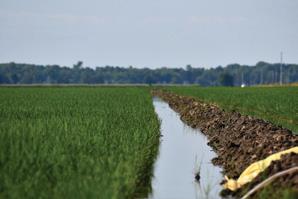
The Jennifer Cox Smith Teaching Kitchen, as part of the new Northeast Rice Research and Extension Center, is a tribute to her passion for cooking and serving others.
BY WHITNEY SHANNON HAIGWOOD whitney.haigwood@farmprogress.com
This past September, the University of Arkansas System Division of Agriculture celebrated the grand opening of the Northeast Rice Research and Extension Center. It is the first land-grant research center built in the state in 100 years, and this cutting-edge facility is one of a kind.
In addition to research, NERREC is focused on education and outreach, particularly to teach about rice. The center is complete with a greenhouse, classroom, and demonstration kitchen – and there is a heartfelt story behind this state-of-the-art kitchen.
The demonstration kitchen was sponsored by Windmill Rice Company in honor of Jennifer Cox Smith, late wife of David Smith, company owner. Smith lovingly shared the sentiments behind the sponsorship in his speech at the NERREC grand opening on Aug. 30, 2024.
You see, Jennifer was well loved by the local community. She was known for her genuine hospitality and being a phenomenal cook. Smith sat down with Farm Press for an interview to recount how it all started.

The legacy of Jennifer Cox Smith is honored through Windmill Rice Company’s sponsorship of the demonstration kitchen at the Northeast Rice Research and Extension Center located just outside of Harrisburg, Ark. Her portrait is displayed as a tribute to her love of cooking and kindness to others. (Photo by David Smith)
As a kid, Smith grew up off a gravel road, where he and his family farmed in Alicia, Ark. His father taught him to drive a tractor and a semi-truck at an early age. Smith looked back at his teenage years, when there were 15 to 20 different locations where they could sell the rice crop. In time, those options dwindled to less than five.
Smith continued farming the family land into adulthood, and in 1995, he married Jennifer, who was also from an agricultural background. Smith described her as a compassionate woman and the love of his life.
“Jennifer was an incredible woman. One of her many talents was being a fantastic cook,” he said. “The first six months we were married, I gained 50 pounds.” Smith likened the home-cooked meals Jennifer prepared daily as being comparable to a Thanksgiving feast.
Jennifer not only cooked for Smith, but she also cooked for their farm workers. During harvest season, Smith said Jennifer would wake at 5 a.m. every day, seven days a week, to cook lunch for their farm crew. Then, she would deliver those meals to the field.
Smith recalled how Jennifer’s home cooking and delivery created a harmonious atmosphere amongst the workers and kept the farm running smoothly. “I did not have a man miss a day of harvest for 15 years,” he said with a chuckle.
When Smith was around 45 years old, he and a group of partners decided to build a rice mill. Ground was broken for Windmill Rice Company in February 2007. The mill was up and running by May 2008.
Smith said, “We started bringing in rice from my farm and neighboring farms. We milled it, put it in the tank, packaged some of it, and sold some for bulk. Since then, we have been growing and expanding.”
In the office of the mill, they built a full kitchen just for Jennifer. There she made lunches for workers and entertained clients for dinner, pouring out her genuine hospitality with every dish. Smith said, “Jennifer was very much involved, and she made employees and customers feel special.”
Smith continued to farm in addition to operating the rice mill. By 2018 he was farming close to 11,000 acres. Then life brought about the unthinkable. On April 4, 2018, Jennifer passed away.
Smith tenderly recalled the evening of Jennifer’s visitation. “The outpouring from our friends – and friends I did not even know she had – was overwhelming,” he said. “She was well loved, and she touched so many lives.”
Gripped with grief, Smith decided to hang up his farming career soon after Jennifer’s passing. He pressed forward, focusing on the rice mill operation.
Then, an opportunity arose to honor Jennifer’s memory. Smith said he was approached by the University of Arkansas and asked for a contribution to help construct NERREC, located on a site just a few miles from Windmill Rice Company. This opportunity would come with naming rights within the building.
When Smith learned of NERREC’s plan for the demonstration kitchen, he discussed the idea of sponsoring the kitchen with his business partners, Randy Woodard and Jerry Cox (Jennifer’s father). Together they decided it would be a great way to honor her legacy.
Today, Jennifer’s portrait hangs in the Jennifer Cox Smith Teaching Kitchen at NERREC. “I have received countless phone calls complimenting us on the sponsorship, because Jennifer was such a well-known, wonderful person,” Smith said.
NERREC opened its doors this past summer, with over 400 attendees at the center’s grand opening. There was a full slate of speakers, including a keynote address delivered by Arkansas Gov. Sarah Huckabee Sanders. Other speakers were legislators, stakeholders and building sponsors.
The presentations were followed by facility tours, and the event was complete with refreshments. Of course, Jennifer’s kitchen was bustling to serve the large crowd who gathered in the grand atrium of the building. She was certainly there in spirit.
The Jennifer Cox Smith Teaching Kitchen is part of the educational outreach component of the center. It is equipped with a camera system so rice cooking demonstrations can be displayed on a large screen, adjacent to the kitchen. The intention is to teach visitors about how rice is cooked and allow them to experience the taste and smell.
Behind the demonstration kitchen is a full-size commercial kitchen, with an attached loading dock. NERREC Director, Tim Burcham said, “I never

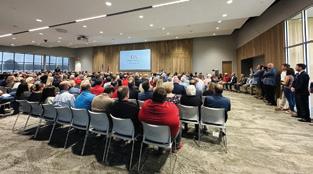
anticipated just how much we would use the kitchen, but in just a short time, we have already used it more than I ever imagined. Caterers love it. They can back into the loading dock, and everything is set up for them.”
Thanks to Windmill Rice Company’s sponsorship of the kitchen, Jennifer continues to serve others. Every dish prepared at NERREC is a tribute to Jennifer’s kindness to others and her love of cooking.
Other educational components at the center are a classroom with an attached greenhouse, which allows visitors to learn about rice and experience a variety of plants growing year around.
To learn more about NERREC, visit the U of A website at https://aaes. uada.edu/research-locations.
Story provided by Delta Farm Press


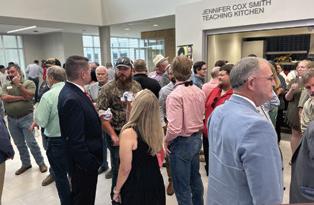
BY RANEY RAPP
Raney.Rapp@FarmProgress.com
Ten southern states cooperate to test top performing cover crops through the Southern Cover Crop Variety Trial. A unique cover crop variety trial started at University of Tennessee in 2019 joined with the Southern Cover Crops Council in 2022 expanded cover crop data over a broader region, combining university research with industry input to put cover crop varieties to the test in unique growing environments.
“We trial whatever industry wants to plant,” said coordinator Virginia Sykes, University of Tennessee. “Every year we send out a call for entries, the same as we do for our corn and our soybean variety trials.
And whatever industry is interested in trialing, that’s what we trial. The good thing about it is we can always provide information that is highly relevant to our producers.”
Cereals, brassicas and legumes were tested on the basis of establishment, weed cover, biomass and nitrogen release to help guide farmers into finding the best cover crop fit. Varieties enrolled in the trial typically follow trends in industry, with noticeable changes from 2023 to 2024.
“The varieties we evaluate change from year to year. Overall, 10 of the 20 cover crop varieties evaluated were the same across the last two years,” Sykes said.
In 2024, the rise of oat varieties followed a drop in brassicas, with just one radish put to the test this year. Despite changes in region
and growing conditions, varietal performance in the trial remained consistent for some stand-out entries.
For testing purposes, cover crops in the multi-state trial are treated exactly the way farmers would be utilizing the seed in the field, with an eye toward performance ahead of cash crops.
“Typically for cover crops, we’re not going to fertilize them in the fall, because our goal is for this to be a cover crop, not a secondary crop,” Sykes said. “The last two years we’ve also provided information on forage quality for some locations. And so, we do have additional information on crude protein, total dry matter digestibility. But our primary goal for this is
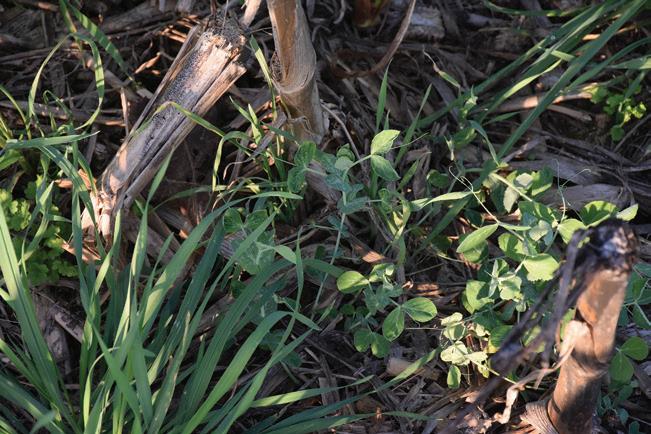
just to see how much biomass we would get, pre-soybean and pre-corn.”
Checking biomass results is relatively simple, but the benefits of regional knowledge of biomass performance, especially in relation to growing conditions, can help farmers make educated selection decisions.
“We do two biomass ratings where we measure how much cover crop is out there in the field at those two time points, presoybean and pre-corn,” Sykes said. “Because typically, the more biomass you have, the more benefits you’re going to get from cover crops.”
While two varieties of cereal rye – FL405 and FL406 – topped the biomass scale at over 9,000 pounds per acre, Sykes said the trial produced a wide variation in biomass from location to location.
“I think that’s important, because our producers in Tennessee might be looking at data out of North Carolina and thinking, ‘Oh, I can get 10,000 pounds per acre of biomass,’ and that might not be something that’s as feasible in our region,” Sykes said. “The regional information is good for seeing how much this biomass actually varies from location to location.”
In addition to biomass, the Southern Cover Crops Variety Trial also focuses on released nitrogen. AU Easy Cover Vetch topped the nitrogen category with an estimated 75 pounds per acre of nitrogen released. FIXatioN Balansa Clover was a close second with 60 pounds per acre.
“The past two years, we also evaluated some of the varieties for forage value and nitrogen release, with funding from the Tennessee Corn Promotion Board” Sykes said. “We will take that biomass, dry it down, run it through the near infrared spectroscopy and that’s what gives us the forage nutrient values, including nitrogen content.”
In addition to the basic forage nutrient evaluation, techniques used by the Southern Cover Crop Variety Trial can help pinpoint just how much nitrogen a cover crop will leave behind.
“We can input those nutrient values, along with location and termination date, in the precision sustainable agriculture nitrogen calculator,” Sykes said. “That’s going to give us a more precise estimate of how much nitrogen you would expect from the cover crop to go to the subsequent cash crop.”
Planting dates for the Southern Cover Crop Variety Trial begin in mid-October. The 2025 varieties have already been planted for next year’s results. Sykes said the distribution of the trial shifted to include more brassicas again this year, as well as including two completely new entrants – ervil and carinata.
Sykes said ervil, also known as bitter vetch, is a completely new species to the trial and carinata is typically studied for seed production rather than biomass, so it will be interesting to see how each performs.
Overwhelmingly, Sykes said the trial studies find that selecting both a quality species and variety makes a difference for cover crop

quality. The finite details explored in the test can help farmers navigate the selection process. To read the full report visit https://search. utcrops.com/cover-crops.
“The surprising thing was that in a lot of regions, many of the top performing species and varieties were the same, where I expected there would be more variation in what did best regionally,” Sykes said. “The exception to this was in the clovers, which did show a lot of variation from state to state and between termination timings. This also changes from year to year, with less consistency across locations in 2024 compared to 2023.”
Variety continuity over time, as well as continued participation in the project can help researchers get a clearer picture of cover crops and their capacity to change crop productivity over time.
“Continuing this trial will give us a much clearer picture of what does best regionally,” Sykes said. “This has really been a highly collaborative effort that wouldn’t be possible without support from scientists across the South, putting in the work of planting and evaluating these trials each year, and from our industry partners who enter their varieties into the trial.”
Story provided by Delta Farm Press.
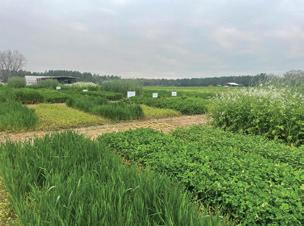
Soybeans following corn have worked on-farm in South Carolina, could the
BY RANEY RAPP Raney.Rapp@FarmProgress.com
Double cropping is not a new invention and in the right environment, it can have a positive impact on farm profitability by maximizing time and resource in a single season. In South Carolina, farmers continuously farming irrigated corn in sandy soils on the Coastal Plains have been experimenting with double cropping corn and soybeans – with some success.
“This is not really a new concept. We’re growing a crop, coming in with harvest immediately, and planting something else,” said Clemson University Extension specialist Michael Plumblee. “We’ve done this for several years in South Carolina with small grains and soybeans. That was our rotation for a long time, and we have kind of again shifted away from that, just because we’re not growing as much wheat.”
Farmers were looking for another double cropping solution to break up continual corn production, for profitability, but also to impact soil health, weed and disease pressure. The result was to test out a system the state’s Georgia counterparts had likewise tried – following corn with soybeans in a single season.
“About four years ago, we estimated we had 3,000 to 5000 acres of this being tried at varying levels, and a lot of different recommendations and different practices going on,” Plumblee said. “Since we’ve been doing this research, we’ve probably increased the acreage at least in a few counties, to over 20,000 acres, and we have more of a consistent effect.”
The gist is this: Grow a full-season corn crop with the normal focus on yield and management, cut it quickly at high moisture and immediately plant soybeans with the goal to make a crop before first frost as cheaply as possible.
Simple? Sure. Plumblee said the strategy holds up even with farmers ruthlessly in pursuit of the best profitability for their farms.
“A lot of our growing mentality in that area is very similar to Mississippi, where they’re very aggressive,” Plumblee said. “They’re going to make sure it pencils out and then they’re going to do it right.”
• Planting Date
Planting dates were equally critical for both the corn and soybean crops. Planting the corn in March and following with soybeans no later than the first week of August seemed to be the sweet spots on-farm.
“The hybrid selection on corn didn’t matter as much as relative maturity, but the march planning dates seem to be critical,” Plumblee said. “As well as harvesting at 20% moisture content or higher - anywhere we let it field dry was way too late when we got the soybeans in to stand a chance.”
Knowing a March plant date and high moisture picking worked best helps guide planting for the soybean crop – in which timing was equally critical.
“When we looked at the soybean yield across all these different planting dates, we had some plots that we were pushing 50 bushels, but I’d say the average is probably 25 to 30 bushels on some of our earlier planting dates,” Plumblee said. “The later we plant, we’re really reducing our yield.”
Yield reduction to the tune of a .4 bushelper-acre per day after harvest farmers waited to plant the soybean crop – a significant drop to signify time is of the essence.
“A lot of the guys double cropping are seriously chasing the combine with the tractor, planting behind it,” Plumblee said. “They’ll plant all night if they have to just try to get the soybeans in, because they know that every day matters.”
• Residue Management
Planting behind the combine brings up another challenge to the double cropping system – managing tall corn residue. For farmers intent on pursuing double cropping, Plumblee said investing in residue management tools like row cleaners or choppers helped the system flow more smoothly.
“A lot of the growers that have really adopted this have started to invest in some equipment to help with some of these challenges,” Plumblee said. “One of those being a stalk chopping corn head, so that after they’re done harvesting corn, the field is basically prepared to be planted. Confetti chain rolls also are a big help in this system, to chop up the residue ahead of the planter.”
Managing residue helps the soybean crop establish more quickly, which is important when time is of the essence.
• Plant Height
“One thing that we identified very early with some of the farmers that were already
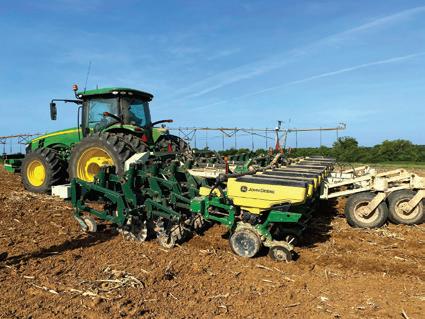
doing this practice is that plant height is absolutely critical,” Plumblee said. “We can make 30 bushels, but if the plants are only five inches tall and we can’t get them into the combine header, we’re not really doing a whole lot of good.”
Soybean varieties with a tall stand and a maturity group five performed best in trials and on farm. Plumblee said group four did not perform well in the system, despite high expectations.
Overall, soybean planting is highly dependent on corn planting, so variety selections need to be made in tune with one another.
For double cropping to be an option, South Carolina has seen the best results in sandy, irrigated soils. With only about 20% of farm ground in South Carolina under irrigation, Plumblee said the system is not a fit for everyone.
Soybeans grown in the system are continually battling the first frost, which comes at a similar time of year in South Carolina as it does in Delta states.
“We’re kind of on the same latitude as Mississippi, and our first frost date is only
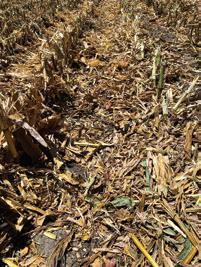
about Nov. 8,” Plumblee said. “The first year that we did this work, we did have an early frost about Oct. 16. At that time, a lot of these soybeans were about V6, so it would have been similar to accidentally desiccating too early. We estimated we had about 10% to 15% loss.”
Although the results were disappointing, Plumblee said experiencing loss actually encouraged some producers to push forward.
“It wasn’t a total flop. We still made some soybeans,” Plumblee said. “I think that made people feel a little bit more comfortable with doing the system after we had an early frost and it wasn’t a total failure. Obviously, no crop insurance on these type of soybeans is a little bit more risky.”
Farmers saw positive profitability results when corn was prioritized. Planting a productive variety at a good planting date and then treating it with an eye toward yield helped producers reach goals they typically would set for single crop corn.
When following with soybeans, Plumblee said farmers saved money by cutting additional nitrogen applications, which had no impact on yield. As well as backing down their
tyical seeding rate for soybeans from 180,000 seeds per acre to closer to 150,000 seeds per acre to save on seed costs.
With those changes, farmers double cropping essentially had the same profitability projections as full season corn – with some additional drying costs - plus the profitability of the entirety of the soybean crop, which pushed the potential profit for a double crop beyond continual corn.
“The potential is there. I think the mentality and the mindset to get them in, get them cut, and the equipment set up has got to be there,” Plumblee said. “We keep learning more and more about this system as we go. We’re able to spread the cost of equipment across two crops on one calendar year. We’re not having volunteer corn come up after we harvest, and we’re seeing a lot of other added benefits.”
Story provided by Delta Farm Press.
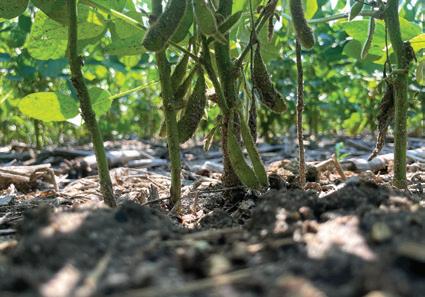
BY WHITNEY SHANNON HAIGWOOD AND MINDY WARD
Whitney.haigwood@farmprogress.com
Mindy.ward@farmprogress.com
As Hurricane Helene hit southeastern Missouri in September, Mike Bernard received a surprising call from a client in northeast Arkansas: soybeans were sprouting inside their pods. “I immediately drove to his farm, then to mine,” the owner of White & Associates–Bernard Crop Insurance and soybean grower from southeast Missouri said. “I found the same conditions in many fields that were ready for harvest. Then a few days later, mold showed up.”
Over the following weeks, Bernard had crop insurance clients from five of the Missouri bootheel counties, four counties in Tennessee, and 4 counties in Arkansas reporting similar soybean crop damage.
While the 2024 growing season began with promising weather conditions across the Midsouth, it ended with disappointment and financial strain due to drought, an untimely hurricane, and subsequent quality issues.
Farmers began dialing University of Missouri State Cropping System Specialist Justin Calhoun’s number, voicing concerns over soybean discoloration, mold and sprouting in the pods, and shriveled beans with low test weights.
Calhoun walked fields to investigate the problem. These quality issues persisted through much of the first half of soybean harvest, and he concluded the cause was environmental factors, particularly in the earliest planted soybeans.
While early planted beans are shown to improve yield potential, this year’s weather conditions set them on a collision course.
“I would say at least 30% of the soybean crop was damaged,” he said. “A lot of our soybeans were planted during the early planting
window, and it seemed like everything we planted early had some type of quality effect on it.”
At the end of the summer, during July through August, a hot, dry drought period took hold of this region, causing shriveled soybeans and low-test weights.
“For some of these earlier planted beans,” Calhoun said, “we were so far along in our physiological maturity, there was not enough recovery time after that drought for them to make up for quality.”
Then September hurricanes settled in, first with Hurricane Francine. Later, Hurricane Helene dumped rain across the Missouri Bootheel. Calhoun said this magnified quality issues like discoloration, molded beans, and sprouting in the pods.
The impact was felt by farmers all the way to the elevator.

Given the damage to the soybeans, farmers anticipated some discounts, but were surprised by the extent of the dockage.
Bernard, who farms 4,300 acres of soybeans with his son, explained, “Some elevators even increased their discount schedules once the damage became widespread. This, to me, is the equivalent of going to the doctor, and during a procedure, he informs you that he is doubling his fee.”
Willie Frazier manages the Neelyville Farm Center as part of Baltz Feed Company, which serves roughly 60 farmers spanning from the Missouri bootheel to northeast Arkansas.
Early in the 2024 harvest season, the grain elevator saw deliveries of damaged soybeans. The loads came in with anywhere from 5% to 25% damage. Even on the low side, Frazier said quality loss was higher than in a typical year.
“Usually there might be 2% to 3% damage, but it was much worse this year,” he said, noting it as the most severe soybean damage reported since 2009.
He explained that at Neelyville Farm Center, any soybean delivery over 5% damage is subject to rejection. If the elevator accepts the load, farmers face dockage.
For instance, if a load reaches 14% quality loss, the farm center docks 60 cents per bushel. For every percentage point over 14, there is an extra 10 cents docking fee per bushel.
So, a truckload of soybeans at 25% damage calculates to a price reduction of $1.70 per bushel--a steep cut in an already tough year. And that is if there is only one fee.
According to Blake Barlow, director of agronomy and research for the Missouri Soybean Association, some growers experienced an adjustment trifecta-quality, test weight, and splits
As a federal crop insurance provider, Bernard understands firsthand the limitations of coverage in this scenario.
Many farmers expected insurance to cover their losses, but the damage profile complicated claims.
“If a farmer experienced the mold and damage, yet harvested a normal yield, then the farmer would more than likely not qualify for any federal indemnity,” he explained. “If the farmer had a yield loss and had damage as well, then an indemnity is more likely.”
Bernard said payment depends on unit structure, actual production history, and level of coverage, but went on to add that “100% of my farmers have experienced loss, but very few will have payable claims.”
The devastation has been felt widely, with even some of the largest producers reporting steep losses.
Barlow noted that farmers harvesting soybeans before the hurricane reported yields as high as 80 bushels per acre, marking one of the best potential seasons in years. But posthurricane, farmers saw yields almost cut in half due to shriveled, disease-ridden beans. Given already low soybean prices, the timing couldn’t have been worse.
“It’s very disheartening for farmers,” he said. “They went into the season with such high hopes, with adequate moisture for the most part, and everything kind of aligned. Then just

at the last second, to have something like this happen, it really takes the wind out of the sails,
especially when prices are the lowest they’ve been in several years.”
Story provided by Delta Farm Press
BY VICKY BOYD Contributing Writer
After southwest Louisiana rice producer Paul Zaunbrecher read about the success Midwestern corn growers had with spray drones applying fungicide to their crop, he began thinking about his own situation.
“They were using water-sensitive paper in the furrows, and they were getting the fungicide farther down and it was actually hitting the ground,” he said.
In 2023, Zaunbrecher, who farms with his brothers Fred, Phillip and Bill as GF&P Farms near Duson, hired a drone applicator to apply fungicide to a 40-acre rice field with highvoltage wires overhead. Although some drone applications may cost more than typical plane applications, he said the smaller crafts offer different benefits.
“Most (drone pilots) charge about $15 per acre, and airplanes are half that,” Zaunbrecher said. “But when you get down to the efficiency
of the chemicals on these particular fields, you can’t beat drones.”
In 2024, Zaunbrecher hired Josh and Dustin LeBeouf, who own Skytech in Kaplan, La., to treat 400 to 500 acres of rice. And he’ll likely have them fly additional acres this season.
Zaunbrecher said drones – also known as unmanned aerial vehicles or UAVs – work particularly well near sensitive areas, such as housing developments, roadways and highvoltage wires. He also sees them having a role should it rain, ground rigs can’t get in to spray the wet fields and airplane applicators are backed up because of high demand.
“Three years ago, I wouldn’t have dreamed we would be talking about this right now,” he said. “But it’s here. It’s more than just a thought – it works.”
Zaunbrecher isn’t alone in his quick adoption of drone technology to apply crop
protection materials, either. Louisiana State University AgCenter Rice Extension Weed Specialist Connor Webster said he saw a large increase in drone pesticide applications from the 2023 to 2024 season but couldn’t estimate the percent growth.
“I know there’s a big increase from last year (2023), but it’s hard to put a number on it,” he said.
LSU Ag Center State Rice Specialist Ronnie Levy agreed.
“There’s no question we had a lot more people that used drones to spray problem areas this season,” he said of 2024. “In the last couple of years, it’s really exploded. Some people are spraying all their fields with drones.”
Levy is one of those and has begun having drones treat all his research plots. Not only is the technology highly accurate when used correctly but it also offers improved worker safety, he said.
In the past, workers with backpack sprayers or riding all-terrain vehicles would apply the materials.
Levy said he also sees a place for drones to conduct spot spraying, treating only the part of the field infected with a disease or infested with a pest, thereby reducing pesticide use.
Because drone technology is still so new and, in many cases, ahead of pesticide labels and research, both Levy and Zaunbrecher said there are still many unanswered questions.
Pesticide labels in the U.S., for example, typically don’t provide information specific to drone applications. While some labels prohibit aerial application, most don’t specify the type of aircraft if they’re labeled for use by air.
The Environmental Protection Agency does allow drone application if the pesticide is already labeled for conventional aerial application and if Federal Aviation Administration drone rules are followed.
Currently, most drones apply volumes of 1.5 to 2 gallons per acre. Conventional aerial application volumes typically range from 2 to 5 gallons per acre, and ground rigs may apply up to 20 gallons per acre.
As with many pesticides, particularly contact products, coverage is key. But little research has been conducted looking at product performance at what some consider low- to ultra-low-volume rates. That’s something Zaunbrech hopes will change.
“Once Connor and they start using drones at the (rice research) station, they’re going to start documenting this,” he said. “They didn’t do a lot of work before with low volumes. Drones are going to force it and because of that, it’s going to be a good thing. At 2 gallons per acre, is it going to be effective? I’m just anxious for them to get the data on all of this.”
Where Zaunbrecher and other drone spray proponents also have questions are with adjuvants and other tank additives. The label may call for so many pints per large-sized tank, but can you just reduce the ratio for the drone’s smaller tank and still achieve the same results?
“We’re going to be learning together,” he said.
To see more new technology aiding growers to pinpointing troublesome areas, visit the Mid-South Farm and Gin Show on Friday, February 28 and Saturday, March 1 at the Renasant Convention Center, 255 N. Main Street, Memphis, Tennessee or go to farmandginshow. com
Story provided by Delta Farm Press

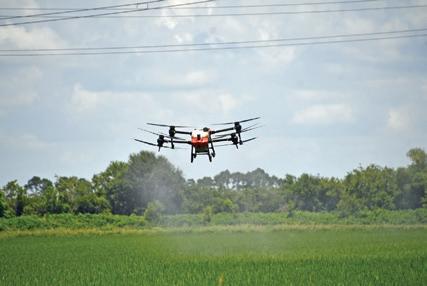

One live weevil in a sample could be enough for dockage at sale –a few simple steps can prevent or eliminate infestation
BY RANEY RAPP Raney.Rapp@FarmProgress.com
It only takes one. Just one live weevil per sample in some cases for a grain inspector to deem a load of corn originated from an infested grain bin – and then for the elevator to dock the price or reject the grain entirely.
As calls about what to do to prevent and treat insects in grain storage increase, Mississippi State University row crop entomologist Don Cook said it’s important to establish first what constitutes an infested bin before pursuing a treatment or prevention plan in following seasons.
For corn, in a 4,000-gram sample pulled by inspectors, there are three possible qualifications that can constitute an infestation.
• One live weevil and five other insects
• Two live weevils
• Ten other insects
If the sample meets any one of those qualifications, the grain from that bin is considered infested.
Maize weevil and rice weevil are the most common and considered the most destructive to stored grain. Other insects commonly found in grain samples include confused flour beetle, saw-toothed grain beetle and red flour beetle. Some of these insects can live up to two years in bins with little moisture or food. Many grain bin pests thrive on old grain dust alone, which makes cleanliness an important aspect of grain prep.
“When folks ask me, ‘What can I do?’ the best thing I tell them is to make sure you don’t have any old grain around,” Cook said. “That’s basically a source for infestation, just waiting for you to bring grain in.”
Cleaning out grain bins is standard practice before refilling, but for bins with a history of infestations or bins used in long-term storage, a higher level of clean could be required.
In these cases, removing all grain and dust not just from the bin itself, but also from often overlooked areas like sub-floors and augers, can help set storage up for success.
“Basically, starting clean helps avoid these problems,” Cook said.
In northern states where large grain storage facilities are more common, temperature helps play the role of limiting insect issues. But in the South, it can take time for bins to fall to the right temperature to limit insect movement, and a hard freeze to limit insect over-wintering might never come.
“Fifty degrees is where insect activity begins to slow down,” Cook said. “Sometimes that is not practical. When you cut in August and it’s 105 degrees when you put it in the bin, it’s going to be awhile before it reaches 50 degrees.”
If a storage facility or area has a history of insect issues, temperature isn’t conducive to good grain storage, or grain will be stored for an extended time, treating bins and grain at the time of storage can help avoid infestation.
If treating a clean bin with an insecticide prior to storing grain, Cook said adding piperonyl butoxide to the tank mix could help achieve greater control.
“If you run a pyrethroid, which is deltamethrin, put PBO with it,” Cook said. “PBO is a synergist. It makes all the difference in the world.”
Typically, treating the walls of any empty bin with insecticide prior to filling can help control grain-feeding pests – but only for so long, Cook said. Grain set for longer storage may also need to be treated with an insecticide before it enters the bin for an extended period of time. If a bin becomes infested, there are few remaining options for insect control.
“If you have an infestation in a bin, fumigation is your only other option and lot of folks don’t like to do that,” Cook said. “If you hire somebody, it’s expensive, but it is your only option, other than take the grain out, move it to another bin and treat it with one of the grain protectants.”
Cook said fumigation is a last resort and should be considered carefully before using that approach.
For stored grain insecticide uses and application recommendations in the Delta, check out University of Arkansas’ insecticide fact sheet here: https://mp144.uada.edu/
Story provided by Delta Farm Press.
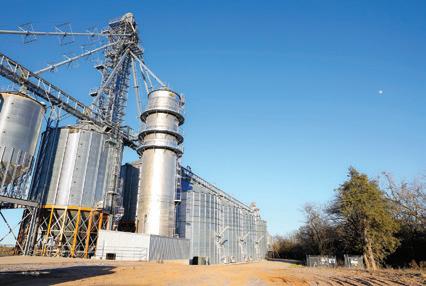
Check grain in long term storage for possible infestations and prepare bins properly to prevent pests.
(Photo by Raney Rapp)
Cottonseed is primarily sold for dairy feed, and second to that is oil crush.
Learn more about marketing this cotton byproduct from a broker, economist, and ginner perspective.
BY WHITNEY SHANNON HAIGWOOD whitney.haigwood@farmprogress.com
When you drive past a cotton field, you might think about soft-spun T-shirts, and a wellknown advertising slogan may come to mind. After all, cotton is the “fabric of our lives.” But within each of those cotton bolls are whole cottonseeds that contribute to another significant market – and famous ad campaign. “Got milk?”
Dairy cows consume more than half of U.S. cottonseed production. Whole fuzzy cottonseed is mixed into feed in bulk and is an exceptional source of protein, fat, and digestible fiber. Furthermore, cottonseed is shown to increase butterfat content in dairy milk production.
Higher butterfat content translates to premiums for dairy farmers, especially when milk prices are up. It is a win for the herd and the producer. Amy May Hopper, commodity merchandizer at The Andersons, said, “We refer to cottonseed as a Snickers bar for dairy cattle. They like it and it tastes good to them.”
The remainder of the cottonseed supply is processed and crushed for oil, and a small percentage (5 to 8%) is exported. So, what determines the price of cottonseed and what is the outlook for the value of this cotton byproduct?
The cottonseed market is complex, and the price outlook is influenced by two factors: cottonseed production based on the size of the cotton crop, and competing feed ingredient prices, such as soybeans.
John Robinson, professor and Extension specialist for cotton marketing at Texas A&M, considers himself a student of the cottonseed market. He said compared to last year, the USDA is projecting a bigger size cotton crop for 2024/25. So, year over year, we should have more supply of lint and cottonseed.
Plus, soybean prices are lower at this point. Last year, soybeans were sold at $13.00
per bushel. Now, they are closer to $10.00 per bushel. Robinson said, “I feel confident saying the direction of cottonseed prices should be lower, year over year, because of those two combined influences.”
As the crop is sold, monthly USDA projections of cottonseed are one measure of value. While these price trends are useful, ag economists say their level is not necessarily reflective of what a dairy is willing to pay for cottonseed. Price also fluctuates with other short-term influences like stress retention and logistics. In 2023, the U.S produced 3.68 million tons of cottonseed. Of that production, 2 million tons, or 54%, was marketed to dairy farmers. The remaining 37% of the cottonseed was crushed for oil, and a small percentage was exported. Hopper said logistics play a key role in cottonseed marketing. She also emphasized the importance of understanding both the dairy feed and oil crush markets.
“Regardless of your location, it is good to understand both markets, so you know what each are bidding. If you are in an area that does not have an oil mill, you probably need to partner with someone in the dairy market but keep aware of the oil mills’ influences in the market.
“Vice versa, even if you are tributary to an oil mill, stay aware of what is happening with dairy interest, as they alone could be a strong bid to push up the whole market,” Hopper said.
In most cases, the gin takes possession of the cottonseed, and it is stored during the ginning process. Then, cottonseed is either contracted to a buyer or sold on the open market. Hopper said, “Gins are the frontline of profitability for cottonseed, but if cottonseed is at a really high price, a lot of gins will give rebates to their farmers.”
From a broker perspective, Hopper explained that cottonseed trades to the dairy industry comparable to a grain as opposed to a feed ingredient. “Cottonseed is produced one time per year, then it is fed for 365 days out of the year. Managing the pipeline for the dairy farmers and for the gins who need it gone during harvest is a big part of the job and a big part why the market allows for merchants like us to exist.”
In Port Lavaca, Texas, Holly Edwards works the gin and handles marketing at the Moreman Community Gin Association. Edwards said cottonseed pricing starts at the beginning of the season, and the market is competitive.
Buyers range from dairy farmers to oil mills. “We contract a lot of the seed in the beginning. We also hold some cottonseed back, so we can get the best price in case the market goes up,” Edwards said.
The gin calculates the collections that need to be withheld from each producer for ginning and insurance. Logistics and freight are part of the equation. Then cotton producers are credited for seed brought in, and in some cases the credit will cover their ginning charges. It all depends on the market.
“Our goal is to get the best deal for our farmers, so we can give them a better rebate at the end of the season. They work hard all year round, so it is the least I can do to fight for their families to have a little extra in their pockets at the end of the season,” Edwards said.
When cottonseed is sold to dairy farmers, quality is important. Edwards is certified to test for aflatoxin. She said, “If you are selling to a dairy, aflatoxin is a big part, and we test the cottonseed to protect the dairy herd.”
For the 2024/25 marketing year, Jon Devine, senior economist at Cotton Incorporated, said the largest projected change in cottonseed demand is expected to come from feed. He also explained how the demand for cottonseed oil is consistent, due to the fixed capacity of cottonseed mills.
When sold for oil, the price of cottonseed is heavily influenced by the soybean market. Devine said, “Cottonseed represents just one piece of the oilseed market. Soybeans represent the largest piece of the oilseed world and are a primary driver of cottonseed prices.”
So, what can we expect when marketing our cottonseed? Devine pointed out that soybean stocks are forecast to build during the 2024/25 crop year in most major soybean producing countries.
“This suggests downward pressure on soybean prices, which suggests downward pressure on cottonseed prices. While soybean prices are influential, a way to support cottonseed demand is to keep cottonseed a preferred feed for dairy,” Devine said.
Plus, most major row crops face difficult conditions as farmers look toward planting the 2025/26 crop. Crop prices have fallen to 2019 levels and input costs have risen 30% higher. The good news is macroeconomic policies around the world have started to take a favorable turn.
Devine said the U.S., EU, and other markets have begun lowering interest rates. “While these rates are not expected to drop all the way down to stimulative levels, the fact they have reversed course suggests lighter headwinds for economic growth.”
We also have China moving to stimulus, which could emerge a positive boost to demand from the Chinese market. “Details have not been released yet, but expectations around the specifics may help markets,” Devine said.
Story provided by Delta Farm Press.
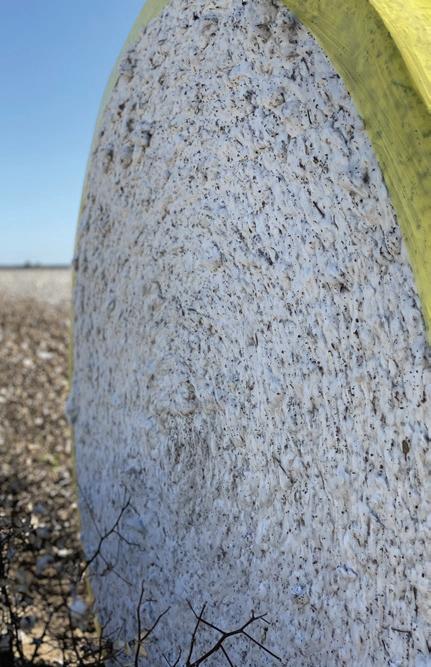
Farmer and Extension cotton specialist discuss research focused on the efficacy of soil biological products.
BY WHITNEY SHANNON HAIGWOOD whitney.haigwood@farmprogress.com
The agricultural biologicals market is steadily on the rise. By 2029, the market is projected to reach $31.8 billion, up from $16.7 billion in 2024. That is a compound annual growth rate of 13.8%, according to a report by MarketsAndMarkets. The problem is, some of these biological products do not work consistently –if they even work at all.
With applications ranging anywhere from $15 to $25 per acre, that can be a costly setback. Tyson Raper, Extension cotton specialist at the University of Tennessee is part of a multi-state study funded by Cotton Incorporated to investigate the efficacy of agricultural biologicals.
Raper said, “We are just beginning to understand how these products work and if they work. We are at the very beginning of what I think will be a long journey.”
He joined Matt Griggs, farmer from Humboldt, Tenn., to discuss research and development efforts and the results they have seen so far.
When it comes to soil biological properties, Griggs said there is still much to learn. This includes microorganisms, plant roots, organic matter, and the biological activity and communication between these biological components within the soil.
While Griggs sees promise in the future of biologicals, he has seen little success with products tested over the last five years through replicated plots on his farm. In most of these trials, he said there was clearly no extra money at the end of the season from applying a biological product.
Griggs said, “The key question is why do our biological products not work consistently? For one thing, we do not understand the biology of what is going on in the soil. So, we really do not know what products to use to address a limiting factor.”
He believes one thing impacting the effectiveness of biologicals is the focus on bacterial organisms as opposed to fungi. Griggs pointed out that biomass in agricultural soils is bacteria dominant. Results from a Phospholipid Fatty Acid analysis taken on his farm showed fungi to make up only 2% of the biomass.
Griggs said, “Why are we adding more of these bacteria biological products when it is already a bacteria dominant environment? Where I think we need to focus is on the fungi in the soil, like Arbuscular Mycorrhizae.”
He summed it up with an illustration. “If you think about a 6-inch acre slice, about 2 million pounds, you are adding an ounce or two ounces of bacteria with a biological product,” Griggs said. “That is like putting a drop of water in a swimming pool. How much are you really affecting?”
Before investing in biological products, Griggs stressed the importance of understanding your existing soil biology. “Pretty much anything you do in your field is going to affect the existing soil biology, whether it is good or bad. Every input you apply is going to affect soil biology in some way.
“The very first thing to do is address the habitat to house the biology in the soil,” he said. This includes consistently building organic matter with practices like:
• Reducing high-salt synthetic fertilizers
• Using manure
• Managing crop residue
• Planting cover crops
• Reducing or eliminating tillage
• Rotating crops
Then if you decide to explore a biological product, Griggs said testing it on your farm is key. “The biggest
takeaway is when you are approached by a salesperson about biologicals is to test, test, test. Then test it again, until you have proven to yourself that it is going to provide you with a positive return on investment.”
Griggs recommends having scales on grain carts so you can conduct in-field testing, along with analyzing your soil. “Even though biologicals may not work for me, they might work for you if those products address a limiting factor,” Griggs said. “You must identify your limiting factor before you are ever going to see any kind of yield increase.”
Raper spoke of Griggs’ efforts. “Matt does a great job of doing replicated trials, and I encourage you to do something similar when you are evaluating products,” Raper said.
“If you cannot do that on your farm, then at the bare minimum, get a jug of product and run
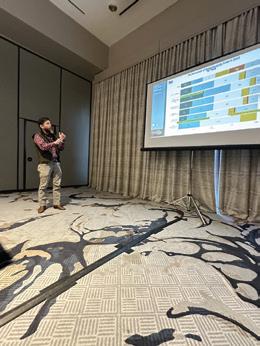
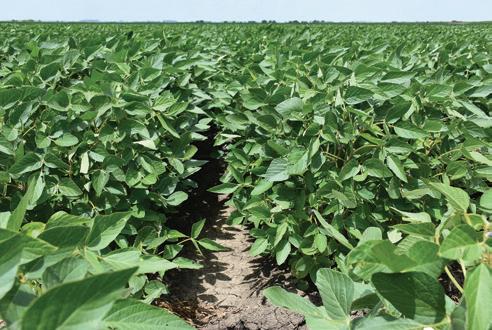
With applications ranging anywhere from $15 to 25 per acre, biologicals can be a costly input.
strips out in the field. Do not split the field, just run strips and watch the yield monitor at the end of the year.”
He suggests running three treatments. One with zero N-P-K (nitrogen, phosphorus, potassium) applied; one with only the biological product; and one with your normal soil fertility recommendations.
“What I think you will find a lot of times is there is a lot of margin there. We can reduce inputs a little bit, so do not allow someone to capitalize on that and sell you a product because of it,” Raper said.
Raper emphasized that farmers and researchers have been inundated with products from a biological standpoint. At one time, these products were developed by smaller mom-and-pop type companies. Now, bigger companies like Syngenta, Corteva, BASF, and Helena have entered the landscape.
“We have big money now in these microbials,” Raper said. “I really do believe there are some products that are absolutely going to provide a return on investment. Figuring out which ones is a real challenge for us.
“A lot of these products are not regulated. There may be 20 to 40 organisms in a jug, but we do not know if those organisms are alive or at what concentrations – or if they are even in the jug,” he explained.
Raper briefly reported on initial results of the Cotton Incorporated study that began in 2022. Researchers started with a list of over 50 products, acquired by request. Raper said the list quickly dwindled to six products that were evaluated at 22 locations.
At his location in Jackson, Tenn., Raper first looked at a nitrogen rate response curve on cotton, starting at 0 pounds of nitrogen and increasing to 40 pounds, 80 pounds, 120 pounds, and 160 pounds. He said the response curve from a nitrogen standpoint was typical,
and the 40-pound nitrogen application was used as a check.
Then, each of the six biological products were applied with 40 pounds of nitrogen. In the end, when compared to the 40-pound check, there was no significant difference in yield response.
“I am not saying these products do not work, but they did not work for us in Jackson. Maybe it is because we have not built the house, like Matt said, and we have to figure out what is going on,” Raper said.
Data will continue to be collected and compiled for all 22 locations. Overall, Raper reported a yield response at seven of those locations in the first year. He said, “The general trend is that the return on investment with biologicals is not necessarily straightforward.”
Story provided by Delta Farm Press.
BY RANEY RAPP raney.rapp@farmprogress.com
If harvest is equivalent to a Super Bowl for farmers, then winter is equivalent to the offseason – a time to rest and relax, or in the case of Cole Sheets’ family in Stuttgart, Ark., a time to hit the duck blind. While end of year tasks like tax planning and equipment maintenance might not be as exciting as off-season activities like chasing a pop star across the globe, they are an important way to simplify the coming growing season.
Farmers who harvested rice in 2024 keep an especially close eye on after-harvest assessments as rice continues to challenge the structural integrity and durability of equipment.
Rice has been a consistent crop for farmers in the Midsouth for many years, but changes in rice varieties have begun a unique cycle of wear and tear on farm equipment.
“Anywhere from 20 to 30 years ago, a new type of rice came out, which we call hybrid rice now,” said Sheets, a generational rice farmer and Brandt brand territory manager. “If you look at it under a microscope, they’ve got fine, sharp teeth all the way around it. And in August, if you walk through a rice field, and while rice is majority headed out, if you brush up on it it’s not going to make you bleed, but you can feel something rub against your skin.”
While essentially microscopic, those small changes in rice texture have caused big problems for equipment, especially during and after harvest.
“It absolutely will eat some stuff up,” Sheets said. “Particularly augers - augers in grain carts, augers in grain elevators, and augers in combines.”
Those textures don’t only cause more wear from abrasions, they also add stress to the overall structure of the auger by bulking up and blocking flow.
“The grains of rice get together and clump up, and it’s almost like a concrete brick when it gets clumped up,” Sheets said. “If you’re on top of a truck or a grain cart and you’ve got soybeans or corn in there, stick your hand in it and you can probably push your hand through as far as you want. But with rice, it’s so compact you’re not going to get maybe halfway between the tip of your fingers and your elbow.”
After harvest, especially for farms that harvested large quantities of rice acres or used grain carts heavily across many crop harvests without stopping for repairs, it can be important to give equipment a thorough check.
“A guy that farms 20,000 acres, he’s probably going to see more strain and more damage than a guy that farms 2,000 acres,” Sheets said. “But some of the farmers I talked to in the field, and some of my dealers that I work with, especially in grain carts say that lower and
upper auger that’s feeding into the truck - that’s probably going to be where the worst wear spots are getting worn out.”
For rice farmers, augers on storage bins, combines and trucks as well as grain carts could all need repair or replacement following a harvest season.
“With an auger, you’re probably going to be replacing mainly some bearings and the flighting itself,” Sheets said. “When that auger gets worn down, you can take it to a machine shop, or you can buy a new one - There’s no shame in that. If you take it to your local machine shop the majority of the time, they’ll be able to reflight it for you.”
Re-flighting is the process of recovering the interior of the auger to help the flow of grain to and from the combine, grain cart or truck. For some farmers, Sheets said repairing augers can happen one to three times in a harvest season or as infrequently as every three years.
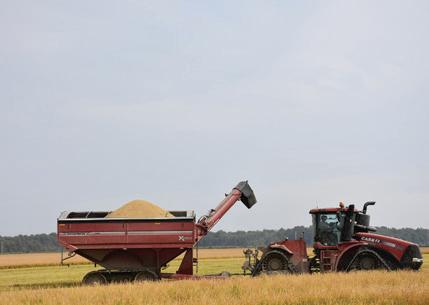


Weights inside augers serve as a wear point. Looking at wear in augers before harvest , especially in rice Is important to get the best capacity and flow efficiency possible. Weights in the green auger are circular, the red auger has been re-flighted by a machine shop and has square weights. (Photos by Cole Sheets)
For farms harvesting large quantities of rice, upgrading augers to chrome interiors or moving to a conveyor system can help limit wear and replacement frequency.
“You don’t see much damage in soybeans, maybe a little bit in corn as time and wear goes on, but it is nothing for a large rice farmer after harvest is over to look at replacing his augers in his grain cards, or in combines,” Sheets said. “If I’m selling, or my dealers are selling to a customer, and they farm rice, nine out of 10 times I can convince them to spend a little bit more money and buy a conveyor belt versus an auger.”
Sheets said conveyors are often $20,000 to $40,000 more expensive than augers depending on packages and options, but in most cases the use life of a conveyor system can be anywhere from double to five times that of a standard auger.
For farmers loyal to traditional augers, Sheets said chrome or even stainless flighting can also be a good option.
“In our grain carts, we offer a chrome package, where at the main where points of each end of the auger, it’s chrome flighted, and the chrome seems to help it last a little bit longer,” Sheets said. “I’ve had customers that are interested in stainless steel and would spend the extra money just so they could get some more wear out of it.”
While packages and options for a purchase like a vehicle might seem to be frivolous spending, product packages for grain carts or combines designed specifically for rice often contain adjustment to increase the use life of the product.
“A lot of companies, including Brandt, are coming out with rice-specific packages,” Sheets said. “They may cost a little more on the front end, but they offer options added on, to try to add extra wear and extra flow, to be able to make it last a little bit longer and work a little bit better. Because anybody that’s farming rice, knows exactly how tough it is.”
The changes, Sheets said, are due in part to companies discovering that rice can set a high standard for equipment quality and durability.
“If you build anything for rice, it’s going to work for any other crop,” Sheets said. “If you build it specifically for soybeans, or build it specifically for corn, it’s more than likely not going to work well for rice. But if you build something for rice, it’s going to work for anything.”
For checking and correcting equipment wear after rice harvest, now is the time, Sheets said.
“My family farms too and I know farmers have got a lot of things on their minds, and a lot of times they’ll wait till about a month before harvest to check the auger on the grain cart,” Sheets said. “Go ahead and check that stuff after harvest and get it out of the way, so you’re not trying to get it done last minute next year.”
Story provided by Delta Farm Press.
BY FORREST LAWS
Contributing Writer
Farmers and others caught up in the trials and tribulations of modern-day agriculture sometimes forget just how magical the process of putting seed in the ground and producing bushels or pounds of a crop can be.
Dawn Mellion remembers her first experience with growing plants when she enrolled in a crop production class after discovering her first choice for a college major – pre-med chemistry – wasn’t working out.
“The ag building was the next building over. I didn’t know anything about agriculture, but I knew it should be science, right?” she said. “I walked in, saw some people I knew and had an opportunity to talk to one of the professors. I signed up for a class in crop production, and it was really a good experience.”
In the class, she grew green beans. After the first harvest, she weighed the beans and, not realizing they were the same thing as string beans, threw them out. She had only seen canned vegetables up to that point.
“My professor asked what I did with the beans, and, after I told him I threw them away, he told me I should cook them. I said ‘OK.’ I brought the next batch of beans home, and, after my roommate, an engineering major, left, I cooked them. Then we had them for dinner,” she said.
“I got all these noble feelings,” she said. “If I could feed my roommate and my family with one row, if I had 10 rows, I could feed my neighborhood. If I had a hundred rows, I could feed the community. Thus, my lifelong infatuation with agriculture began.”
Mellion, who recently was named executive director of the National Black Growers Council, received her undergraduate degree in plant and soil sciences and her master’s degree in ag education at Southern University in Baton Rouge, La. She earned her Ph.D. in
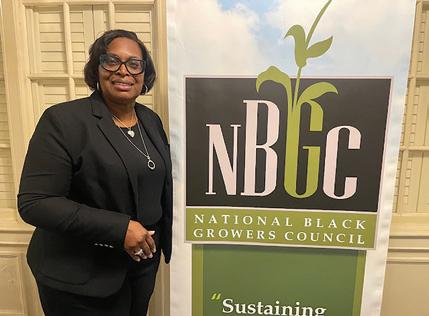
ag and Extension education at Iowa State University.
She returned to Baton Rouge and became assistant director of the Section 2501 program at Southern University. The 1990 farm bill created the 2501 Program to help underserved farmers, ranchers and foresters who have historically experienced limited access to USDA programs and services. The 2014 farm bill expanded it to include veterans.
She eventually became director of the 2501 program before moving into the Cooperative Extension Service at Southern. She started as an assistant specialist in the Agricultural and Natural Resources area. Then she became an associate specialist, and a full specialist before becoming vice chancellor for Extension and Outreach at Southern.
“The beauty of the Extension program at Southern or of Louisiana was that when I first started at Southern in 1995, the audience was primarily Black,” she said, “By the time I retired we had quite a few white farmers who relied on our programming.
“And what I realized was that farmers wanted relevant, timely information that could benefit them, and they didn’t care
where it came from. They just needed good solid information that was tailored to their needs, to help them stay in farming and get better at it.”
After her retirement, she became a catalyst for the Extension Foundation, which was formed in 2006 by Extension service directors and administrators.
“As a catalyst, I supported small teams at land-grant universities who had these novel ideas they wanted to pilot,” she said. “The Extension Foundation gave them small amounts of money to do a pilot program for their ideas.”
In 2022, USDA launched its “From Learning to Leading: Cultivating the Next Generation of Diverse Food and Agriculture Professionals or NextGen Program. NextGen is aimed at “enabling institutions of higher education to engage, train and support students to build the next generation of diverse food, agriculture, natural resources and human sciences professional, including the future USDA workforce.”
“When the USDA National Institute of Food and Agriculture released the program, they contracted with the Extension Foundation to provide technical assistance to the minority-serving institutions so they could write competitive proposals for the grants that became available,” she said. “I became the project director for the NextGen technical service provider opportunity.”
Mellion is planning to use her experience in helping minority and majority farmers in her role as executive director of the National Black Growers Council, which was organized in 2010 to advocate for the interests of Black farmers across the United States.
One of her first tasks was helping organize the NBGC’s annual meeting, which was held Dec. 10-13 in Charleston, S.C. Last year’s meeting in Memphis, Tenn., featured an address by Agriculture Secretary Tom Vilsack and was attended by several hundred Black farmers, industry representatives and state Department of Agriculture and USDA officials.
“The majority of our meetings have been held in the Delta region in the past,” she said. “By meeting in Charleston, it gives people on the East Coast better access to the location and our members in other regions a chance to experience the Carolina low country. We have

two tours of the area scheduled, including one of a tea farm.
“When I was an Extension specialist at Southern, I put together a leadership class for small farmers from the states with 1890s Historically Black College and Universities Land Grant institutions, and we would travel across the Southeast,” she said. “I believe one of those stops was at the Bigelow Tea Farm, which is quite unique in the U.S.”
She also has some 90-day and longer goals. “I think NBGC is a wonderful organization. In the book ‘Good to Great,’ Jim Collins discusses why some companies make the leap from good to great and others don’t. My vision for my tenure here is to leave NBGC stronger than I found it, to make it better than it was before my tenure.”
Story provided by Delta Farm Press.

BY STACEY GORMAN, Director of Communications, The Cotton Board
In recent years, global textile demand has faced significant challenges due to a mix of economic and political factors. Cotton, a staple of agriculture and the textile industry, has been directly impacted. To address these challenges and ensure a stable future for cotton, Cotton Incorporated is working hard to remind consumers why cotton matters and why it’s worth choosing.
Research by Cotton Incorporated shows that while people value cotton, they don’t often think about where it comes from or its importance in their daily lives. To change that, Cotton Incorporated has launched an innovative platform to help consumers connect with cotton in new and meaningful ways. By tapping into digital media, social conversations, and shopping trends, this platform ensures cotton stays part of the conversation on style, wellness, and sustainability. This approach signals a new era in how cotton is marketed, with a focus on fresh content and stronger connections between growers, producers, and end users.

recommendations—a critical factor in today’s digital landscape.

The driving force behind this effort is “The Fabric of Now,” a modern marketing platform built on Cotton Incorporated’s iconic tagline, “The Fabric of Our Lives®.” By combining TV, streaming, and digital ads with a robust social media campaign, the platform ensures cotton’s story reaches consumers wherever they are. Launched in 2024, this initiative is designed to show cotton’s relevance in today’s world while supporting its future demand.
Smart marketing means putting resources where they matter most. That’s why Cotton Incorporated focuses on consumers who are most likely to choose cotton and spread the word. The target audience for “The Fabric of Now” includes young, fashion-conscious individuals aged 18 to 34, with a demographic breakdown of 70% female and 30% male. This group values natural, high-quality products and tends to influence their peers by sharing reviews and
Extensive research shows this audience leads fast-paced, busy lives and craves personal connections in a world full of distractions. They’re also concerned about sustainability and making mindful choices. “The Fabric of Now” speaks directly to these concerns, reminding consumers that cotton is designed for the real world—perfect for spending time with family, friends, and community.
At its heart, “The Fabric of Now” encourages people to slow down and think about their choices. In a world of synthetic fibers and fast fashion, cotton stands out as a natural, breathable, and sustainable option. The campaign’s videos showcase moments of relaxation and connection—like curling up with durable cotton sheets or enjoying a phone-free dinner with friends—to highlight cotton’s role in a balanced, intentional lifestyle.
The campaign also uses relatable visuals to drive its message home. For instance, one ad features a lovable dog, a surefire way to grab attention, to showcase the comfort and durability of cotton products. Another shows a group of young adults enjoying a low-key evening together, free from digital distractions. These relatable scenarios reinforce cotton’s value in everyday life.
Anne David, Director of Advertising at Cotton Incorporated, emphasizes the importance of evolving alongside consumers. “We’re con-
stantly learning more about our audience and refining how we connect with them,” she says. “With an always-on approach, we’re keeping cotton top of mind and ensuring it remains the fiber of choice for generations to come.”
For cotton farmers, this effort is about more than just marketing; it’s about ensuring a strong future for the industry. By connecting with consumers in meaningful ways, Cotton Incorporated is driving demand and creating a market where cotton thrives. Every initiative—from raising awareness to encouraging purchases—is designed to support the entire cotton supply chain, from field to fabric. To learn more about Cotton Incorporated’s efforts and “The Fabric of Now” platform, visit cottonboard. org/consumers.

Materials provided by Farm Progress

The AGRI SPRAY DRONES 3M DJI MAVIC drone is a great fit for aerial surveying and field scouting, platform mapping and environmental monitoring. This drone features an RGB camera that is multispectral. It has efficiency in operating with a 42-minute maximum flight time. The company helps customers get all the training and certification needed to fly a drone. For more information, visit www.agrispraydrones.com

The BESTWAY T40 DRONE has a 10-gallon tank and 30-foot spray width and can carry a spray load of 88 pounds and a dry load of up to 110 pounds. The drone can cover about 40 acres per hour. The company works with customers to line up getting all the regulations for owning and flying a drone. The drones are available through Bestway dealers so customers have help when needed. For more information, visit www.bestwaydrones.com
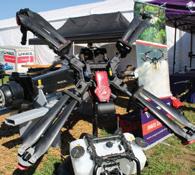
The XAG P100 PRO 2023 DRONE by Pegasus Robotic is the largest agriculture spray drone available for purchase. The drone is high performing, with its 70-acre-per-hour efficiency and 13.5-gallon liquid tank. Parts and service are also readily available, making for easy maintenance. For more, visit pegasusrobotic.com
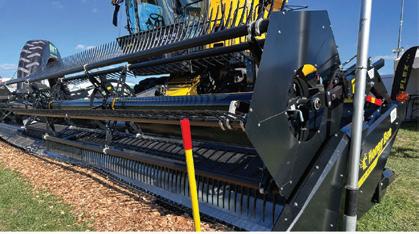
Farmers looking for a draper head have a new option in the HONEY BEE AIRFLEX NXT. By pressing an in-cab button, an operator can move from a close shave in the soybean field to a higher cut in cereals or canola. For the farmer who just needs a soybean machine, Honey Bee offers a one-crop model. Look to the AirFlex NXT for a fully flexible, air-controlled cutter bar; a reversible mechanical drive; and cab-adjustable skid shoes. Visit honeybee.ca

Built for hills and terraces, Geringhoff’s Folding ATF, for Adaptive Flex Technology, is the most flexible corn head on the market. ATF offers a foldable option, for maximum header transport between fields. It is available for purchase at any of Geringhoff’s 400 dealers across the U.S. Price depends on size and model; base 12-row options range from $280,000 to $340,000. Visit geringhoff.com.
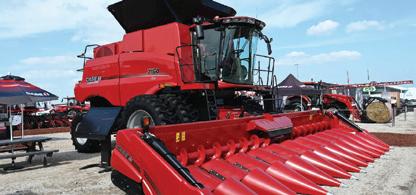
The CASE IH AXIAL FLOW 160 SERIES is a small- to mid-tier combine with a variable-speed feeder, 350-bushel grain tank and a new rotor speed that’s four times faster than previous models. It comes with 15 different sensors for seven different machine settings, all monitored by AFS Harvest Command and AFS Connect subscription. Operators can adjust for desired grain quality and maximum productivity. Visit caseih.com.

The TRIPLE GREEN BIODRYAIR GRAIN DRYER is a sustainable way to dry grain through the use of wood chips, pellets, grain chaff and crop residue as biomass, which helps eliminate costly fossil fuels. The system is easy to install and operate, and can be controlled and monitored from a cellphone. It can be hooked up to existing makes and models of grain dryers. Prices are based on size and the fuel being used. For more information, visit triplegreenproducts.com.

The MIGHTY GIANT CSE CONVEYER offers high capacity and quick action. The 48-inchwide conveyor can move products such as forage, grain, dry manure, rock or ground wood. It features user-friendly hydraulics and belt adjustments, a simple shield removal for easy cleanup, and dual manual jacks for easy leveling. Pricing for a basic model is $48,000, with the price increasing depending on customization and size. Visit mightygiant.com.

UNVERFERTH’S SIX-WHEEL STEER HEADER
CART is designed to move today’s heavier heads and grain platforms with more stability and maneuverability. It features a walking tandem rear axle and oscillating frame, with a 14-foot turning radius and a front-axle-mounted suspension. The cart is available in 52-, 48- and 42-foot models, with adapter kits for various brands. The 52foot models list for $30,200. For more, visit umequip.com.

Chief introduces a BIN ROOF DESIGN that can be retrofitted to most manufacturers’ bins. the new roof is made for both structured and unstructured units, incorporates a stair-step in the side slopes, and has subtle corrugations in the pan to enhance strength. The roof design can be retrofitted onto most manufacturers’ bins, as long as it is unstructured. Go to agri.chiefind.com.

The new KUBOTA LX 20 SERIES tractor is designed to offer higher horsepower in a compact size, making it especially good for blowing snow, mowing or performing other jobs. It features new Tracloader II R4 tires by Titan and improved comfort features in the cab. The tractor comes in 20 hp, 35 hp or 40 hp, with the 35-hp model offering a narrow option. The base price on the 40-hp model with a cab, but no loader, starts at $39,771. Visit kubotausa.com to configure and compare.

JOHN DEERE’S 4075R is a brand-new utility tractor. The 4075R at 75 hp is a sleek, powerful compact utility tractor, capable of handling a heavy-duty loader or a snow blower, as pictured. Its heavy-duty front axle can handle any job that comes its way. Like others in the lineup, the 4075R features an electro-hydraulic rear hitch control for repeatability in operation. Visit deere.com.

The CLAAS XERION 12.590 is shown as a wheel-drive model, offers 590 hp. The Claas 12 Series becomes the largest fixed-frame, 4-wheel drive tractors on the market. The cab is 20% bigger, with more noise barriers built in for a quiet, comfortable ride. Visit claasofamerica.com.

The C ASE IH STEIGER 715 QUADTRAC is the most-powerful Steiger ever built, rated at 715 hp with a max 778 hp. For better traction and flotation with less compaction, the machine features a heavy-duty undercarriage to increase track length and drive-wheel diameter. The redesigned cab, including 27% more LED lighting, offers better visibility. Maximum road speed is 26.5 mph, and the new 16-liter engine can increase speed and offer 23% more displacement to pull equipment faster with the same fuel requirements. Visit caseih.com.
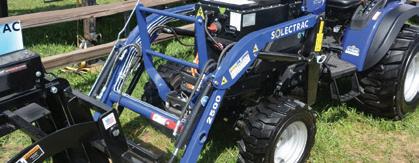
Solectrac Inc. introduced the e25G COMPACT ELECTRIC TRACTOR in 2022. It’s a 25-hp, 4wd tractor that recharges in 5.5 hours from a standard 220-volt outlet. And now Solectrac offers a more economically priced loader for the tractor. The heavy-duty loader is also still available. At press time, Solectrac included the economy loader free with purchase of a e25G tractor. List price for the tractor alone is $25,000. Call 866-219-6750 or visit solectrac.com.

NEW HOLLAND’S MODEL-YEAR 2024 T9 features several upgrades to the 4-wheel drive machine, coming in six models from 467 to 699 hp. With improved operator ergonomics and tech upgrades such as dual IntelliView displays, all T9 tractors feature an FPT Cursor 13-liter engine for higher power with both single-stage and two-stage turbos. The machines are available with wheels or tracks. Visit agriculture.newholland.com.

All States Ag Parts of De Soto, Iowa, offers the Jaltest diagnostic tool for tractor computers. This particular model connects to a laptop and will read 51 different tractor brands’ codes, as well as over-the-road semis and more. The system will help you diagnose the issue and tell you which sensor may be at fault. Learn more at tractorpartsasap.com.

The new KUBOTA LX 20 SERIES tractor is designed to offer higher horsepower in a compact size, making it especially good for blowing snow, mowing or performing other jobs. It features new Tracloader II R4 tires by Titan and improved comfort features in the cab. The tractor comes in 20 hp, 35 hp or 40 hp, with the 35-hp model offering a narrow option. The base price on the 40-hp model with a cab, but no loader, starts at $39,771. Visit kubotausa.com to configure and compare.

The TILLER BRAVUS FROM GTS is a threein-one tillage tool that shreds, incorporates and levels the ground. The high-speed disk runs from 7 to 13 mph. It’s available in five models: the A15, A20, A25, A30 and A35, ranging from 15 to 35 feet, with working width ranging from 244 inches to 492 inches. Required horsepower ranges from 180 to 400. For more information, go to gtsdobrasil.ind.br/en/empresa

The VT110 TURBO MAX from Great Plains is a relaunch of the company’s Turbo Max vertical tillage machines. This new machine comes with 22-inch blades, rolling spike harrow and an optional chopper reel to get through heavy corn residue. The VT1100 is offered in 20-, 25-, 30-, 35- and 40-foot versions. It also comes with a dual basket on the back for better finishing as well as a round bar that works well to break up clods in the soil. For availability, go to greatplainsag.com.

DALTON AG PRODUCTS will offer a 12-toncapacity Mobility fertilizer spreader with a removal box that is constructed of 409 stainless steel for longer life. Standard are 46-inch wheels, with duals and flotation tires optional. There is up to 45 inches of ground clearance under the spinner and up to 37 inches of clearance under the frame. Product can be spread in up to a 90-foot pattern. A retractable roll tarp and light kit are standard. Visit daltonag.com

Stinger Equipment, based in Buckner, Ky., offers the small-scale GATEWAY FERTILIZER APPLICATOR with a 22-gallon tank and a removable 150-pound hopper. The Gateway has an application width of 8 to 10 feet and can treat up to 4,800 square feet per minute. A one-touch, digital control system simplifies operator inputs and eliminates operator errors. Visit https://www.stingerequipment. com/gateway-applicator/https://www. stingerequipment.com/gateway-applicator/.

The DAWN STRIP-TILL TOOLBAR allows people to get the complete implement in a 30- or 60-foot option. At the same time, Dawn is open to customization for size. The company wants to become a one-stop shop for farmers to be able to get a strip-till unit. Price will vary depending on the setup for each farm operation. For more information, visit www.dawnequipment.com

The MASCHIO GASPARDO PRIMO DRY FERTILIZER SPREADER is available in three versions: Primo M with manual distribution control, Primo E with continuous electronic distribution control and Primo EW with electric distribution control and continuous weighing. This spreader has section control and is available through a dealer network across the country.
Visit maschiogaspardo.com.

From the music of Beale Street to Graceland, Memphis offers a seemingly endless array of entertainment options. The city is filled with unexpected fusions: high culture and outdoor adventure, soul food and haute cuisine, world-class infrastructure and greenways, rich heritage and forward thinking.
Memphis Rock ‘n’ Soul Museum, 191 Beale in the FedEx Forum. — The story of Memphis music is about people connecting: black, white, rich, poor, country folk, and city folk. And no place better dramatizes and organizes the cultural and social ramifications of Memphis’ musical connection to the world than this Smithsonian-crafted, seven-gallery chronicle. American Songwriter magazine calls the Rock ’n’ Soul Museum perhaps “the single best exhibition of American musical history in the country.” For current days and hours of operation, go to www. memphisrocknsoul.org.
Sun Studio, 706 Union. — Ground zero for rock ’n’ roll’s explosion, Sam Phillips’ studio is packed with memories and memorabilia, allowing visitors to experience the stories that put legends like Elvis Presley, Johnny Cash, Carl Perkins and Jerry Lee Lewis on the map. 901-521-0664.
Stax Museum of American Soul Music, 926 E. McLemore Ave. — This 17,000-square-foot museum houses over 2,000 cultural artifacts, celebrating the music made famous by Otis Redding, Booker T. and the MGs, Isaac Hayes, Al Green and many more. Tour time 1½ hours. 901-261-6338.
Elvis Presley’s Graceland, 3717 Elvis Presley Blvd. — No musical pilgrimage would be complete without a trip to the second most popular home in America. The legendary empire takes visitors back in time to see how Elvis lived, touring his private jets, automobile collection, the legendary Jungle Room and more. 901-332-3322.
Beale Street — Home to the best live blues, R&B and rock anywhere, Beale Street Entertainment District is a must-see and includes W.C. Handy House, B.B. King’s Blues Club, Rum Boogie Café, Alfred’s Bar & Grill on Beale and over 26 restaurants, clubs and shops.
W. C. Handy House/Museum, 352 Beale. —William Christopher (W.C.) Handy’s modest Beale Street home-turned-museum may be small, but it quietly captures the flavor and spirit of Old Beale like no other place on Earth. 901-527-3427.
Old Dominick Distillery, 305 S. Front St. — Join the Old Dominick Distillery team and Domenico Canale’s spirit, while we share with you our stories, our traditions, give you a full tour of our extensive grain to glass spirit making facility and take you through a 45-minute sensory journey. We’ll finish with a tasting of Old Dominick’s fine spirits and a toast. 901260-1250.
Mighty Lights — Experience the biggest nightly light show on the mighty Mississippi River. See it in all its shining glory at the top of each hour after sundown until the 10 p.m. finale. Thousands of LED lights
Continued on next page

Do the lights on the Memphis bridge. Photo by Janice Person.
illuminate Big River Crossing and the Hernando de Soto Bridge in a dazzling and colorful light show that is visible from the riverfront from Beale Street Landing to Fourth Bluff, as well as elevated locations throughout Downtown Memphis including the rooftop bar at the Hu. Hotel and The Lookout restaurant and bar atop the Bass Pro Pyramid.
Backbeat Tours, 197 Beale St. — Led by Memphis musicians, Backbeat Tours provides a rocking ride through Memphis music history in their vintage 1959 GM transit bus, “Miss Clawdy.” 901- 527-9415.
Memphis features entertainment for just about any taste, from waddling ducks to touring Broadway shows.
Bass Pro Shops at the Pyramid, 1 Bass Pro Dr. — Visit the largest retail space for a single retailer in the world, and immerse yourself in this outdoors-man’s paradise. Pick up a few things in the retail shop, dine and bowl at Uncle Buck’s Fish Bowl, or get a picture-perfect view when you take the largest free-standing elevator in the country to The Lookout atop the Pyramid.
Metal Museum, 374 Metal Museum Dr. — Where art is made, not just displayed. The only museum in the United States dedicated exclusively to the exhibition and preservation of fine metalwork. 901-774-6380.
FedExForum, 191 Beale. — In the heart of downtown, is home to the Memphis Grizzlies NBA team and the University of Memphis Tigers basketball team.
Downtown Shuttles — Memphis Area Transit Authority shuttles operate along Mid-America Mall and other downtown areas. Stops are convenient to most downtown restaurants and attractions. Schedules/fares are posted at stations.
Peabody Ducks, Peabody Hotel, 149 Union.— In the 1930s, Peabody Hotel general manager Frank Shutt placed his live hunting decoys in the lobby fountain, starting a tradition. At precisely 11 a.m., the ducks arrive, marching on their own red carpet to Sousa’s “King Cotton March.” The show repeats at 5 p.m. Due to COVID-19 restrictions, the Duck March is currently open only to hotel residents.
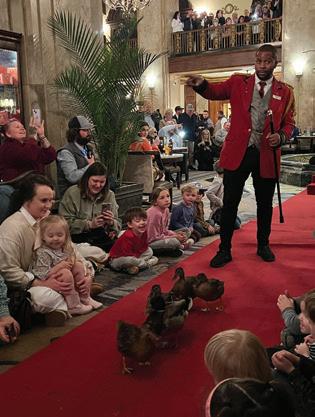
A nine-acre area along Front Street played a dominant role in the history of cotton in Memphis. Designated as the Cotton Row Historical District, many of the structures that housed cotton’s movers and shakers remain, some still engaged in the business of cotton.
The Cotton Museum is on the first floor of the Cotton Exchange, at 65 Union Ave. When you step inside the Cotton Museum, you’ll have an experience once reserved for a privileged few. You can stand in the very phone booths used by legendary cotton men — and hear stories about everything from the cotton fields to Front Street. Exhibits include an authentic Western Union telegraph office, used to constantly update the merchant offices down the block.
Ten feet off the floor is a massive trading board, with 1939 prices hastily scribbled in chalk. Look higher, and you can see the story of cotton in pictures, as told in a 135-foot custom mural created by renowned Memphis artist David Mah.

There’s more to hear and see on the floor itself, reading, studying artifacts, and viewing video. You’ll be surprised how this downy white fiber has weaved its influence into your life and world. Exhibits include: The Story of Cotton; The Society of Cotton; Cotton in the South; Music and its Cultural Impact; Cotton To-day; Technology of Cotton; The History of Front Street; and The History of the Memphis Cotton Exchange.
The building housing the museum was built in 1924 by the Memphis Cotton Exchange. The first
two floors are still owned by the cotton trading organization. Calvin Turley is president of the museum’s board of directors. The exhibit is open from 10 a.m. to 5 p.m., but is receptive to staying open longer during the Gin Show.
If you have a group of 12 or more, you can enjoy special discounted rates when you book in advance. The museum can also arrange a guided tour. For more information, call 901531-7826.
Cotton Exchange, 84 South Front. — The first and second Exchange buildings were at Madison and Second Street. The Cotton Exchange was moved to its present location on Front Street in Cotton Row in 1924.
Armistead & Lundee, 66-70 South Front. — This former cotton office is now an apartment building.
Reichman-Crosby Co., 60 South Front. — One of the most architecturally ornate cotton offices on Front Street.
Mid-South Cotton Growers Association, 44 South Front. — Formed in 1931, this organization helped farmers receive loans during the Great Depression. The association ceased operations in 1977.
Shrine Building, 66 Monroe. — Before this building was constructed, this site was the location of Orgill Brothers and Company, founded around 1862. The company supplied equipment for settlers and farmers.
Howard’s Row, 35-49 Union. — The south side of Union has some of the oldest commercial buildings in the city. The block housed cotton brokers and merchants from around 1843 to 1928. The building at 45-47 Union may have served as a hospital during the Civil War.
Oliver Building, 99-103 South Front. — The last of many seed and feed stores which were established on Front Street.


The choices in where to get dinner, drinks or a cup of coffee are nearly limitless in Memphis! With a range of small, locally-owned cafes and restaurants and major chains too, you can find just what fits your mood and taste buds.
With the Mid-South Farm and Gin Show in the heart of downtown, and great places within walking distance or a short shuttle/taxi ride of restaurants and nightlife, you can consider venues near the show, FedExForum, Beale Street, Overton Square, Cooper Young or beyond.
Here are some of the favorite local restaurants within a short distance of the Memphis Convention Center.
Amelia Gene’s, 255 S Front St. – Incredible meals, cocktails and service come together for dinner. Reservations encouraged.
Arcade Restaurant, 540 S. Main. — Memphis’ oldest café offers family-style cooking, especially famous for breakfast and brunch.
Automatic Slim’s Restaurant, 83 S. Second. — Memphis meets Manhattan. Southwestern and Caribbean-inspired cuisine.
The Blue Monkey, 513 S. Front St. — The place to go for good food and good drinks in a comfortable atmosphere. A great place to get the real feel of Memphis. Custom-built back bar and loads of artistic appeal.
Brass Door, 152 Madison Ave. — Downtown Irish pub, serving breakfast, lunch and dinner in a relaxed atmosphere.
Capriccio Grill, Peabody Hotel, 149 Union. —Flavorful U.S. prime steaks, fresh seafood, and savory Italian dishes. Classic cuisine with a distinctive Italian twist.
Central BBQ, 147 E. Butler Ave. — Voted No. 1 BBQ in Memphis for award-winning, mouthwatering pulled pork, hot wings and more.
Chez Philippe, Peabody Hotel. — 149 Union Ave. Four-star gourmet restaurant.
Earnestine’s and Hazel’s, 531 S. Main. — The greatest dive in Memphis, live music often. Delicious Soul Burger.
Flight Memphis, 39 S. Main. — Flights of wine and fancy meals.
Flying Fish, 105 S. Second. — Main selections are fresh catfish, shrimp, oys-ters, and
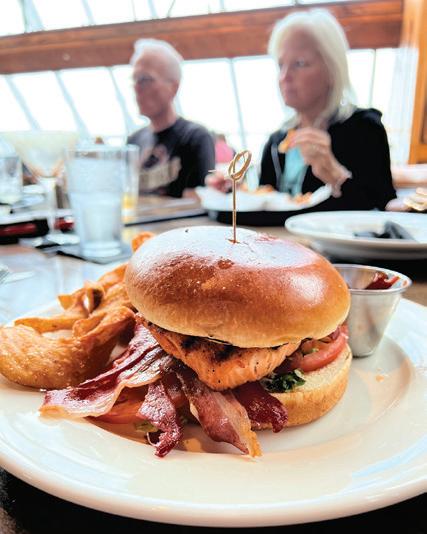
specialties that include salmon, trout, or tilapia.
Flying Saucer Draught Emporium, 130 Peabody Place. — Large selection of handcrafted beer. “Out of this world” eclectic menu designed to be washed down with “brews from other planets.”
Gus’s World Famous Fried Chicken, 310 S. Front. — A Memphis favorite for hot and spicy fried chicken.
Hooter’s, 250 Peabody Place. — Delightfully tacky and unrefined. Great chicken wings, sports on TVs.
Huey’s Restaurant, 77 S. Second. — Winner of “Best Burger in Memphis” year after year. Live music Sunday afternoons and live blues bands
Sunday nights.
Kooky Canuck, 87 S. Second. — Home of 4-pound burger, “The Sas-quatch.” Eat it in less than an hour, all by yourself, and it’s on the house.
Local Gastropub, 95 S. Main. — Chefinspired twists to favorite menu items. Delicious food from burgers and lobster tacos to fish n’ grits and chicken with sweet potato waffles.
The Lookout at the Pyramid, 1 Bass Pro Dr. – Amazing views of the river from the top of the pyramid as well as great food and service.
Majestic Grille, 145 S. Main. — Flatbreads (another word for tasty pizzas), plus burgers and sandwiches.
McEwen’s, 120 Monroe. — Great food, sophisticated, down-to-earth atmosphere.
Rendezvous, 52 S. Second. — Dry-rub ribs are a specialty.
Rumba Room, 303 S. Main. — Mission is to introduce Latin culture to the greater Midsouth through food, music, dance.
Silly Goose, 100 Peabody Place, #190. — Downtown cocktail lounge.
South of Beale, 345 S. Main St. — Memphis’ first gastro-pub, serving fresh local ingredients and creative cocktails.
Texas de Brazil, 150 Peabody Place. — Carvers serve choice cuts of meat.
Wahlburger’s Wild, 1 Bass Pro Dr. – Wellknown nationally chain with some unique wild signature items.
One of America’s most famous streets, Beale Street offers a variety of dining experiences, plus live entertainment venues, and features a statue of W. C. Handy. His home sits at the corner of Beale and Fourth.
Alfred’s, 197 Beale. — Full-service bar, casual dining, live music and lots of fun.
B.B. King’s Blues Club and Restaurant, 143 Beale. — The world’s premier blues address. Live blues nightly.
Beale St. Tap Room, 168 Beale. — Cold beer. Blues City Cafe, 138 Beale. — Old school juke joint & eatery. Homemade hot tamales, shrimp, ribs, catfish, burgers, steaks.
Coyote Ugly Saloon, 326 Beale. — Could be the most famous bar on the planet thanks to the movie. In the heart of Memphis’ famed Beale Street.

Dyer’s Burgers, 205 Beale. — Burgers and shakes. A Memphis original.
Itta Bena, 145 S. Beale (3rd level of B.B. King’s Blues Club). — Tucked away behind a hidden door awaits a warm, friendly place to eat, drink, and have fun in an authentic Beale St. environment.
King’s Palace Cafe, 162 Beale. — Shrimp and crawfish etouffée, live blues and jazz.
Mr. Handy’s Blues Hall, 182 Beale. — The last real juke joint on Beale Street. Inside Rum Boogie Cafe. Live music seven nights a week. Open for dinner.
Pig on Beale, 167 Beale. — Pork with an attitude. Memphis-style ribs.
Rum Boogie Cafe, 182 Beale. — Memphis blues and Cajun cuisine, chicken, and barbecue. Guitar collection of world-famous musicians.
Silky O’Sullivans, 183 Beale. — Piano sing-along. Large patio with live goats. For the Irish in you.
Wet Willie’s on Beale, 209 Beale. Entertainment with live bands and DJs on the weekend; a variety of food.
One of the oldest sections of the city, the Pinch district was settled by Irish immigrants in the late 1800s. Now it is known for its restaurants, night-spots, and antique shops. The trolley stops right in the heart of it.
Alcenia’s, 317 N. Main. — Home cooking, fried green tomatoes, southern-style breakfast.
Comeback Coffee, 358 N Main St. – Locally owned and operated coffee shop with swagger.
Kinfolk, 111 Harbor Town Square on Mud Island – After years of popups, this Southern cooking has a permanent home for breakfast and lunch. Whether you crave biscuits and gravy or pancakes, you will love your fill here.
Westy’s, 346 North Main Street. — Fullservice restaurant with sandwiches, Creole dinners, burgers, wild rice dishes, and hot fudge pie.

Babalu Tacos & Tapas, 2115 Madison Ave. — Southern-influenced tacos, tapas and cocktails.
Bosco’s Restaurant and Brewing Company, 2120 Madison Ave. — Hand crafted beer, wood-fire pizza, fresh fish, steak and sandwiches.
Crosstown Concourse, 1350 Concourse Ave. – Not sure what you want, check out a combination of local eateries in Crosstown. From fried chicken to Vietnamese, burgers to baked items, you’ll find lots of options.
Lafayette’s Music Room, 2119 Madison Ave. — Indoor/Outdoor music club with vintage vibe and live music 7 nights a week.
